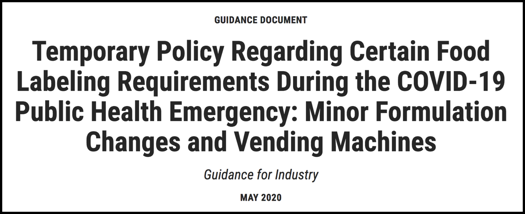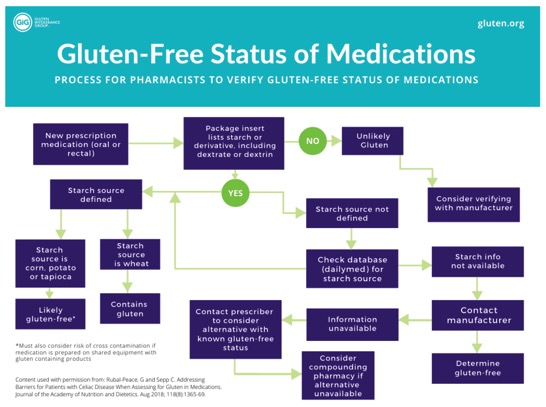Wheat Starch Info Round Up
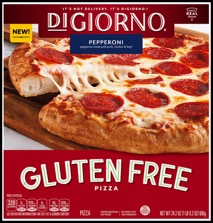
You’ll need a variety of facts to make an informed decision to determine if wheat starch is right for you. I’ve gathered up some information from trusted resources to help you understand.
Wheat starch has been used in gluten-free products for decades - in some parts of the world - but not here in the USA.
Elaine Hartsook, dietitian and original founder of the Gluten Intolerance Group, approached Ener-G Foods about their Low Protein bread. According “Our Story” on Ener-G’s website, “Elaine Hartsook, R.D., whom I hadn’t previously met, came into the office and complained that we were “killing” her patients with our wheat starch bread.” Elaine discovered that celiac patients were purchasing and consuming this Low Protein bread developed for dialysis patients. Ener-G reports this bread probably contained less than 20 parts per million of gluten. Dr. Cyrus Rubin, inventor of the Rubin Biopsy Tube and professor of Gastroenterology at the University of Washington and his dietitian - yep - Elaine Hartsook met with Ener-G and asked them to develop a gluten-free bread without using wheat starch. By 1978, Ener-G created probably one of the first (only?), commercially available gluten-free breads.
Things to know about wheat starch:
- Wheat starch IS allowed to be included in foods labeled gluten-free as long as the final product contains less than 20 parts per million.
- The FDA considers it an ingredient processed to remove gluten.
- The FDA states: “Wheat starch, when properly manufactured, does not involve hydrolysis of the gluten and can be protein-free.
- A 2014 study out of Germany - Wheat starch has been shown to contain a wide range of gluten: from less than 5 parts per million to over 10,000 parts per million - depending on the processing.
Information about Wheat Starch
Excerpts from “3 Tips for Gluten-Free Label Reading”A product that is labeled gluten-free may include the term “wheat” in the ingredient list (such as “wheat starch”) or in a separate “Contains wheat” statement, but the label must also include the following statement: “The wheat has been processed to allow this food to meet the Food and Drug Administration (FDA) requirements for gluten-free foods
If “wheat starch” is an ingredient in a GFCO–certified product, the wheat has been processed to such an extent that the food meets the GFCO standard of 10 ppm or less gluten.
About Wheat Starch
Someone allergic to wheat should avoid wheat starch. For someone avoiding gluten, wheat starch could contain gluten unless it is in a product that is certified or labeled gluten-free. In that case, the gluten in wheat starch has been processed out. As long as the product is certified or labeled gluten-free, it is safe for someone avoiding gluten.
Anytime information is needed, you folks know that I’m going to include Tricia Thompson, MS, RD. Without further ado…
Tricia Thompson, MS, RD of Gluten-Free Watchdog
Excerpts from “Does Wheat Starch Belong in a Gluten-Free Diet?”
May 2017Wheat starch is not wheat grain and it is not wheat protein. It is not intended to contain any gluten. BUT it is very difficult to completely separate the starch and protein components of wheat so small amounts of gluten remain in the wheat starch. Not all wheat starch is created equal. Depending on the extent of processing wheat starch will contain varying amounts of residual gluten.
In 2008 I wrote the following on wheat starch (from the Gluten Free Nutrition Guide, McGraw Hill):
“… If a manufacturer of wheat starch or products containing wheat starch demonstrates through testing that its products contain less than 20 parts per million of gluten, then in theory I support their consumption by people with celiac disease.”BUT more is known today about testing wheat starch for gluten than was known 10 years ago
Updated opinion on wheat starch…
Because of the current limitations associated with testing wheat starch for gluten, it is the opinion of Gluten Free Watchdog that products containing wheat starch are best avoided by individuals with celiac disease.
That said, if you have celiac disease or another gluten-related disorder and you would like to eat wheat-starch based foods, it is the recommendation of Gluten Free Watchdog that you do the following:
Eat foods containing wheat starch only if the product is labeled gluten-free.
Establish with the manufacturer that the final product is tested using both a sandwich and competitive ELISA.
An interesting article was published by Van Waffle on GlutenFreeLiving.com in February 2015. Van’s article offers a good bit of history and background information on wheat starch. Included in the article are the thoughts and advice of a number of trusted experts in the gluten-free community. You’ll notice different perspectives on this ingredient.
GlutenFreeLiving.com • Van WaffleExcerpts from “The New Word on Wheat Starch”February 2015Products made with gluten-free wheat starch are absolutely safe, says Cureton, even for people with particularly high sensitivity to gluten. Wheat starch contains such a tiny amount of gluten that it doesn’t significantly add to the gluten level in the final product. But consumers have to continue to read labels, understand what they mean, and make sure anything containing wheat starch also identifies itself as gluten-free and says that the ingredient has been processed to remove gluten.
Wheat starch in a gluten-free food may come as a surprise to U.S. consumers, but it has an established record in Europe where Dr. Schär has used it for at least 20 years, according to Anne Lee, R.D., director of nutritional services for the company’s U.S. operations in Lyndhurst, New Jersey.
Research has found no evidence that foods containing gluten-removed wheat starch harm people with celiac disease. A 2003 study at Tampere University Hospital in Finland tracked newly diagnosed patients after they adopted a gluten-free diet.
In recommending wheat starch, the authors of this study argued that minute contamination of less than 20 ppm of gluten is virtually impossible to avoid in any diet. International standards have accepted this level because it’s considered safe for the vast majority of people with celiac disease.
But some experts express skepticism. “I would not expect to see gluten-free wheat starch approved in Canada in the near future, but if the experience is a positive one in the United States, there may be a review of the situation in the mid to long term,” says Sue Newell, operations manager for the Canadian Celiac Association.
While wheat glucose syrup, wheat-based caramel and wheat maltodextrin—gluten-free derivatives allowed by Canadian labeling law—occur in food only in small fractions, wheat starch could contribute a higher proportion to the final food product, Newell notes. And she worries about the cumulative effect from traces of gluten in wheat starch when added to unavoidable gluten from cross-contamination.
The Celiac Disease Foundation supports the legislation allowing wheat starch, however. “The FDA went through a vigorous consulting process with the national groups in celiac disease, both medical and scientific, and this was the consensus: that wheat starch that has been processed to remove gluten to the FDA standard is safe for the celiac disease population,” says Marilyn Geller, chief executive officer of the foundation.
Authors of the Tampere University Hospital study point out wheat starch’s benefits. Compliance with a gluten-free diet is more important to recovery than avoiding trace amounts of gluten, they say. Because wheat starch improves the flavor and texture of certain foods, it can mean the difference in some people’s ability to accept such a difficult diet.
Schar has been a trusted and respected name in gluten-free community for decades. Currently, in the U.S. their Gluten-Free Croissants are made with wheat starch.
Schar.comExcerpts from “What You Should Know About Gluten Free Wheat Starch”Wheat Free vs. Gluten Free
One thing to keep in mind when talking about wheat starch versus wheat flour is that gluten free does not necessarily mean wheat free, and vice versa. Remember, wheat starch is made from the same grain as wheat flour, it just goes through extra processing. This means that people who are intolerant or allergic to wheat – even if they are not sensitive to gluten – could have a negative reaction.
What Gluten Free Products Use Wheat Starch?
Although gluten free wheat starch has been approved by the FDA, there is still a great deal of skepticism about it. It may comfort you to know, however, that the use of wheat starch in gluten free foods has been rigorously tested. In fact, Schär has been using it for over 20 years. When gluten free wheat starch enters the Schär facility, it goes through additional testing using the ELISA method to ensure it meets standards. In fact, more than 90% of the wheat starch Schär uses tests below 5ppm..”
Research has shown no evidence that foods made with gluten-removed wheat starch are harmful to people with celiac disease.
The Bottom Line
The truth of the matter is that it is entirely your choice which food products you do and do not eat.
For the most part, wheat starch can be considered a safe ingredient as long as it is labeled gluten free. You still need to do your due diligence in reading food labels, but as long as a product is certified gluten free it is safe to eat.
I’ve thrown a lot of information at you. Hopefully, there is enough here for you to make an educated choice.
Alan Klapperich - Branch Manager
Think SMALL

I imagine this sight would be very daunting to an ant as she climbs up this lofty tree. It must seem like an impossible journey.
Do you ever feel like an ant? Where you feel so small, and everything around you seems so large and overwhelming? The tasks you must complete are too complex and too many to count? The knowledge you currently possess feels grossly inadequate? Yeah, me too.
Similar feelings can happen when reality sets in after the doctor gives you a gluten-related disorder diagnosis. You now have an answer for your sickness, but it sets off a rapid-fire chain reaction of questions. What is gluten? What can I eat? What can't I eat? How will I manage work and social functions? What if I don't feel better? What will friends and family think of me? The questions keep coming, and the meltdown begins.
After my Father-In-Law passed away in 2010, we needed to clean out his garage and shop. He was an electrician but also performed home renovation projects. Over his lifetime, he accumulated a lot of "stuff." I saw stuff stacked on stuff, piled on...more stuff. My gosh, where do I start?
"Pick one and look at the others," came down from the heavens. This phrase was my Father-In-Law's advice when deciding upon a card to throw down while playing the card game Sheepshead. Thanks, Lester! Okay, I'll pick one area of the shop and work it until it's clean. Rinse and repeat to the tune of almost 20,000 steps to the dumpster. Whew, I survived Day #1.
A journey of a thousand miles begins with a single step
Let's say you have a goal of running a marathon. Going from the couch to 26.2 miles in one day will bring on a world of hurt. You're setting yourself up for failure before you start. Just getting around the block will be an accomplishment. After the first 100 yards, it'll feel like you're suffering a myocardial infarction (you might be after logging all those extensive couch miles). Out of breath and clutching your chest, you'll say, "
Sometimes seeing the expanse of the big picture is paralyzing. There's so much for the brain to process. Out of frustration, you shut down; you lose focus, you lose motivation. Finally, you give up.
Do. Or do not. There is no try.
When it comes to being gluten-free, giving up is not an option - not if the goal is to rebuild your life and health. What if we approach this gluten-free journey differently? What if we narrow our focus and think small?
But how can we achieve this goal by thinking small?
It is the small changes you make that will add up to something bigger. But in this case, small doesn’t mean easy. It requires focus, dedication and effort that, over time, will start to pay off.
When you take a trip, you fire up your GPS app. To start the journey, you enter the destination. After pressing Go, you follow the turn-by-turn directions the GPS feeds you. Your focus is on executing that one command. Then you wait for the next direction, the next lane change, the next turn, the next exit, the next gluten-free snack. [Gotta eat on a road trip, right? Remember to pack your gluten-free cooler!] One-by-one, you reach your journey's way-posts. Before you know it, the destination is on your left. I think you can see where we're going with this.
Do not sell yourself short - you can rock this. When you have a long-range goal in mind, like executing a gluten-free lifestyle, map out a plan to get you there. The key is breaking it into small, manageable goals. How small? Things you can easily accomplish monthly, weekly, daily, hourly, or by the minute if need be. Each breath, each thought, each action brings you closer. Those small successes may not seem like much. Yet, they compound to build the motivation, confidence, and momentum required to propel you forward.
Andy Stumpf, a retired Navy SEAL and SEAL instructor with a decorated 17-year military history asked SEAL candidates why they quit during their training. He discovered they were often overwhelmed even though they had lifelong goals to be an elite SEAL. Stumpf maintains they didn't keep their world small enough.
Stumpf suggests, "Don't look at Hell Week as a five-day pipeline. Just make it to your next meal, because they have to feed you every six hours. Get to the next meal, get a mental reset, and keep stacking those six hours segments. If you apply that resilience and approach to your goals, you can accomplish an insane amount."
This concept is pure brilliance! So many situations can benefit by using this mind-set. I use it almost daily. If it can get someone through SEAL training, it can make you successful in executing the gluten-free lifestyle and beyond.
There is only one way to eat an elephant, one bite at a time.
Desmond Tutu puts an elegant spin on an African proverb on dealing with an elephant in your path. There is no question about it; transitioning to gluten-free is a big elephant in your way, but you can handle it, one step at a time! The Gluten Intolerance Group has an outstanding how-to guide.
"Getting Started on a Gluten-Free Diet: A Step-by-Step Guide” consists of these five basic steps:
Step 1: Learn What Foods to Include or Avoid
Step 2: Carefully Read Food Labels
Step 3: Explore Gluten-Free Goods
Step 4: Watch Out for Cross-Contact with Gluten
Step 5: Join a GIG Support Group
To learn more, read the article: http://bit.ly/GIG-GF-StepByStep
FDA Temporary Labeling Requirements During COVID-19
On the evening of Friday, May 22nd 2020, the FDA issued new guidance relaxing the requirements around the labeling of ingredients due to the supply issues caused by the COVID-19 pandemic. As one might expect, this rocked the world of those with food allergies as well as those with gluten-related disorders. “FDA is issuing this guidance to food manufacturers to provide temporary and limited flexibilities in food labeling requirements under certain circumstances. Our goal is to provide regulatory flexibility, where fitting, to help minimize the impact of supply chain disruptions associated with the current COVID-19 pandemic on product availability. For example, we are providing flexibility for manufacturers to use existing labels, without making otherwise required changes, when making minor formula adjustments due to unforeseen shortages or supply chain disruptions brought about by the COVID-19 pandemic.” In response to the COVID-19 pandemic, the FDA is allowing manufacturers to make minor changes in packaged food ingredients without updating ingredient lists to reflect these changes. The guidance states that this should only be done when the ingredient being substituted does “not cause any adverse health effect”, with “gluten” being specifically noted as an example of an ingredient that should not be substituted in. In other words, this FDA guidance theoretically means that a product which was previously gluten-free would remain gluten-free, even if some ingredient(s) are modified. But the possibility does exist that companies could inadvertently substitute in a gluten-containing ingredient that would not be noted in the ingredient list. “Ms. Vargas served on the expert panel to develop Voluntary Recommendations for Managing Celiac Disease in Schools, Child Care and Education Programs, a joint effort of Children’s National Medical Center, the Celiac Disease Foundation, and RESOLVE.” If you haven’t yet read this guidance, it states in a nutshell that during this period of food shortages and supply disruptions, FDA is allowing manufacturers to make certain ingredient substitutions without changing the ingredients list.Allowed substitutions include those for minor ingredients (generally comprising 2% or less by weight of the product). FDA states that these changes should* be consistent with safety factors meaning that “the ingredient being substituted for the labeled ingredient does not cause any adverse health effect (including food allergens, gluten, sulfites, or other ingredients known to cause sensitivities in some people, for example, glutamates).” Allowed substitutions also include “different varieties of the same ingredient.”* The use of “should” in an FDA guidance document means that something is suggested or recommended, but not required.
Here are a few resources to help us learn more about this change.
Read More: https://bit.ly/3fziFy2
Download Guidance PDF: https://bit.ly/2Nemkoz
Laura Allred, Ph.D. - GFCO Regulatory Manager and Lola O’Rourke, MS, RDN - GIG Education Coordinator discuss the impact of this ruling.
Watch the Webinar: https://bit.ly/2YJeDfo
Notes:
Mary Vargas, partner, discusses some of the legal details of the FDA’s guidance.
Watch the Video: https://bit.ly/3d5bQT1
Notes:
Gluten-Free Watchdog gives us their analysis of this policy and some suggestions for managing it.
Gluten-Free Watchdog's Entire Article: https://bit.ly/2UOdQsm
Notes:
Urgent Call to Action: Comment today on FDA's temporary policy allowing manufacturers to make certain ingredient substitutions without changing the ingredients list - June 2020
It's essential to have our voices heard about this policy. Future labeling practices maybe be defined by this [as of now] temporary policy. You can add your comment to Docket number FDA-2020-D-1139-0009.
Gluten-Free Watchdog suggests we can use any or all of the submitted letter. Or you can state that you are in support of the letter sent by Gluten-Free Watchdog. Here is a PDF of the letter submitted to the FDA: https://bit.ly/2Ndn2m7
Click here to let the FDA know how you feel: https://bit.ly/2NeXzsE
Gluten-Free Watchdog's Entire Article: https://bit.ly/2YzfgIw
SnackSafely.com is assembling a list of companies that have pledged to label all ingredients despite the changes. Excellent!
Special thanks to my friend Sarah @ Celiac in the City for sharing this list!
List of Manufacturers: https://bit.ly/2N69bha
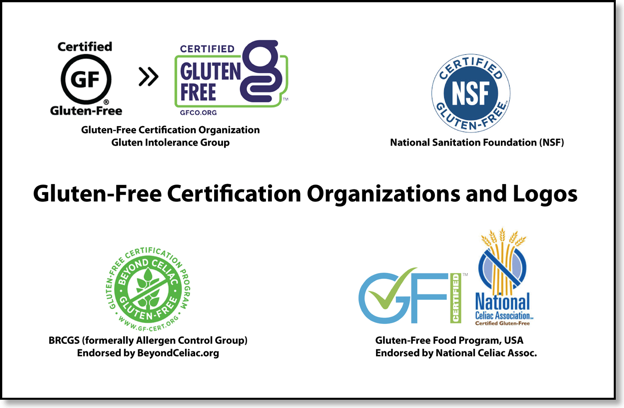
To be compliant, manufacturers must follow a few general guidelines when determining whether an undeclared ingredient substitution is allowed: The change can’t compromise the safety of the product (eg, introduction of major allergens or other sensitive ingredients). The omitted ingredient can’t be a major ingredient (eg, replacing wheat flour with rice flour in a muffin) or a characterizing ingredient (eg, replacing butter with margarine in a product with a “made with real butter” claim). The change can’t impact nutrient content or health claims made on the label. The change can’t have a significant impact on the nutritional quality of the finished product. Substitutions of Different Varieties of the Same IngredientDifferent varieties of the same ingredient, such as fruits or vegetables, may be freely substituted without label changes. For example, a product listing “jalapeño peppers” in the ingredients list may substitute another variety of pepper, regardless of whether it’s a major or minor ingredient.Manufacturers also may temporarily substitute fats and oils without label changes if they’re from the same category of fat (animal/vegetable/marine animal) and have a similar fatty acid profile.Similarly, due to a low supply of bleaching agent, products declaring “bleached flour” as an ingredient may substitute unbleached flour without declaring it in ingredients lists.
Read entire article: https://bit.ly/386Hteg
Updates:
06/26/20 - Added Today’s Dietitian link.
The Tale of Two Nightclubs

Understanding Celiac Disease Through
Motorcycles and Nightclubs
Several years ago, I encountered a recently-diagnosed guy who was having a rough time. His friends would hassle him about his diet, and he was struggling to explain celiac disease to them. As I got to know him, he revealed he rode motorcycles and hung with his buddies in bars. Back then, I came up with this basic analogy to help them understand. I decided to beef it up a bit. While I geared it toward his interests, I think it's generic enough to be understood by everyone.
Indeed, getting family and friends to understand this condition can be trying at times. It doesn't make sense how we can eat something all of our life - then BANG - we can't. Nor do they comprehend how diligent we must be in our diet or the seriousness of gluten infractions. It's our responsibility to educate them the best we can or as much as they will allow us. Be aware; they may not want to hear any of it.
What is Celiac disease?
The Gluten Intolerance Group defines it this way:
"Celiac disease is a chronic, autoimmune disease which is the result of an immune system response to the ingestion of gluten (a protein found in wheat, rye, and barley) in susceptible individuals. This response to gluten damages the small intestine, leading to malabsorption of nutrients and related health issues."
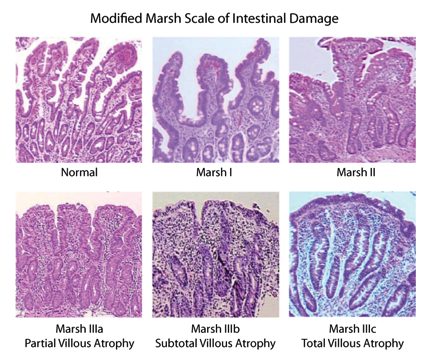
Who can get celiac disease?
"Genetics loads the gun - the environment pulls the trigger. " ~ Dr. Judith Stern, Professor of Nutrition and Internal Medicine University of California at Davis.
How do I get celiac disease?
Often we experience an event that is a suspected trigger like surgery, an infection, illness, pregnancy, or possibly extreme stress. Experts don't completely understand the exact reason a person loses their life-long ability to tolerate gluten, but they're working on it. They know that genetics and environment are necessary, but not sufficient to determine if someone will get celiac disease. Three other elements are vital in this equation: a gut that leaks - allowing the gluten to interact with our immune system; an overly-belligerent immune system; and an altered microbial ecosystem in our gut that is known as our microbiome. Of course, one must be consuming gluten in the first place. In today's society, that's almost a given.

What is gluten?
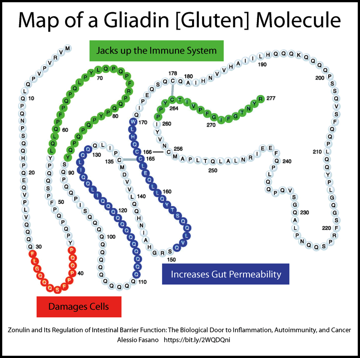
Gluten is the generic term for the proteins found in grains. Wheat [durum, graham, kamut, semolina, spelt, emmer, einkorn), barley [malt], rye [triticale - a hybrid of wheat and rye], and most oats due to cross-contact with gluten are problematic for those with a gluten-related disorder.
I have not heard about celiac disease before, is it new?
Gluten-related disorders such as Celiac Disease, Dermatitis Herpetiformis [an itchy skin manifestation of celiac disease], Gluten Ataxia [unsteady/wobbly walk due to neurologic damage], Wheat Allergy, Gluten/Wheat Sensitivity are not new. Since the introduction of grains during the dawn of agriculture over 10,000 years ago, human-kind experienced problems. During the second century, Aretaeus of Cappadocia, a Greek physician practicing in Rome, observed and documented this condition. In one of his few surviving written works, "The Coeliac Affection," he describes the disease:

"If the stomach be irretentive of food and if it pass through undigested and crude, and nothing ascends into the body, we call such person koiliakos."
If you hadn't guessed, the word celiac [coeliac is the British spelling] comes from the Greek word Koiliakos which means "suffering in the bowels."
The skeletal remains of a young Roman woman buried in a 2,000-year-old tomb in Tuscany showed signs of malnutrition and osteoporosis. DNA analysis revealed she carried two copies of the celiac genes - elevating her risk factor even higher. Experts suspect this woman had untreated celiac disease. What about her diet? Carbon and nitrogen isotope analysis of the bones cannot give us specific details. Still, they suggest she would have consumed more meat, possibly freshwater fish, but limited plants [like wheat].
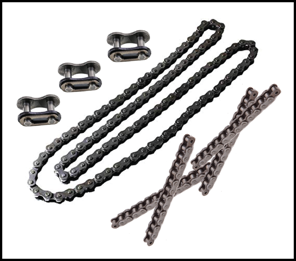
For our body to utilize the food we eat, our digestive system breaks it down into smaller pieces called amino acids. Think of gluten proteins like the drive chain on a motorcycle. Just as the chain consists of individual links, strands of gluten are comprised of amino acids. To break down the strands into digestible amino acids, we need specific enzymes. Those enzymes are like a chain breaker tool. To fully use that chain, we must break it down into individual links.

Engines have gaskets; their purpose is to prevent leakage of oil and water. When gaskets leak, the engine is in trouble. Our gut also has a special gasket; it's called the intestinal epithelial barrier. Unlike gaskets used in engines, our one-cell thick gut gasket is designed to open and close. It opens to allow "friendly" things to pass through like those amino acids. Yet, it also needs to keep out larger items like bacteria, viruses, and fragments of undigested gluten peptides.
Another unusual property of gluten when consumed; it tells our gut gasket to open by stimulating the release of a protein called zonulin. This opening happens in everyone but stays open longer in those with celiac genes due to excess zonulin production. This condition is called increased intestinal permeability, also known as leaky gut. Gluten is not the only thing that can create damage or cause a leaky gut. Just like an engine, when our gut gasket leaks too much, we're in trouble. Gluten sneaks past our epithelial barrier - that’s when the problems start.
What happens when we ingest gluten?
We're going to shift gears (pun intended). Let's compare night clubs or bars and our bodies; today's bar crawl will feature Club 99 and The Crypt. Inside, Club 99's atmosphere is vibrant and inviting. Lots of lush, colorful plants of varied species decorate the room. Tables are neatly aligned and inhabited with diverse and cheerful guests. A beautiful antique bar provides a stunning focal point. Jazz Fusion music plays lightly in the background. Oooo, is that Jean Luc Ponty, I hear? The exterior of the property is well-maintained too. Greeting us at the main door is a chiseled gentleman with broad shoulders, narrow waist, and well-defined biceps bulging out of his stylish Polo shirt emblazoned with a C99 logo. Their security team lurks unobtrusively and quietly in the shadows - waiting and watching. Yes, everything looks quite healthy.


Club 99 illustrates a healthy body inside and out. Our structure is good; we have healthy skin, our intestinal flora and fauna are balanced; everyone works and plays well with others. C99's attentive and well-behaved doorman acts like a "gut gasket" should. He lets good things in and keeps bad things out. C99's security staff is well-trained and evenly tempered - like a healthy immune system. For 99% of the population, their Ninja-like immune system quickly and quietly deals with gluten without incident.
I think you’ll agree, The Crypt is not a good place. Years of damage takes its toll internally and externally. Far too many unsavory characters have taken up residence there, forcing out those who would bring something beneficial to the party. Intensifying an already hostile environment, The Crypt's off duty doorman allows troublemakers inside the club. Conditions are ripe for an epic all-out barroom brawl. “Saturday night's alright for fighting. Get a little action in.” Everything is laid to waste when the overly aggressive security team tears up the place when dealing with the agitators. Shots are fired, broken windows, tables, and chairs become collateral damage during the altercation - our immune system does the same thing when encountering gluten. No organ is safe during these battles royale. With every ingestion of gluten, our bodies take a pounding. It’s no wonder we feel like crap after eating it. Imagine the amount of damage after years or decades of these conflicts. In some cases, our bodies simply can't recover.
Just as bad environments and neglect cause a building to crumble and collapse, the same will happen to our bodies if we do not strictly follow a gluten-free lifestyle. With knowledge, commitment, and attention to our diet, we can renovate The Crypt into a thriving place like Club 99.

Lack of Support From Family-
http://bit.ly/GIGECW_LackofSupport
Educating Family & Friends About Gluten-Free-
http://bit.ly/GIGECW_EducatingFamilyFriends
“Surprises from Celiac Disease” https://bit.ly/2WFmefu![]()
The Tale of Two Nightclubs PDF
Gluten-Free Success

This is a companion article to “The Stages of Change: Gluten-Free Edition.” I started out writing Gluten-Free Success, but a quote from Vishwas Chavan sent me down a rabbit hole about how we process and deal with change. Thank you for riding along with me on this trip.
Al Klapperich
How can we even begin to think about success when we're wondering how to survive breakfast?
If you hadn't heard of Tony Robbins, he's is a motivational speaker, author, and famous life coach. I find his formula for success straightforward and commonsensical. I like that. I'm all about being sensibly gluten-free.
While it may happen to some, most people don't blindly stumble into success - particularly with something significant like a lifestyle change. It usually requires some conscious effort - "massive action" as Mr. Robbins calls it.
Let's look at Mr. Robbin's formula and see how it can help create a successful gluten-free life.
Know your outcome
There are many definitions of success, but the best one is the one you've created for yourself. Success is unique - as individual as a fingerprint. One person’s success may be another person’s failure. Whether a newbie or a pro at the gluten-free lifestyle, ask yourself, "What does my success look like?" Let your answer be your guide.
If you've been suffering from an undiagnosed gluten-related disorder, you probably know your outcome already.
“I want to recapture my health and start a new life.”
An excellent long-term success goal, but don't forget to develop a roadmap - a plan to get there.
In "Springboard: Launching Your Personal Search for Success," G. Richard Shell, says, “success is not a static, one-and-done process. It’s dynamic. If you stay in motion, learn as you go, and remain open to the insights you gain on the journey, good things often follow.”
Gluten-free success may be different depending on the day, the hour, or even by the minute. That split moment decision to pass up that piece of gluten-filled birthday cake, the time spent learning what gluten is, or becoming a label reader and finding hidden gluten, helping someone in the gluten-free aisle at the grocery store are all great examples of success. On the surface, some of them might seem insignificant to us, but if we examine them closely, they are important milestones. Those successes add up and contribute to our long-term success goal.
It’s the little details that are vital. Little things make big things happen
Know your motivation
Motiviation is "The Why You Do it". That little voice inside you - sometimes whispering - other times SCREAMING that you can do it. Knowing what pushes you forward enables you to be more effective in attaining your success. For many, the motivation is a better life without the constant pain and suffering. For some, it's centered around loved ones - having the ability to fully present for them. For others, it's the opportunity to help others. Spend some time figuring out what gets your mojo working...and keep working it.
Transitioning to the gluten-free lifestyle is filled with numerous distractions; things that will pull you into the weeds. Friends and family members who offer gluten-filled foods, "Donut Day" at work, birthday celebrations, family gatherings, holiday parties. These are just a few events where temptation is present.
Enter stage left - discipline. Discipline is "The What You Do." It's the ability to analyze a situation and make corrections in your behavior. Discipline keeps you on the "straight and narrow"; preventing you from eating that [gluten-filled] donut or giving into friends and family members' offerings. Motivation and discipline work together. When the motivational inspiration wanes, discipline swoops in to save the day.
It's true, you will experience low-motivational days. Probably more than you want, but this is normal. Expect it and prepare for it. Mental preparation will help get you through; stay positive. By focusing on those small (minute-by-minute, day-by-day) successes, you will help raise your motivational energy levels.
There will be obstacles. There will be doubters. There will be mistakes. But with hard work, there are no limits.
Take Massive Action
Making a lifestyle change is no small feat. You're re-wiring years [decades] of behaviors and habits. Unlearning your old way of life and replacing it with a brand new one requires a lot of hard work, dedication, and commitment. You've probably noticed the use of the word "lifestyle" instead of "diet." Changing what you eat is only one component. This change will affect every facet of your life from here on out. Convenience – gone. Care-free dining – adios. The joy of family gatherings - replaced with dread and worry. Things that took little or no thought - now rivals the logistics of a Mars Rover launch. Yes, it will require massive action.
A few examples of massive action in the gluten-free lifestyle.
Making the 24x7x365 commitment to gluten-freedom. There are no vacations, no breaks, no “just this once" cheats. Constant vigilance is required. Gluten never sleeps.
Educate yourself about gluten - what is it, learn where and how to find it.
Determine if you can have a gluten-free house. Many variables to consider. Choose what's best for you and your family.
Clean your house from top to bottom. Crumbs matter. Either throw out all the gluten [and gluten-contaminated items] for gluten-free household or arrange [segregate] gluten-free/gluten products accordingly. Setup gluten-free safe zones and develop cross-contact policies and procedures [and make sure household members abide by them].
Educate your friends and family members. Depending on the family this task may be more Sisyphean than Herculean, but it needs to be done.
Join and participate in a support group. Local face-to-face groups are best, but online groups can be beneficial too.
Notice your results and change your approach
The key word in this step is "change." Change isn't always linear with clearly defined starting and stopping points; it's an on-going, evolving process.
Due to the complexity of this lifestyle, you will be making some mistakes in the beginning. Everyone does, it's all part of the process. You didn't go from crawling to walking without a few falls. Don't let these events derail your efforts. Get up, dust yourself off, and try again. Resiliency and adaptivity will take you far on your journey toward gluten-free success.
The important take away here: learn from your mistakes. If you don't you will be spinning your wheels; expending a lot of energy but going nowhere - fast.
When something didn't work out as you expected, or you are not feeling well, take time to analyze what has been happening, why it's happening, and how you can prevent it in the future. Yes, you have to become a "Gluten Detective." Perhaps you've switch products because the store stopped carrying your first choice? Maybe the french fries you ordered at the restaurant were fried in the same fryer as the gluten-full items? What about overlooking gluten in a product's ingredient list?
Only those who are able to adapt to changing scenarios will continue to survive and prosper. Success is directly proportional to the degree of positive adaptation to change.
I understand that our health may not always be under our direct control, but I also know that before tackling any challenge, we must first prepare ourselves mentally. Hopefully, the information presented here and in the Stages of Change article will help increase your knowledge, grow your confidence, and elevate your capacity to manage the jumble of emotions you'll experience on this gluten-free journey.
Here’s to your success! Cheers!
The Stages of Change - GF Edition
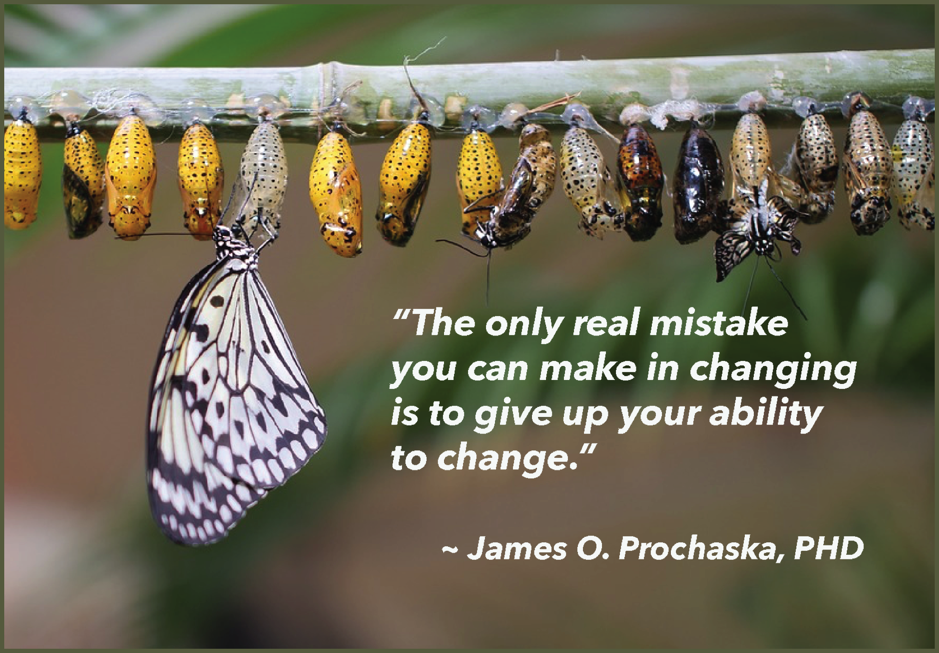
This is a companion article to “Gluten-Free Success.” I started out writing Gluten-Free Success, but a quote from Vishwas Chavan sent me down a rabbit hole. That trip resulted in this article. Thanks for riding along.
Al Klapperich

BRAIN: "What's that noise? Why are those bushes rustling? Is it a wild animal getting ready to attack us? DANGER!"
When confronted with change, our brain can't predict the outcome, so it triggers the"flight or fight" response. Faced with uncertainty, we find ourselves distracted, anxious, and fearful. This heightened state decreases decision-making abilities, reduces memory, and elevates anger; not always conducive for clear, thoughtful consideration. The human brain is an astounding organ. Not only does it need to maintain order, but it also manages adaptation. We may not notice it, but our brains are continually changing in response to our ever-changing environment; the scientific name for this process is neuroplasticity. This adaptability enables our species to thrive and survive all kinds of adversities. The trick is to use our innate adaptability to our advantage. However, this metamorphosis requires a lot of effort. When transitioning into the gluten-free lifestyle, there are a lot of changes, unknowns, and unpredictable outcomes. Yes, our brains are going to freak-out. We are replacing old comfortable habits and behaviors with new, unfamiliar ones. Those old behaviors have become almost automatic; requiring little to no thinking. We have had a lifetime to build those neural pathways in our brains.
Neural pathwhats? The pathways along which information travels through the nerve cells of the brain. When we say or do things repeatedly, that information in our brain travels the same path. Think about a hiking trail in the woods - as the path receives more traffic, it becomes better defined, well worn and effort-less to travel - the same thing happens in our brains. When we start our gluten-free lives, we are blazing new pathways. This requires us to be conscious, and purposeful in our efforts.
Over the years, scientists and mental health care professionals have developed many thoughts and theories about the brain, the process of change, and human behavior. Of the many behavioral change models that exist, the most prevalent are Learning Theories, Social Cognitive Theory, Theories of Reasoned Action and Planned Behaviour, Transtheoretical Model of Behavior Change, The Health Action Process Approach and the BJ Fogg Model of Behavior Change. Each model has its own set of strengths and weaknesses. That's not something we'll be discussing here. We will be exploring the Transtheoretical Model of Behavior Change (TTM) - also known as The Stages of Change. I chose this method because it made sense to me, it seemed logical and fit my personality and way of thinking. Will it be a fit for you? I don't know the answer, but keep reading you might be surprised.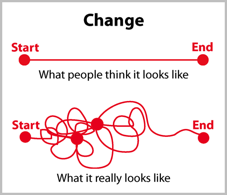
- The Stages of Change - when change occurs.
- Pre-Contemplation: No action for six months.
- Contemplation: Intention to act within six months.
- Preparation: Intention to act within 30 days
- Action: Experiencing change for less than six months.
- Maintenance: Experiencing change for more than six months.
- Decisional Balance (Pros & Cons) - why we change.
- Weigh the Pros (advantages) and Cons (disadvantages) of changing.
- Pros and Cons are independent of one another. Can be high in one - low in another. High in both, or low in both.
- Pre-Contemplation stage - the Cons of changing out-weigh the Pros
- From Pre-Contemplation to Contemplation - the Pros consistently increase
- From Contemplation to Action - the Cons consistently decrease
- Pros begin to outweigh the Cons before we take action.
- The key: double-up the focus on increasing the Pros of changing.
- Self-efficacy (Confidence & Temptation) - confidence to execute change.
- Confidence is low and tends to grow as we progress through the stages. Inversely, temptation lessens.
- We see the biggest jump in confidence in the Action and Maintenance stages
- Confidence and Temptation tend to be balanced during the Action stage.
- The Processes of Change - how change occurs.
- Describes the basic pattern of activity we experience as we process change.
Pre-contemplation
In this stage we do not know we have to change, or we do know, but simply do not want to. When it comes to the effects of gluten, there's a wide spectrum. [This stage casts a wide net over the gluten-free community.] In most cases, people with gluten-related disorders have experienced some ill-health - be it long-term or short-term. We know something is wrong, but haven't been diagnosed or have been misdiagnosed. Maybe we think our state of being is perfectly normal because we've always been that way - our entire family is that way. If we have silent celiac disease [have no symptoms], a diagnosis will catch us completely by surprise. We may have a diagnosed family member urging us to get tested, but we brush them off like a pesky mosquito. In this stage, we don't want to hear that gluten could be a problem for us.
"Give up my bread/pizza/beer? No way, I'd die without it." "Just because you have problems with gluten, doesn't mean that I do." "Bah, my sensitive stomach has nothing to do with gluten." If that sounds like denial, yes, it probably is.
To move past this stage, we must somehow become aware that a problem exists and accept that we must address it. We may come to this realization on our own after we've been given testing results from our healthcare professional, or we finally listen to our family and friends. The mere fact that we are "thinking about it" is forward progress!
Contemplation
This stage finds us realizing the value in making the change; the mental gears have been turning, and we are getting ready. We have thoughts of "Yeah, I get that gluten-free is important" but the key is to personalize them by thinking "I need to be gluten-free." Here we start to acknowledge the problem and take ownership. Our minds are now open to new ideas and information. We may begin asking questions of friends and family who have already gone gluten-free. The trick is discovering the trigger - the event, the person, the emotion, the reason we flip the switch. We begin to explore the possibilities about what we need to do and if it will be worth the effort. These thoughts can be fleeting or last a lifetime. The bottleneck in contemplation is getting stuck in a loop of weighing the benefits against the costs of making the change. We never feel ready to commit. Deep down we know change is needed, but we can't make it happen. To help organize and visualize our thoughts, sit down with a pencil and paper - list all the pros on one side and the cons on the other. When we encounter obstacles, identify ways to overcome them.

With everything that's going on, our emotions may inspire us to act immediately. Sometimes this causes us to jump right into the Action stage - bypassing one of the most important stages - Preparation. Action without perparation can lead to disaster.
Preparation
We've made the decision to change, now we must figure out how to do it.
SELF: "What do I need to do to prepare myself to make this transformation happen?"
Any successful outcome begins with forethought and planning. We are creating a plan of action; a road-map if you will. Put it in writing, draw pictures with circles and arrows, create a wall-sized vision board, save the plan as your device's wallpaper or desktop picture as a constant reminder - do whatever generates the greatest impact. Begin gathering the tools and resources to help us navigate our gluten-free journey. One of the most effective resources is a local support group; seek out your nearest group - inquire about their meetings (when, where, how often, etc.) - better yet, join and attend a meeting. Start building a library of trusted books and websites. This stage is about building our knowledge and confidence, preparing us for gluten-free success. Think about all the possible ways we cross paths with gluten. Cupboards, pantries, refrigerators, freezers, silverware drawers, cutting boards, toasters, kitchen utensils, counters, medication, hair and personal care products, family gatherings, parties, social functions, restaurants, medical and dental procedures - the list is staggering. All of these things and more need our attention. It's better to have a plan of action so we can be PROactive instead of REactive. Some of our very first actions begin appearing. The key to mastering this stage is a commitment to all the effort, planning, and researching. We must be ready to go all-in. Being "sort of " gluten-free is like being "a little"pregnant.
Action
It's game day! We move from thinking and planning to doing. We've done the risk/benefit analysis and committed to making the leap - we've made a plan, and now it's time to act! It's here where real change starts happening.
We go on a gluten-round up at home - seeking out and removing all sources of gluten. If we can't do a 100% GF house, we gather and store all the gluten in designated areas. Empty and clean out every cabinet and drawer [see all the crumbs in the silverware drawer? YIKES!] Clean the fridge and stove, get a new toaster, cutting boards, and colanders. Join and actively participate in the local support group [if you haven't done so already]; we truly need that face-to-face support. Read the mountain of gluten-free books sitting on the coffee table. By following our initial action plan, we'll be making significant modifications to our routines, environments, our relationships, and of course ourselves. That's the whole idea, right?
As expected, this stage will require every ounce of commitment we can muster. We may find ourselves being pushed and pulled to the very limits. Sadly, some of this stress may come from those closest to us. We need to hold fast to the course we've plotted out; for our own health and wellbeing. If we find ourselves drifting or blown off-course refer back to the plan of action we created. Keep finding acceptable alternatives and focusing on our "cans" instead of "can not's" It's necessary to acknowledge and celebrate the progress and victories along the way - no matter how seemingly insignificant we think they are. Anything that moves us forward toward our goal is a success! We also need to recognize the failures, not to chastise ourselves, but to learn from them. If we know why something happened, we can prevent it from happening in the future.
Maintenance
The maintenance stage is about sustaining the momentum we started in the beginning. At first glance, we think the hardest part of the change process is the initial startup. True it's tough, but maintaining the change long-term is the most challenging part of the process; it's also the most important. At this point, our new lifestyle is on its way to being established, things are starting to become routine. Confidence is increasing. Certain memories of our past lives are starting to fade. Complacency is our enemy because of the possibility of slipping into our old lifestyle may be lurking in the background. Dramatic life events such as a job change, breakdown of a relationship, a death make us vulnerable. These events can beckon us back into our old habits. While our original plan serves us well, we keep optimizing it to address past mistakes and handle any situations we didn't expect at the start. View these challenges as an opportunity to advance your skills, knowledge, and confidence. This continued growth pushes us ever closer to the next stage. Perhaps more work on label reading is needed because small amounts of gluten are slipping below our radar despite our diligence. We didn't think about our church's communion hosts containing gluten. Our high school class reunion is coming up, maybe we could volunteer to be on the planning committee to have a voice in food options.
Pro tip: Get involved in planning activities. This gives us an opportunity educate and make positive changes from the "inside."
Because of our new gluten-free lifestyle, our bodies are adjusting, adapting, and healing - mentally and physically. After gluten reactions subside, we may discover other problematic foods. Of course, this will require additional tweaks to our plan. The diets to obtain optimal health are as unique as our fingerprints. It can take some time resolve additional food sensitivities. As we settle into maintaining our new life, we may struggle with keeping the fire lit; we run the risk of losing the intensity. If we haven't participated in a local support group already, make it a priority. Surrounding ourselves with like-minded individuals can help keep us motivated. Fellow members walk our walk, talk our talk, share the same struggles and joys.
Termination/Adoption
We started out telling ourselves "I can't", then "I might", followed by "I will", "I am", "I am still", and now finally "I have". It's been a long road on our way to change. After spending at least two years in the Maintenance stage, we find ourselves sliding into the Termination/Adoption stage. At this point, we don't have to think so hard about what to do; we know what to do. Our daily activities come to us naturally; they become second nature, almost as automatic as breathing. We have confidence in our knowledge and abilities. Sure, we may miss certain aspects of our former life, but the desire to return to that unhealthy and sickly life has dissipated. Our transformation from gluten-full to gluten-free has come to fruition. Our new life has become our "new normal." We started out as a caterpillar and came out the other side as a butterfly. Well done. A proud moment for sure. This does not mean we stop our personal evolution process! No, we keep moving forward. We look for new and more adventurous goals. Now is the time to dream and plan for things we never thought possible in our former life. Perhaps we have a strong desire to share what we've learned to help others. Starting your own support group or volunteering at your current group is an excellent choice. Maybe we participate more in online discussion boards or Facebook groups. Possibly start our own blog or website. There are many ways to boost our gluten-free advocacy to the next level. Maybe your new goals have nothing to do with gluten. Perhaps you want to train for that 5K, 10K, or Half Marathon you've always wanted to do? What about music or voice lessons? Now would be a great time to start that writing project. The possibilities are only limited by your imagination. Prochaska estimates only about 15 to 20 percent of the people make it to this stage. If you find yourself falling back into previous stages, don't panic. Be gentle with yourself. Figure what stage you're in - go back to your game plan, see if it needs a bit of tweaking and renew your commitment to moving forward. Ask for help. Never give up.
Relapse/Lapse
Not an official stage of Prochaska and Di Clemente's model but some valuable insights can be learned here. Note: Repeated gluten exposure is a serious health risk for those with a gluten-related disorder. There is an important difference between relapse and lapse (also known as a slip). A lapse or slip is a rare, quick and temporary return to the behavior/lifestyle we've been trying to leave behind.
Example: while attending a birthday party, we have a piece of gluten birthday cake.
A relapse is a complete and total return.
Example: we tell ourselves the gluten-free lifestyle is too hard and go back to eating gluten.
Gluten is so pervasive in our society, no matter how hard we try, we will likely be faced with a gluten exposure at some point. We must be prepared and know how to deal with the inevitable. For this article, I am defining a relapse/lapse as any gluten exposure - be it blatant cheating or inadvertent/accidental. Over the years, I've crossed paths with far too many people with celiac disease and non-celiac gluten/wheat sensitivity who willingly and knowingly cheat. Of course, they have their "justifications," but in the long-run, they are cheating themselves, and their loved ones. If you're new to the gluten-free lifestyle, I'll be crystal clear - cheating is not an option for those with a gluten-related disorder. Accidental/incidental exposure is different from blatant cheating. Regardless of how or why we consume gluten - the damage is the same; the difference here is the intent. We must be mindful of these mishaps, so we do not continually repeat them. If we peel back the layers, there's probably a fine line between repeated accidental/incidental exposures and cheating. To be caught by surprise the first time is understandable, but if the same situation happens repeatedly - it shouldn’t be - we need to take a closer look at what’s going on.
GIG of ECW's "The Risks of Cheating" looks at the complications from repeated gluten exposures. bit.ly/GIGECW_Cheating
While we may not like visiting this stage, it can be beneficial to our overall success. It's important to view relapses/lapses not as failures, but rather another stage on our way to success. If we believe this set back is a failure, we're at risk of creating a self-fulfilling prophecy - undermining our efforts and making it easier to regress to our glutenous ways. Lapses reinforce our need to be completely gluten-free. Once we start feeling better, we might doubt gluten's role in our poor health. While having that piece of pizza when hanging out friends seemed like a good idea at the time, we are sorely and swiftly reminded why we began this transformation. We learn about resilience and persistence. When we are knocked down, we get back up and keep moving forward. Why? Because we deserve a better life and won't stop until we attain it. Because our friends and family deserve a better "us." Never give up.
"Courage does not always roar. Sometimes courage is the quiet voice at the end of the day saying, 'I will try again tomorrow." ― Mary Anne Radmacher
Ten Processes of Change The stages of change tell us what happens when we experience changes in thinking, emotion, and behavior, but the processes of change show us how the changes come to be. The implementation of these cognitive and behavioral activities are used to advance through the stages successfully. The processes are divided into two sections - Experiential and Behavioral. The experiential processes use increase over time and peaks in the contemplation or preparation stage and decrease in the action and maintenance stages. The behavioral processes are used most in the action and maintenance stages. This makes a lot of sense - first, we change our thinking, then we change our behavior.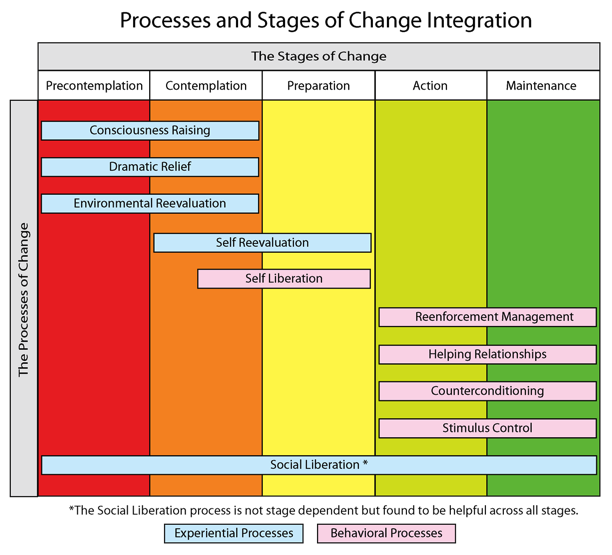
1. Consciousness Raising [Increasing awareness] - Experiential
Family members, medical professionals are telling us about our gluten intolerance and our need to be gluten-free. We start gathering information to get a better understanding of the new behavior required to remove gluten. "I recall information people have given me about gluten and gluten-related disorders."
2. Dramatic Relief [Emotional arousal] - ExperientialThe information we are receiving is concerning to us. We start to feel uncomfortable or possibly frightened. Maybe there's really something to this? "I react emotionally to warnings about gluten and gluten-related disorders. Grandma died from a stomach-related illness, no one really knew what it was. Could it have been celiac disease and she didn't know it? If I don't go gluten-free will the same thing happen to me?"
3. Environmental Reevaluation [Social reappraisal] - ExperientialWe're realizing our behavior is affecting those around us. The effect may be positive or negative depending on our choice. "I realize that if I continue to eat gluten and remain sick, I won't be able to care for my children. By being gluten-free, I am able to fully participate in life instead of watching it from the sidelines."
4. Self Reevaluation [Self-reappraisal] - ExperientialWe begin to look inward and assess how our gluten-free lifestyle is affecting us. We take note of how we are feeling physically and emotionally "I feel so much better when I'm gluten-free both physically and emotionally. I know I must remain so for life. When I cheat, I am disappointed in myself for putting my health and my family at risk."
5. Social Liberation [Environmental opportunities] - ExperientialAs we delve deeper into the gluten-free lifestyle, we find more people are aware of gluten-related disorders than we first expected. Grocery stores have dedicated aisles for gluten-free products. Select restaurants, bakeries, hotels, resorts, etc. have gluten-free offerings or specifically cater to the gluten-free community. [Note: Awareness of gluten and gluten-related disorders is growing. It's better than it used to be, but still has a long way to go.] "I find mainstream awareness is making it easier to be gluten-free. Family members who have been gluten-free for years tell me it's much easier to be gluten-free today than it was five or ten years ago."
6. Stimulus Control [Re-engineering] - BehavioralBy removing gluten from our homes [or at least moving and re-arranging it], we begin the mental re-wiring process. If gluten isn't there, we won't be tempted to eat it. Instead, we replace it with healthy, gluten-free alternatives "Whew! I feel more comfortable in my home now that gluten has been removed or sequestered. I'm also learning how to cope with gluten in situations where I don't have complete control [workplace, public venues, etc.]."
7. Helping Relationship [Supporting] - BehavioralHaving support is crucial to a successful transition. We need trusted individuals who are caring, compassionate, and willing to simply listen. "I have a spouse/friend/family member who is tremendously supportive. Always willing to listen and be my gluten-free champion." "My spouse/family members are horrible. They are unsupportive and at times overtly try to derail my efforts. Thank goodness for friends and my local support group members. They understand - they 'get it' - they keep me sane."
8. Counter Conditioning [Substituting] - BehavioralGrabbing a snack or something to eat can be one of those "autopilot" type actions. It's easy to snag a bag of chips, a cookie, or candy as we walk past it. Instead of stocking our kitchens with glutenous foods we supply it with healthy, gluten-free alternatives. We must be mindful, in today's gluten-free environment it's easy to swap out processed crappy glutenous foods with processed crappy gluten-free foods. Now is the time to make better choices - fresh fruits, veggies & gluten-free hummus, walnuts, almonds, cashews, hard-boiled eggs, high-quality gluten-free dark chocolate (Endangered Species Chocolate Bars). "I wasn't sure about it at first, but I find myself genuinely liking veggies and hummus as a snack."
9. Reinforcement Management [Rewarding] - BehavioralReinforcement Management renders consequences based on decisions and actions. While reinforcement can include the use of penalties, rewards tend to yield better results over punishments. A combination of cognitive and behavioral reinforcements, positive self-statements, and external recognition reinforce positive behavior and increase the likelihood of repeated positive behavior. While gluten-free treat food may seem like a reasonable reward option, it's not recommended to use any food as a reward (or punishment). Suggestions: Guilt-free "You Time," massage - mani/pedicure, a movie, museum trip, shopping trip, ballgame. "I really rocked it this week. My skills, knowledge, and confidence are growing. I found a gluten-free labeled food containing barley due to my label reading skills. I alerted the appropriate parties. My family and friends are noticing and praising me. I think I'll purchase that Wusthof Chef's knife, I've been eyeing up."
10. Self Liberation [Committing] - BehavioralWe believe change is needed and commit to making that change. "I can no longer ignore the facts. I have come to realize that I can and must be gluten-free. I know that it will not be easy, but I am ready to make the change for myself and loved ones."
James O. Prochaska, PHD
http://bit.ly/2BYGRuE
“James O. Prochaska is Director of Cancer Prevention Research Center and Professor of Clinical and Health Psychology at the University of Rhode Island. He is the author of over 400 publications, including three books, Changing for Good, Systems of Psychotherapy and The Transtheoretical Approach. He is internationally recognized for his work as a developer of the stage model of behavior change.”
Detailed Overview of the Transtheoretical Model
(Stages of Change)
http://bit.ly/2MCHnTR
ExperienceLife.com
“The Stages of Change”
By Jessie Sholl
http://bit.ly/2okF5dE
PsychCentral.com “Stages of Change”
By Mark S. Gold, MD
http://bit.ly/2LF8zwc
AConsciousRethink.com
“The 5 Stages Of Change Required To Make New Behaviors Stick For Good”
By Katie Uniacke
http://bit.ly/2NtydW8
Gluten-Free Communion Guide
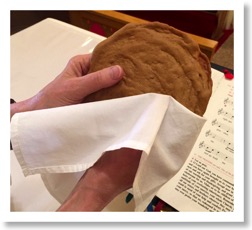
Attention to detail is critical for success in the gluten-free lifestyle. It is not surprising considering lives are turned upside-down by something measured in parts per million [yes, parts per million].
Please keep an open mind about the information presented here. It can be hard to comprehend that "The Staff of Life" can make someone sick. Science proves it to be true for about 3 million with celiac disease and an estimated 17 million with gluten sensitivities; just in the USA alone.
In this guide, you'll find information on gluten, how to eliminate gluten cross-contact, several recipes for gluten-free hosts, and links to commercially available gluten-free hosts.
If you have questions or desire additional help in instituting a gluten-free communion in your house of worship, please reach out to us.
Alan & Peggy Klapperich
Gluten Intolerance Group of East Central Wisconsin
GIG.EastCentralWisconsin@gluten.org
Phone: 920-748-4877
If you are looking for just the recipe: click here.
Links to Download GF Communion Guide PDF
![]()
![]()
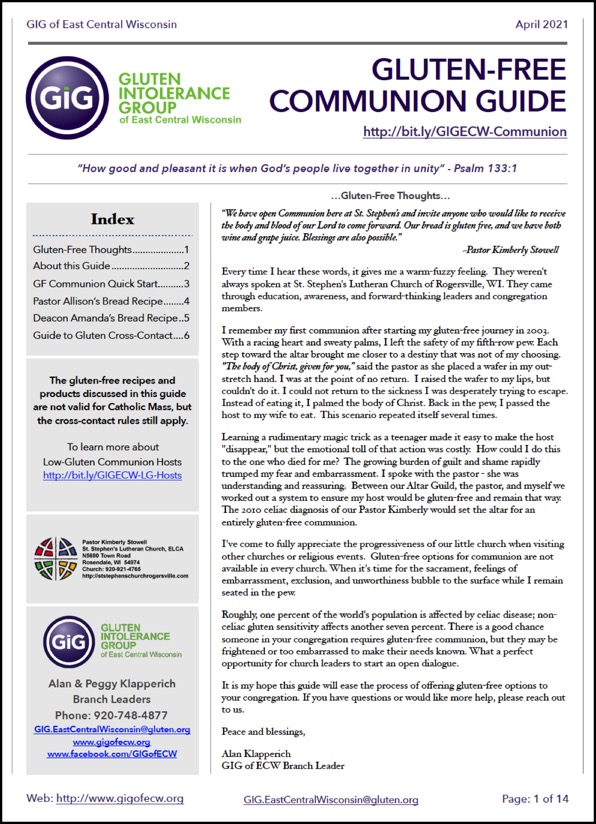
04/11/21 - Updated Guide to Gluten Cross Contact Guide
3/21/19 - Updated for 2019 Synod Assembly
Gluten-Free Label Reading
On the evening of Friday, May 22nd 2020, the FDA issued new guidance relaxing the requirements around the labeling of ingredients due to the supply issues caused by the COVID-19 pandemic. As one might expect, this rocked the world of those with food allergies as well as those with gluten-related disorders.
To learn more about this labeling change, check out our article: https://bit.ly/GIGECW-FDA-Temp-Labeling
OK, true confession time. Before 2003 I rarely looked at a product's ingredient label. I saw no point in it; if it tasted good - I ate it. Hmmm, could this have been a contributing factor in my steadily increasing weight and my rapidly declining health? Yeah.

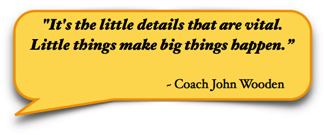
It should be no surprise that attention to detail increases our chances of success in the gluten-free lifestyle. After all, something measured in parts per million rearranges our lives. Talk about little things making big things happen. Coach Wooden’s words take on a whole new meaning for those with a gluten-related disorder.
Knowing what's in our food is probably one of the most important details. President Theodore Roosevelt signed into law the Pure Food and Drugs Act of 1906. Known as the Wiley Act, it gave the federal government the power deem a food “misbranded” if ingredients were “false or misleading,” or deemed “adulterated” if it contained ingredients harmful to health. Sadly, it would take nearly a century before the presence of food allergens would be recognized. A decade later, gluten-free regulations finally make it on the books.
The Protection Agencies
Only a few different governmental agencies regulate food safety. In this article, we’ll be discussing the US Food and Drug Administration (FDA) and the US Dept. of Agriculture (USDA). The US Treasury’s Alcohol and Tobacco Tax and Trade Bureau (TTB) regulates beverage alcohol [as in gluten-free beer]. Sorry beer lovers, we won’t be getting into those regulations in this article.
FDA vs. USDA
The FDA regulates most packaged foods we see on the store shelves. The USDA regulates meat, poultry and egg products, and mixed food products that contain more than three percent raw meat or two percent or more cooked meat or poultry (e.g., soups, chilis, frozen entrees).
While USDA regulated products are encouraged to follow FDA regulations, it is not required. [This is valuable information to know when it comes to reading ingredient lists. More on this later.]
Estimates show that 80% to 90% of USDA products voluntarily comply. If you see a “Contains” statement or other indication of a USDA product, major food allergen will be plainly listed.
FDA & the Top 8 Food Allergens

The FDA’s Food Allergen Labeling and Consumer Protection Act of 2004 (FALCPA) requires food labels to clearly identify the food source names of all major food allergens used to make the food. They must use the common or usual name of an ingredient [e.g., Modified Food Starch (wheat)} or use a “Contains” statement next to the ingredient list. [e.g., Contains Wheat, and Milk]
What are the major allergens as defined by the FDA?
- Milk
- Eggs
- Fish (bass, flounder, cod)
- Crustacean shellfish (crab, lobster, shrimp)
- Tree nuts (almonds, walnuts, pecans)
- Peanuts
- Wheat (including all types: durum, spelt, emmer, farina, farro, einkorn)
- Soybeans
Source FDA: http://bit.ly/FDA-Big8
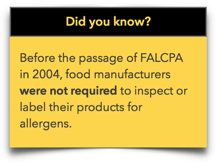
You’ll notice the Top 8 list above only includes wheat. It does not include gluten-containing ingredients barley (malt), rye, or oats*. Fortunately, barley is most commonly listed as “barley," "barley malt," or simply “malt”. Rye is rarely used in a form other than flour and would appear in the ingredient list.
*Oats (and products that contain them) that are not explicitly certified or labeled gluten-free are off-limits to anyone following a gluten-free diet. They are a high-risk ingredient because they are exposed to substantial amounts of gluten via cross-contact from field to packagings. Oats require additional knowledge and careful consideration.
 "What Oats Through Yonder Package Breaks?"
http://bit.ly/GIGECW-PureOats
"What Oats Through Yonder Package Breaks?"
http://bit.ly/GIGECW-PureOats
The Ingredient Label
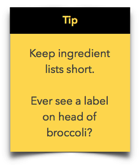
The ingredient label is your frontline defense in determining the gluten-free status of a product. An important fact to know: FALCPA labeling regulations do not apply to the potential or inadvertent presence of food allergens resulting from cross contact. Cross-contamination of a food or ingredient can occur at harvest, transport, manufacturing, or packaging. Calling the manufacturer may be required not only for ingredient clarification but also to determine manufacturing practices.
Cross-contact and Good Manufacturing Practices
Manufacturers are encouraged [not required] to follow Current Good Manufacturing Practices (CGMP). Part of CGMP means developing and executing food allergen control plans. The plan must address six elements: training of processing and supervisory personnel, segregation of food allergens during storage and handling, validated cleaning procedures for food contact equipment, prevention of cross-contact during processing, product label review and label usage and control, and a supplier control program for ingredients and labels.
Voluntary Allergen Advisory Statements
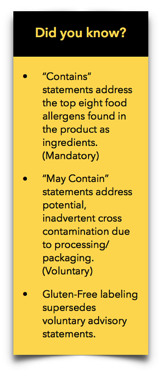
Gluten-free experts and third-party testing tell us Food Allergen Advisory statements are not useful in determining the gluten-free status of a product.
You may find a product labeled “Gluten-Free and/or Wheat-Free” or even bears a GFCO gluten-free certification logo that has a Food Allergen Advisory statement that includes wheat. Yes, this product complies with current FALCPA labeling laws.
For products not certified gluten-free, call the manufacturer to ask questions. Ask about the facilities, the production lines, and their policies, procedures for allergen handling, and testing protocols. If they do not answer the questions to your satisfaction, find another manufacturer with a similar product that does meet your needs.
 "May Contain Statements"
http://bit.ly/GIGECW-MayContain
"May Contain Statements"
http://bit.ly/GIGECW-MayContain
The Definition of Gluten-Free
As we discussed above, FALCPA does not directly address gluten. Before the FDA could create regulations regarding “gluten-free,” they needed to define what “gluten-free” means. It took ten years for the definition to finalize, but the voluntary gluten-free labeling regulation went into effect August 5th, 2014.
The FDA’s definition of “gluten-free,” “no gluten,” “free of gluten,” or “without gluten” is as follows:
“…the food either is inherently gluten free; or does not contain an ingredient that is: 1) a gluten-containing grain (e.g., spelt wheat); 2) derived from a gluten-containing grain that has not been processed to remove gluten (e.g., wheat flour); or 3) derived from a gluten-containing grain that has been processed to remove gluten (e.g., wheat starch), if the use of that ingredient results in the presence of 20 parts per million (ppm) or more gluten in the food. Also, any unavoidable presence of gluten in the food must be less than 20 ppm.”Source: http://bit.ly/FDA-QA-GF-Labeling
Notice the last sentence of the definition: "Also, any unavoidable presence of gluten in the food must be less than 20 ppm.” This means cross-contact.
I hear you…
“Whoa, this is confusing and complicated. Isn't there an App?"
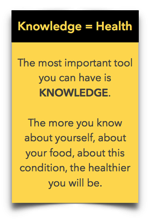
Websites, published lists, and apps that report a product's gluten-free status are excellent tools to help narrow down product selection. Please do not use them as the sole means to determine the gluten-free status.
Companies change product ingredients at will, generally without notice. The product label will reflect any ingredient changes. Most companies will refer you to the ingredient list found on the product for the most up to date information. A published list (on paper or electronic form) is only as accurate as its most recent update.
Reading the label. Finally!
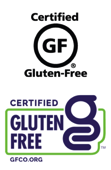
- Look for a third-party gluten-free certification mark - like GFCO's.
- Gluten-Free Certification Organization requires all finished products and individual ingredients using the GFCO logo contain 10 parts per million or less of gluten.
- Know your certification organizations (see logos below). When companies mark their products as GF it may appear as if they are actually certified. It might simply be a logo from their marketing or package design department.
- Read the ingredient list. Yes, even certified products. If you see any of following ingredients, the product is not gluten-free.
- Wheat (including durum, spelt, emmer, farina, farro, einkorn)
- Rye
- Barley
- Oats (unless certified gluten-free)
- Brewer's Yeast
- Malt
- Ingredients needing verification:
- Yeast Extract - this could be a by-product of the beer brewing process. Verify with manufacturer in non-GF labeled products.
- Vinegar - FDA defines the single word "vinegar" to mean apple cider vinegar. However through the certification process, GFCO has encountered some usages of malt vinegar labeled as "vinegar". Remember barley/malt is not required to be disclosed. Not a large area of concern, but if you are unfamiliar with a manufacturer or product, it might be a good idea to inquire about the source of their vinegar. Better safe than sorry.
- USDA Products - Products are not required to comply with FDA's FALCPA regulations. If you see a "Contains" statement (or some other wording) that a package is complying with FALCPA, you know wheat must be declared. If you do not see a "Contains" statement, you'll need to verify the source of these ingredients (they could come from wheat):
- Starch
- Food Starch
- Modified Food Starch
- Dextrin

Congratulations!
You’ve made it! I hope I’ve increased your knowledge on this multi-layered subject.

Label Reading Resources
Gluten-Free Labels 101 Video Webinar
http://bit.ly/GIG-GFLabels101
Q&A Gluten-Free Labels 101 PDF
http://bit.ly/GIG-QA-GFLabels101
Gluten-Free Label Reading
http://bit.ly/GIG-LabelReading
3 Tips for Gluten-Free Label Reading
http://bit.ly/GIG-3TipsGFLabels
Getting Started on a Gluten-Free Diet
http://bit.ly/GIG-GettingStarted
Gluten-Free Certification Organizations and their Logos


Practical Gastroenterology - December 2019
Timely Topics in Gluten-Free Labeling
NUTRITION ISSUES IN GASTROENTEROLOGY, SERIES #193
By: Amy Keller MS, RDN. LD.
Excellent article from Amy Keller, MS, RDN. LD
“Patients with the inherited autoimmune condition, celiac disease, must avoid gluten in any form to help heal damaged intestinal villi. The Food and Drug Administration’s (FDA) Gluten Free (GF) label is intended to help instill trust in consumers with celiac disease and gluten-related disorders. Studies show that the vast majority of labeled GF foods meet the FDA’s standard of <20 ppm gluten, but consumers remain leery of some labeled GF products, especially those displaying allergen advisory statements for wheat. Products containing malt, malt extract, and other gluten-containing ingredients continue to show up on store shelves, which may indicate that FDA enforcement of the GF labeling rule is lacking. Consumers may find a personal allergen detection tool to be an attractive option to assist in testing food for gluten content, but these also come with significant limitations.”
Read More: https://at.virginia.edu/33RLEqy
In the confusing landscape of food labels, assumptions are risky but knowledge is power.Whether you’re new to the food allergy world or a veteran, there is never a time you can let your guard down. Read More: http://bit.ly/2H3oPW8
Required Reading With Food Allergies or Celiac Disease
By: Gina Clowes
Published: April 1, 2015
Certified master life coach, Gina Clowes offers up some great labeling reading advice.
As many of us who shop for groceries know, gluten can appear in many shapes and forms on a product label. Lots of brands do label their products gluten-free and some even go the extra mile to get a gluten-free certification — but there are still thousands that don’t. So, what does that mean if you have gluten sensitivity or have been diagnosed with celiac disease? Read More: https://bit.ly/3EyMUTo “Let’s face it, the gluten-free diet is complex and difficult to maneuver. Add to this the issue of common ingredients that never seem to get off lengthy lists of “things to question” and it’s no wonder that so many people doing their best to avoid gluten are still assailed by confusion and anxiety. That’s why we think it sometimes makes more sense to explain why you don’t have to worry about certain ingredients. Here are the leading ingredients that you can stop worrying about.” “The information in our ingredients index will help you read a food label. It is based on the research we have done by interviewing experts in the field of food science.”
Gluten-Free Label Reading: From Novice to Expert
Published: March 1, 2022
If you find yourself in the packaged food aisles reading labels, you'll run into some strange and confusing ingredients. You'll need to know what they are and if they are gluten-free. Keep in mind, if the ingredient is gluten-free, it does not mean that it's healthy for you. Choose wisely!
“Top 10 Ingredients you really don't need to worry about”
http://bit.ly/2Dn9z7m
“Ingredient Index”
http://bit.ly/2Te1JTm
Updates:
4/21/22 - Add Gluten-Free Living’s link
04/12/21 - Add updated GFCO logo and GF certification organizations and their logos
06/20/20 - Added link to FDA’s Temporary Labeling Guidance.
12/5/19 - Added Practical Gastro Article from Amy Keller MS, RDN. LD.
11/14/18 - Added Confusing Ingredients
04/15/18 - Added AllergicLiving.com article from Gina Clowes
Heat and the Destruction of Gluten

This question has been asked countless times over the years. Until now, we have not had any concrete answers.
All too often the gluten-free community runs into restaurants using the same deep frier for gluten items and their gluten-free items. Of course, we know this practice is not acceptable for those requiring truly gluten-free foods, but the uneducated think otherwise.
This study appearing at the International Celiac Symposium 2017 India, shows it's quite difficult to destroy gluten with temperatures used in customary cooking methods. And when it is destroyed, it's not safe to eat [not that gluten is safe to eat in its uncarbonized state...]
Rodriguez Herrera A2, Garcia Sanchez M2, Lamprea Moruno M2, Monje J3, Comino I1
1 Facultad de Farmacia, Spain, 2 IHP Group, Spain, 3 Universidad Pablo de Olavide, Spain
Background
Verify effective elimination of Gluten Immunogenic Peptides (GIP) by home cooking techniques.
Methods
Batches of samples of gluten containing flour, potatoes, and potatoes plus flour matched to controls were tested. Each batch was cooked in laboratory by use of electric stove, gas stove, oil deep fryer, induction stove and water bath and was cooked at temperature range from 91-233°C (196-452 F) for 5 up to 30 minutes. GIP content was tested by GlutenTox® Sticks (KT- 5340 Biomedal Diagnostics) based on antibody G12.
Results
On gas stove was necessary to keep 233 °C (451 °F) for 10 minutes to have absence of GIP detection. In range 190-200°C (374-392°F) incubation for 30 minutes was needed to have absence of GIP detection. Tests in temperatures below 190°C (374°F) showed presence of GIP at 10 and 20 minutes.
On induction stove temperature up to 246°C (475°F) for 6 minutes was needed to have negativity to GIP. Lower temperature ranges in spite of extended time up to 30 minutes were unable to get negative GIP. In oven processing never was got negative GIP signal, in spite of processing up to 210°C (410°F) and extended incubation time up to 45 minutes.
Samples processed on electric stove, water bath and deep frying showed presence of GIP in all ranges of time and temperature.
Conclusion
It is not realistic the elimination of gluten (GIP) at home kitchen by heat as temperatures higher that 200°C (392°F) are needed. Extended processing time is no compatible with conventional recipes. Fat processing over 200 is link with toxic metabolites generation which may be harmful. Use of oven or deep frying without proper cleaning may transfer GIP to meals when previously gluten containing meals were processed in these appliances.

On September 14th, 2020, Gluten-Free Watchdog presented their first-of-its-kind study to the Association of Official Analytical Collaboration (AOAC) International. This study measured the amounts of gluten found in gluten-free foods when cooked in fryers that previously fried gluten-containing foods.
Like the study above, Gluten-Free Watchdog shows that gluten cross contact in shared fryers is problematic for individuals with gluten-related disorders.
“Gluten-free foods cooked in shared fryers with wheat: A pilot study assessing gluten cross contact.”
Dietitians have long been discouraging consumers with celiac disease (CD) from ordering gluten-free foods cooked in shared fryers at restaurants.
This recommendation is based on presumed gluten exposure versus evidence-based research that gluten cross contact occurs. To the best of the authors’ knowledge there is no published data on gluten levels of gluten-free foods after cooking in shared fryers.
The lack of evidence of cross contact contributes to confusion among consumers, especially when gluten-free foods cooked in shared fryers (e.g., fries) are marked as gluten-free on some restaurant menus.
The purpose of the present study is to help inform consumer recommendations by assessing gluten levels of fries free of gluten-containing ingredients cooked in shared fryers with wheat.
Results
The sandwich R5 ELISA found quantifiable levels of gluten in 9 of 20 (45%) orders of fries ranging from 7 to > 84 parts per million (ppm)(above the highest standard) (Table 1).
Five orders (25%) of fries tested above 20 ppm of gluten.
Fries from 6 of the 10 (60%) restaurants were found to contain quantifiable levels of gluten in at least 1 of the 2 orders, with fries from 4 of these 6 restaurants found to contain levels above 20 ppm of gluten in at least 1 of the 2 orders.
The competitive R5 ELISA found gluten in 3 of the 20 (15%) orders of fries ranging from 14 to > 283 ppm gluten (above the highest standard).
Summary
Results of this assessment suggest that gluten cross contact may occur when gluten free foods are cooked in shared fryers with wheat. While a much larger study may be warranted, it remains prudent to advise consumers with CD to avoid foods cooked in shared fryers.
It is impossible for a consumer to know how much gluten is in fryer oil and how much gluten may end up in an order of fries. Shared holding trays, scoops, and fryer baskets also are sources of potential cross contact.
The gluten levels reported in this investigation are likely underestimates due to the limitations of the analytical methods available for gluten analysis of foods heated to high temperatures
For more information (including PowerPoint presentation, video, and white paper):
http://bit.ly/GFWD-French-Fry-Study
Updates:
9/27/20 - Added Gluten-Free Watchdog’s study.
Low-Gluten Communion Hosts
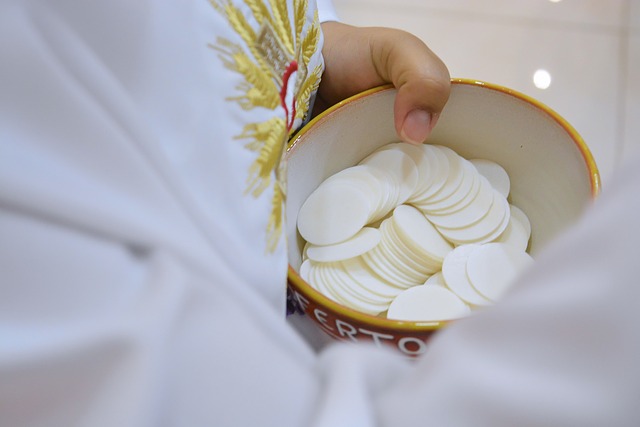
By now, you’ve probably heard the news about the Catholic Church invalidating the use of gluten-free hosts for the sacrament of Holy Communion.
Entire article: http://bit.ly/2tkolUF"
— Low-gluten hosts are valid matter for people who, “for varying and grave reasons, cannot consume bread made in the usual manner,” provided the hosts “contain a sufficient amount of gluten to obtain the confection of bread without the addition of foreign materials and without the use of procedures that would alter the nature of bread.”
— Completely gluten-free hosts continue to be “invalid matter for the celebration of the Eucharist.”
The Vatican's website: The Eucharist and Sacramental Validity, Part 1 CanonLawMadeEasy.com explains (even if a priest had celiac disease): http://bit.ly/2uLEyG9
http://bit.ly/2vptYSY
"Q: One of my fellow-parishioners has a violent allergy to wheat, so he can't receive the Eucharist under the form of bread. He has to receive from the chalice instead. Why can't priests get permission to use some other type of unleavened bread at Mass since some people have this problem? -Helene"
This news has riled up many in the gluten-free community.
It's nothing new and it has been this way for a long time. In the Catholic Church, it is impossible to consecrate anything other than wine (or mustum) and a host made of wheat and water. No priest or bishop can change 2,000 years of tradition and faith.
According to "Celiac Disease and Eucharistic Communion" by Anne Bamberg. The Jurist, 2003, 2001 (61), pp.281-289., the debate began in the 1970s. The large celiac populations of Ireland and Great Britain began asking questions of the Church.
Note from Al: I found Anne Bamberg's article very interesting. I highly recommend it. She describes celiac disease very well and shares some interesting insights into the Catholic faith.
The use of low/no gluten hosts has been reviewed by the Vatican several times over the years.
In 1995, then Cardinal Joseph Ratzinger, Prefect of the Congregation for the Doctrine of the Faith, takes up the subject in his June 19th letter to the Conference of Bishops.
The Cardinal, again validates low-gluten hosts - invalidates the use of gluten-free hosts. He also states:
"Given the centrality of the celebration of the Eucharist in the life of the priest, candidates for the priesthood who are affected by celiac disease or suffer from alcoholism or similar conditions may not be admitted to holy orders."
Yes, this means someone with celiac disease could not be an ordained priest. The Supreme Pontiff did not approve Cardinal Ratzinger's letter as it failed to seek out a favorable solution for sick or disabled persons.
In 2001, then five-year-old Jenny Richardson and her parents made national headlines for leaving the Catholic Church after Cardinal Bernard Law denied her a rice wafer for her First Communion.
In 2003, then Cardinal Joseph Ratzinger (served as Pope from 2005 to 2013), once again revisits the topic…
CONGREGATION FOR THE DOCTRINE OF THE FAITH
Circular Letter to all Presidents of the Episcopal Conferences
concerning the use of low-gluten altar breads and mustum
as matter for the celebration of the Eucharist
24 July 2003
89/78 – 17498
To their Eminences / Excellencies
The Presidents of the Episcopal Conferences
Your Eminence / Excellency:
The Congregation for the Doctrine of the Faith has been for many years studying how to resolve the difficulties that some of the faithful encounter in receiving Holy Communion when for various serious reasons they are unable to consume normal bread or wine.
A number of documents on this question have been issued in the past in the interest of offering Pastors uniform and sure direction (Congregation for the Doctrine of the Faith, Rescriptum, 15 December 1980, in Leges Ecclesiae, 6/4819, 8095-8096; De celebrantis communione, 29 October 1982, in AAS 74, 1982, 1298-1299; Lettera ai Presidenti delle Conferenze Episcopali, 19 June 1995, in Notitiae 31, 1995, 608-610).
In light of the experience of recent years, it has been deemed necessary at this time to return to the topic, taking up the above-mentioned documents and clarifying them wherever necessary.
A. The use of gluten-free hosts and mustum
1. Hosts that are completely gluten-free are invalid matter for the celebration of the Eucharist.
2. Low-gluten hosts (partially gluten-free) are valid matter, provided they contain a sufficient amount of gluten to obtain the confection of bread without the addition of foreign materials and without the use of procedures that would alter the nature of bread.
In this letter, Cardinal Ratzinger addresses a gluten-free priest's inability to receive communion, and re-worded his statement about gluten-free candidates seeking Holy Orders
3. A priest unable to receive Communion under the species of bread, including low-gluten hosts, may not celebrate the Eucharist individually, nor may he preside at a concelebration.
4. Given the centrality of the celebration of the Eucharist in the life of a priest, one must proceed with great caution before admitting to Holy Orders those candidates unable to ingest gluten or alcohol without serious harm.
Read the entire letter: http://bit.ly/2vH6I2c
In 2004, eight-year old Haley Waldman of New Jersey, had her First Communion declared invalid because a rice based wafer was used.
As one would imagine, low-gluten (not gluten-free) hosts would be a hot topic for the gluten-free community. The question becomes, how much gluten is in a low-gluten host?
When the Benedictine Sisters of Perpetual Adoration first created their Low-Gluten Altar Breads, Dr. Alessio Fasano helped test the wafers in 2004. They tested at 100 parts per million. This is 5x more than the FDA currently allows for a gluten-free product.
Ten years later, in 2014, independent testing organization Gluten-Free Watchdog was asked by a subscribing member to test the Benedictine Sisters Low-Gluten wafers. Below are the results…
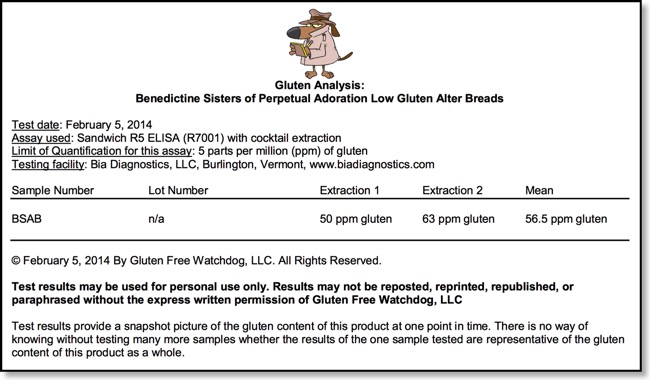
Gluten-Free Watchdog graciously granted GIG of ECW permission to share the testing results.
Thank you, GFWD for your hard work and dedication to the gluten-free community!
If you're not a subscriber, please consider becoming a member. 
Center for Celiac Research at MGHfC Led Efforts for New Definition
http://bit.ly/2uQzqBk
As GFWD points out, parts per million is a ratio. It tells us the amount of gluten per kilogram (2.2 pounds) of food. Knowing the amount of food eaten will determine how much gluten has been consumed.
Testing reveals that a wafer weighs about 33 milligrams and contains .0019 milligrams of gluten.
Gluten-Free Watchdog provides a nice comparative:
A one-ounce slice of gluten-free bread (if it contained 19 ppm of gluten aka gluten-free according to FDA regulations) would contain roughly 0.57 milligrams of gluten.
That slice of GF bread could contain 300 times more gluten than one Low-Gluten Communion wafer.
On July 10th, 2017, two days after the Vatican issued their statement, The Benedictine Sisters of Perpetual Adoration in Clyde, Missouri issued their own statement regarding their wafers.
STATEMENT REGARDING “On the bread and wine for the Eucharist” LETTER SENT BY VATICAN AND MADE PUBLIC JULY 8, 2017
(CLYDE, Mo.) - The Benedictine Sisters of Perpetual Adoration in Clyde, Missouri, have made Vatican-approved, low-gluten altar breads since 2004. These breads have been tested by independent laboratories and deemed safe for use by many people with Celiac Sprue Disease.
The Benedictine Sisters of Perpetual Adoration were the first U.S. low-gluten altar bread producers approved by the Vatican. As early as the 1990s, the Benedictine Sisters started receiving requests for gluten-free hosts. With support from the Office of Divine Worship of the United States Conference of Catholic Bishops, the Benedictine Sisters produced a host compliant with the requirements of Canon Law and suitable for thousands of low-gluten customers around the world. These sales began in 2004, and the wafers have been approved by the USCCB for use in all U.S. dioceses.
The Benedictine Sisters are the largest religious producers of altar breads in the United States, making almost 9 million hosts each month. The low-gluten breads are produced in a separate facility in order to prevent cross-contamination. The low-gluten breads are made from water and wheat starch that has had most of the gluten removed.
In 2004 Dr. Alessio Fasano, at the time director of the the Center for Celiac Research at the University of Maryland*, maintained that the amount of gluten contained in one of the Benedictine Sisters’ low-gluten altar breads (tested at < .01 percent) was so minute that someone diagnosed with Celiac Sprue Disease would have to consume 270 wafers daily in order to reach the danger point. A test done in 2016 indicated the gluten content was even more minimal - less than .001 percent.
There are some people who are so sensitive to gluten that even the tiniest amount can cause discomfort. The Benedictine Sisters follow the recommendation set forth by the USCCB that those with such a serious gluten sensitivity discuss their condition with their pastor or Eucharistic minister. If the parish offers a separate chalice for Celiac sufferers, he or she may partake only of the Blood of Christ. It's best to avoid chalices that are used by those digesting regular altar breads because cross-contamination may occur.
More information about the Benedictine Sisters’ low-gluten breads can be found at https://altarbreadsbspa.com/low-gluten-use-storage/.
*Dr. Fasano is now with the Center for Celiac Research and Treatment at Massachusetts General Hospital in Boston.
For more information, please contact one of the following:
Tim Stiff, Altar Bread Manager
(660) 944-2227 or (800) 223-2772
tim.stiff@benedictinesisters.org
Sister Ruth Elaine Starman, OSB, BSPA General Councilor
(660) 944-2227 or (800) 223-2772
ruth.starman@gmail.com
Source: http://bit.ly/2gRaZh1
You may have noticed above I bolded "A test done in 2016 indicated the gluten content was even more minimal - less than .001 percent" .
I completely missed that upon my first read through. It's a very important sentence to the gluten-free community. The Sisters use decimal percentage numbers in their communiques instead of parts per million. For those "mathematically challenged" individuals (yeah, that's me alright!), it doesn't sink in too well.
If we do the math (What?!?! I was told there'd be no math!), we find that .001% of gluten is really…drumroll please…10 parts per million. TA DA!
On July 18th, Center for Celiac Research and Treatment issued their response in a video.
Dr. Alessio Fasano: "…provided there is some form of wheat in the wafer - no matter how much - that would be valid for communion. That’s the reason why the Benedictine Nuns produced these wafers that has 10 parts per million and they’re safe - so that definitely you have to be [?extremely religious? hard to make out those two words] to be over the threshold - in other words you’d have to take hundreds of those to be in trouble. Nothing has changed."
Pam Cureton, RD, LDN: “The wafers - that the Benedictine Sisters when they first started producing them in 2004, they were 100 parts per million. But in a recent letter they sent out on this subject, they have retested their wafers and they are less than 10 parts per million - so completely safe for those with celiac disease."
As I was watching this "disturbance in the force" play out, I was becoming more and more disheartened. People were upset with the Church, people were upset with organized religion in general. I was seeing a lot of stone casting, but no one focused on "How much gluten constitutes a low-gluten wafer?"
Making choices about ones diet is a personal matter. Factor in a spiritual practice, and it complicates the matter exponentially.
If you're not the religious type, this situation may not make much sense to you. That's fine, this is not your issue to tackle. Please feel free to move on to a more suitable topic.
If you are the religious type, particularly Catholic, this situation was likely to induce some level of stress.
Sometimes, difficult decisions must be made. I share these facts neither in-favor-of nor opposition-to, but in an effort to help others make an informed decision.
We now know a low-gluten wafer contains magnitudes less gluten than a slice of gluten-free bread.
The wafers from The Benedictine Sisters might very well qualify for gluten-free certification (made in a dedicated GF facility and less than 10 parts per million of gluten).
I hope these facts make it easier for someone to reconcile this conundrum.
Alan Klapperich - Branch Manager
GiG of East Central Wisconsin
GIG.EastCentralWisconsin@gluten.org
http://gigofecw.org/
http://facebook.com/gigofecw
Gluten-Free Road Trip
Alan Klapperich
Gluten Intolerance Group of East Central Wisconsin
Update: 06/12/19 - Add GIG Summer Vacation link.

Once considered a toy for the rich and powerful, mass production methods made cars available to the general population. Since the early 1900s, this piece of machinery changed not only how we travel, but life as we know it.
There’s no denying the call of the open road. The 4 million miles of public roads in the United States offer a freedom that’s hard to match.

Most of us have childhood memories of that thing we call a “family vacation.” It involves piling everyone and only their “most essential” belongings into the family vehicle for the seemingly never-ending cross-country trek to somewhere or some obscure relative.
Traveling is one of the challenges we encounter in the gluten-free lifestyle. Leaving the safety of your home can be unsettling - even for the most experienced. With a little planning and some creativity, we can make it a trip we remember for a lifetime.
Traveling by car/van/Wagon Family Truckster/Vista Cruiser is not the fastest mode of transportation, but it’s readily accessible, the most economical, and indeed the most flexible method.
Arrive two hours before departure. Stand in endless lines. Put up with ill-tempered TSA agents eagerly waiting to do full body searches. Pay for going six ounces over the fifty-pound weight limit for luggage. Fahgettaboudit - we’re calling the shots - we’re traveling on our terms. Heck, we can take 50 pounds of shoes if we want! However, we’ll be using our space more effectively by toting 45 pounds of food and only 5 pounds of shoes. Hey, we gotta be comfortable walking around the world’s largest ball of twine, right?

A successful trip starts before you even insert the key into the ignition. Planning is an essential part of the equation - it’s even more critical on a gluten-free road trip.
I’m going to assume you’ve already had your vehicle checked over and verified its road-worthiness. No one wants a breakdown on the way Neillsville, WI to see Chatty Belle, the world’s largest talking cow.
Are you ready to start your gluten-free road trip? Let’s go!
Create an Itinerary.
Local support groups can be invaluable when it comes to finding trusted sources of food. As you well know, groups and their most humble leaders are amazing resources.
Mapping sites
- Mapping sites allow you to get directions to and from desired locations.
- Get a bird’s eye view of the area.
- Great reconnaissance tools.
- Create maps with your points of interest in order to quickly see how close or far these spots are from one another.
How far is that gluten-free restaurant from our hotel?
Google Maps
MapQuest
Bing Maps
Rand McNally
Trip Planning Websites
NOTE: No personal experience with these sites, but will be investigating them closer.
Roadtrippers
TripHobo
PlanApple
Lodging
Find, Research, and book hotel rooms. I always use TripAdvisor to vet hotels. Guest comments are constructive.
TripAdvisor
Kayak
Travelocity
We do best if we plan for breakfast and lunch. For dinner, we try to seek out a reputable restaurant - of course - if, at all possible, this is mapped out ahead of time.
Many hotels offer free continental breakfasts, but gluten-free options are usually limited to fresh fruit. If you’re lucky, you might find hard-boiled eggs. Luckily, you brought your own!
When selecting a hotel, get a room with a microwave and fridge. Having these essential tools on hand makes it a bit more convenient. If you’re staying longer than overnight, find a place with a kitchenette. Of course, this means packing some basic cooking equipment.
Stocking Your Mobile Pantry.
Since you’ve already scouted out some potential grocery stores at your stopping points, you can gauge how much food you’ll need to bring along for each leg of your Tour de ‘Merica.
Grab your favorite gluten-free crackers, pretzels, bread, snack bars, beef jerky or meat sticks, sandwich meat, packets/cans of tuna, hard-boiled eggs.
Make up a cold pasta or tuna salad the night before you leave; this makes for a great lunch the next day. While you’re at it, fry up a pound or two of bacon (crispy please). You’ll be happy you did when you have access to a microwave.
Don’t forget your favorite fruits (whole apples, bananas, oranges, grapes, watermelon, cantaloupe, strawberries) and veggies (carrots, sliced bell pepper, broccoli and cauliflower florets, celery, snap pea pods, cucumber slices, cherry tomatoes).
No road trip is complete without a big batch of trail mix (a variety of nuts, dried fruits, chocolate chips or M&Ms…and anything else you like - be creative).
Prepping some of the foods ahead of time will pay big dividends when you’re out on the road. Washing, slicing, pealing, and packaging foods will make them easier to eat. Put these foods into sealable air/water tight containers - like Ziplock Containers/bags, or Tupperware brand containers.
Toaster Bags
Practice safe-toasting. You’re hankering for a piece of gluten-free toast, but you can’t find a gluten-free toaster anywhere. No problem, toaster bags to the rescue!
Toaster Bags - Amazon
Individual/Travel Sized Products
Minimus.biz offers over 2,500 food & non-food products. A most interesting website!
Gluten-Free Food
“Only food products that have been labeled by the manufacturer as being Gluten Free are listed here in our Gluten Free Food shopping aisle. Though other products may also qualify as Gluten Free, they are not marked by the manufacturer. “
Improper food storage can result in food-borne illness; in severe cases, it can be deadly. Bacteria thrive and multiply quickly in warmer temperatures. The danger zone falls between 40 and 140 degrees. Without refrigeration or a heat source, perishable food should not be left out for more than two hours if the temperature is below 90 degrees. Reduce that time to one hour if the temperature is at or above 90 degrees. Keep cold foods at or below 40 degrees and hot foods at or above 140 degrees. Throw an appliance thermometer in the cooler to keep an eye on the temperature.
Coolers come in many sizes, shapes, and materials (soft-sided and hard sided). They range from low-tech styrofoam to hi-tech iceless car battery/AC powered travel coolers and refrigerators. The hard sided coolers offer extended cooling than soft sided. Spend some time researching which type of cooler is right for your needs - it’s worth the investment of time.
If you’re going old school with a traditional non-powered cooler, you’ll need to think about the type of ice to use. What?!? Ice is ice, no?
Crushed ice or cubes cool items faster, but blocks of ice last longer. Dry ice is also an option, but requires some special handling - we won’t cover that here.
Cube ice & water mixture is excellent for cooling beverages, but tends to be messy and doesn’t mix well with food. Soggy food is never good eats.
The best option is block ice - even better when the block is inside a container like a plastic bottle or sealable container; this helps in reducing the amount of water in your cooler.
The best bottles I’ve found are Simply Lemonade/OJ/Apple Juice/etc. 88.93 and 59 oz. Also Pure Leaf Iced Tea 64 oz. What I like about these bottles - they’re not round and have relatively flat sides - this means better contact with food for maximum cooling.
Pure Leaf Iced Tea 18oz bottles are perfect for smaller spaces. All of these bottles are made of thicker plastic and hold up very well. We use them almost weekly for grocery shopping expeditions. Soda bottles work well too.
You can also freeze water in quart sized Ziploc freezer bags or the 3” thick Ziploc rectangular containers. I’d prefer the containers over the bags. The flat ice blocks can come in handy when layering items in the cooler.
Remember, water expands when it freezes. Do not fill bottles/containers all the way to the top - leave some room for expansion.
Cooler Reviews
Looking for your first cooler? Looking to add another one to your collection? Here’s a few sites offering their reviews of different brands/models.
Good Housekeeping
Field & Stream (High End - $$$)
Outdoor Gear Lab
Best Cooler
Air & Water Tight Containers
Wondering about food storage options? Check out these containers:
LockNLock
TupperWare Brand
Food Cold Storage Times
How long can I keep foods?
Univ. of MN Extension Food Safety
Wash it before & after using. These guys usually are stored in the basement, in the garage, under the crawl space, in the attic. They can be hot and dirty. If they’re not clean and dry, the inside can get funky. No one likes Cooler Funk.
Pre-chill the cooler with ice and water mixture for a few hours before packing; this will ensure the cooler is chillin’. Discard the pre-chill ice bath.
Don’t pack room temperature or warm items. These items make the ice melt faster, plus it takes a long time for them to get cold. Make sure everything you pack in the cooler is already cold. For most food, it’ll be coming cold from the fridge or the freezer, but for things like beverages - it’s best to pre-chill them - just like the cooler.
Store foods in air/watertight containers. I mentioned this above, but it bears repeating. You don’t want cooler water seeping into your food. Ewww, just ewww. Tupperware brand containers are supposed to be the cat’s meow for this type of storage. Canning jars with the rubber-ringed covers would work too, but they’re glass and have the potential to break if dropped.
Place ice (whatever form you use) on the bottom of cooler. Place the perishable foods - those that need to be kept cold the most (pasta/potato salads, meats, dairy, eggs, etc.) closest to or directly on the ice. Build layers of ice/food/ice using those flat rectangular containers or Ziploc bags containing ice. Items on top of the cooler should require the least amount of cold.
Keep the lid closed of your food cooler as much as possible.
Have a separate beverage cooler if you have the room. A smaller one to keep a couple of bottles of your favorite beverage. It’ll help you stay out of the food cooler.
A full cooler stays colder, longer. If you start to run low on items in the cooler - add nonperishable foods, or even a blanket to take up space.
Keep the cooler out of the sun. Keep the cooler inside the car where there’s air conditioning - not in the trunk.
Find Local Gluten-Free Support Groups
Always check your destination for the nearest local support group. They’ll be able to direct you to places to shop and dine.
GIG of ECW Local Support Groups
Find Local Gluten-Free Dining
A few resources to help narrow down your dining selections.
Always ask questions and use your best discretion when dining out. If you’re not comfortable, politely leave.
AllergyEats
Gluten-Free Passport
(Smartphone app not free)
FindMeGlutenFree
Gluten Intolerance Group Links
Summer Vacation Roadstop Smarts
Traveling Gluten Free
Restaurant Dining - 7 tips for staying gluten-free
Easy to Find & Fix Snacks
GF Certified Food Services
Keep all snacks in a clear tote bag or container of some type. You’ll always know where they are and you’ll be able to see which container to grab.
In the same container keep some paper towels, wet wipes, or a damp washcloth in a ziplock bag. You’ll want to wash those paws after snacking.
Salt/pepper/seasonings goes in the same container.
Non-Food Stuff.
Eating utensils - disposable or non disposable - your choice.
Paper plates/bowls/cups
Couple of kitchen knives - paring and steak knife.
Small flexible cutting board
Roll of paper towels
Trash bags
Dish soap
Simple On the Go foods:
Yogurt with granola
Hard boiled eggs
Peanut butter
Sliced cheese
Lunch meats
Meat Sticks/Jerky
Canned/Packet Tuna
Summer sausage
Crackers/pretzels/rice cakes
Granola Bars
Trail Mix
Nuts
Grapes
Protein Bars/Snack Bars
Hopefully these hints and tips have inspired you to plan your next great gluten-free adventure.
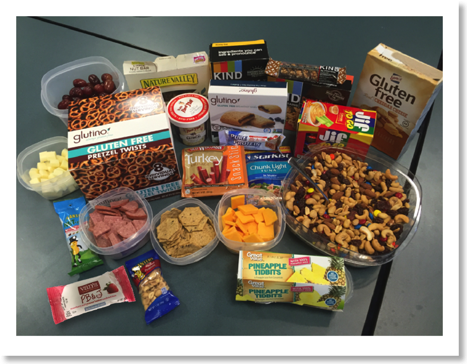

Grain-Free for the Gluten-Free
At this stage of the game, you’ve probably heard about some type of low or no carb diet template. As the name suggests, these diets remove all grains - yes, even the gluten-free grains.
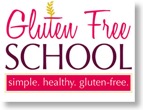
Hidden Danger of “Grain Free” Food Companies Don’t Want You to Know
by Jennifer Fugo of GlutenFreeSchool.com
Jennifer’s excellent article explores several facets - benefits and the hidden danger - of grain-free foods.
“Grain free is not (nor may ever be) a safe substitute for gluten free, nor is any sort of paleo certification labeling.“
Full Article: http://bit.ly/1mJMakK
Grain-free diets are known by several different names: Specific Carbohydrate Diet (SCD), Caveman, Ancestral, Paleolithic, Gut and Psychology Syndrome Diet (GAPS), Autoimmune Paleo Diet (AIP), Wheat Belly.
These diets tout a host of benefits that extend beyond a traditional gluten-free diet. Many members of the gluten-free community feel best when they’re grain-free as well.
By definition, grain-free should be gluten-free. “Gluten” is the generic name for the various proteins found in grains. You ditch the grains, you ditch the gluten. It’s a no-brainer! Um, not so fast Slick…
The purpose of this article is to make you aware of an important fact that is not always discussed by the proponents of grain-free diets.
Don't be lulled into a false sense of gluten-free safety by a grain-free food - even though it may be “Paleo Certified”. Sure, the food itself may be naturally gluten-free, but gluten-cross contamination could still be a threat. My concern is for those who may not know to be concerned about cross contact. The unknowing may wonder why they’re not feeling better while being grain-free due to gluten contamination.
Read more: http://bit.ly/1OQVXSN
Gluten contamination of grains, seeds, and flours in the United States: a pilot study - July 2010
Tricia Thompson, MS, RD, Ann Lee, EdD(c), RD, LD, and Thomas Grace
This study tested twenty-two single ingredient naturally gluten-free grains, seeds and flours.
“Gluten contamination of inherently gluten-free grains, seeds, and flours not labeled gluten-free is a legitimate concern.”
Almond flour, coconut flour, chick pea flour, flax seeds (whole or ground), whole nuts of all kinds, herbs, spices, and seasonings are some of the popular ingredients in many grain-free foods. Sure, those are all single ingredient foods - but if these foods are ground, processed, packaged on lines used for gluten containing foods, then the end product could have detrimental levels of gluten.
The bottom-line for those with gluten-related disorders who want to be grain-free - make sure your grain-free foods/ingredients are labeled or certified gluten-free.
Alan Klapperich
GIG of ECW Branch Manager
Gluten-Free Gratitude
I cross paths with many members in the gluten-free community who are troubled, angry, and hurting [both emotionally and physically]. These interactions leave me with a heavy heart. Just maybe, the information found here might help ease the pain - just a little bit.
Stay strong. Keep moving forward.
Peace and blessings,
Alan Klapperch
GIG of ECW Branch Manager
A special thank you to Pastor Kimberly Stowell [my spiritual leader] for "planting the seed". This article was inspired by a recent sermon.
"This being human is a guest house.
Every morning a new arrival.
A joy, a depression, a meanness,
some momentary awareness comes
as an unexpected visitor.
Welcome and entertain them all!
Even if they're a crowd of sorrows,
who violently sweep your house
empty of its furniture,
still, treat each guest honorably,
He may be clearing you out
for some new delight.
The dark thought, the shame,
the malice, meet them at the door laughing, and invite them in.
Be grateful for whoever comes,
because each has been sent
as a guide from beyond."
Jalal Al-Din Rumi
Translation by Coleman Barks
Rumi's "The Guest House" poem reminds us to welcome all of our life experiences, even those we consider less desirable.
The emotions we encounter in this life offer us the ability to enter a new state of being - to learn something new about ourselves. Perhaps, they may be preparing us for greater things to come.
No one decides one day to play host to a gluten-related disorder. I know I didn't. This "unexpected visitor" appeared - liked the new digs and decided to hang around. In my heart of hearts, the path that I have traveled is not one I would have chosen. I am eternally thankful for what nutritionist and author, Melissa Diane Smith calls “the gift of gluten-free.” All those years ago, when I was lying on the living room floor in the fetal position, I could not have imagined what was in store for me [besides death].
I had to give up gluten, but what I have received in return is beyond measure.
It took a while to realize it, but I was given an opportunity to use my skills and talents to help others. I discovered talents I didn't know I had! The biggest gem unearthed in me was a passion and a purpose - something that was lacking in my life previously.
I consider myself an ordinary, average guy. If this transformation can happen to me, it can happen for you.
It doesn’t take long to realize that going gluten-free changes our life - forever.
This new reality hits us with the force of a speeding freight train. In some cases, it comes out of nowhere. No lights, no whistles, no warning what so ever. WHAM! Our life shatters into a million pieces.

With increased rates of anxiety and depression, it’s no wonder those with gluten-related disorders consider ourselves to have a lower quality of life than our peers. As we might expect, grief soon appears. We need to allow ourselves to process those feelings. It’s easy to understand how we could get caught up in a never-ending downward spiral of negativity and despair. There are days we feel as if there is no way out.
I’ve painted a rather dark and brooding [albeit realistic] picture of what it's like to live with a gluten-related disorder. For some, it's all of this and more. For others, they adapt and adjust with minimal or no hardship. We would see similar pictures if we explored other chronic health conditions or tragic life circumstances..
We can’t help but wonder, will we ever feel better about our situation? Is there a way break out of these emotional and physical shackles? YES!
GRATITUDE A Professor of psychology at University of California, Davis and director of Emmons Lab. His focus is on the science of gratitude and its effects on health and wellbeing. 
“Gratitude heals, energizes, and transforms lives. We are engaged in a long-term research project designed to create and disseminate a large body of novel scientific data on the nature of gratitude, its causes, and its potential consequences for human health and well-being. Scientists are latecomers to the concept of gratitude. Religions and philosophies have long embraced gratitude as an indispensable manifestation of virtue, and an integral component of health, wholeness, and well-being.”
Author of several books including: “Thanks!: How Practicing Gratitude Can Make you Happier” and “Gratitude Works!: A 21-Day Program for Creating Emotional Prosperity”
What is gratitude?
Dr. Emmons defines gratitude as:
He maintains that gratitude consists of two key components: affirmation of goodness, and knowing where it originates. He writes:
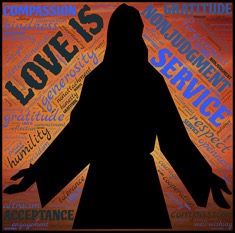
I think it's safe to say that every gluten-free person has ridden an emotional roller coaster. People suffer for years [6 – 10 years on average]; endure numerous doctor's office visits and usually walk away with more questions than answers. Frustrating, to say the least. The result of finally getting answers to the on-going health issues brings an immediate sigh of relief, almost a giddiness. “WHEW, I finally know what's wrong with me!”
All too quickly that euphoria dissipates when reality comes calling - “What am I going eat and how am I going to handle this?” Convenience – gone. Care-free dining – adios. The joy of family gatherings - replaced with dread and worry. Things that took little or no thought - now rivals the logistics of a Mars Rover launch.
For many of us, this transition can be a difficult time.
By Robert Emmons, PH.D.
A decade’s worth of research on gratitude has shown me that when life is going well, gratitude allows us to celebrate and magnify the goodness. But what about when life goes badly? In the midst of the economic maelstrom that has gripped our country, I have often been asked if people can—or even should—feel grateful under such dire circumstances.”
Read More: http://bit.ly/2feicp2
At first glance, the gluten-free lifestyle means giving up a lot of things. However, as we start picking up the pieces of our life and clearing away the debris, we discover that goodness is still there. It has not abandoned us; it is merely manifesting itself in different ways - ways that are unfamiliar to us. Somedays, we may need to dig damn hard and deep to find the goodness.
Gratitude allows us to focus on what we have instead of what was taken away.
Let’s explore a few of these gluten-free gifts. Probably the most obvious and precious gift is the opportunity to improve our health. The gift of love from someone who cares for us when we don’t feel well. The gift of compassion from our best friend or loved one who is learning right alongside us - cheering us on - being our gluten-free champion. The gift of kindness from a stranger in the gluten-free aisle at the grocery store as they help us avoid a nuclear meltdown because we don’t know which product to get. The gift of friendship as we meet others in the gluten-free community; we realize we are not isolated, nor alone. The gift of comfort when we find a product that is labeled and certified gluten-free. These examples scratch the surface.
For over a decade, Dr. Emmons and his associates have scientifically documented the social, physical, and psychological benefits of gratitude.
- Gratitude increases happiness.
- Gratitude reduces anxiety and depression.
- Gratitude blocks negative emotions.
- Gratitude improves health: strengthens the immune system, reduces blood pressure, lessens symptoms of illness, decreases awareness of aches and pains.
- Gratitude improves sleep. Better sleep is an important factor in improving overall health.
- Gratitude promotes forgivness.
- Gratitude fosters a “pay it forward” attitude.
- Gratitude strengthens relationships.
The Power of Gratitude: http://bit.ly/2ejTxQr
What Good is Gratitude? http://bit.ly/2feq4a6
The Benefits of Gratitude: http://bit.ly/2fAOX0e
Gratitude sounds great, but how can we best harvest these transformative powers?
Cultivating an attitude of gratitude takes a bit of work and practice. At first, you may feel uncomfortable or awkward doing it. You may be wobbly and unsteady, just like taking your first steps or your first attempt at riding a bike. You might even find it emotionally painful - you know - kind of like those muscles you didn’t know you had until after raking the lawn. Like any skill or activity, the more we do it, the better we get. It is best to start slow and work your way up.
Dr. Emmons suggests these exercises to get started. Please be sure to click the links for a more detailed description of these exercises and the reasons why they work:
- Count your Blessings: Regularly make mental notes of your blessings - no need to write them down. Do it first thing in the morning or before going to sleep. Ask yourself, “What am I grateful for today?”z
- Three Good Things: For a minimum of one week, write down three things that went well each day. Small or large events - it doesn’t matter. A tangible, written paper trail is essential. In detail, explain why things went well. Capture how you felt at the time and how you felt when remembering the event. Share your thoughts about what caused the event. If you happen to focus on negative feelings - shift focus toward the good events and those positive feelings.
- Gratitude Letter: Write a letter to someone who did something for which you are grateful, but you’ve not fully shared your gratitude. It’s best if this person is still alive - someone you can meet face-to-face. When you meet, read them the letter. Take note of their reaction as well as your reaction. Together, discuss your feelings about the letter.
- Savoring Walk: For a minimum of one week, go for a 20-minute walk. Take a different route each day. During this time, notice as many positive things as you can - sights, sounds, smells, and touches. As you notice something, pause a moment and understand why it’s pleasurable to you.
- Keep a Gratitude Journal: This is similar to Three Good Things above but more in-depth. Evidence shows journalling one to three times per week elevates happiness better than daily writing. For a minimum of two weeks - at least once a week for 15 minutes, describe up to five things for which you feel grateful.
By Robert Emmons, PH.D.
Read More:
Some people find they do better when surrounded by others - like having a workout partner(s). Participating with another person or a group of people inspires and motivates them to continue.
We know the power behind the act of expressing our own gratitude - participating with a group of people expressing their gratitude has to multiply that power - right?
If you are on Facebook and interested in participating in such a group, I invite you to check out PK Gratitude Mission.
This is a closed group, created by Pastor Kimberly Stowell - my pastor and spiritual leader of St. Stephen's Lutheran Church, Rogersville, Wisconsin (home of the gluten-free communion). Only members of the group can participate and see the posts to the group, so you’ll need to request to join or be invited.
When asked about the purpose of the group, Pastor Kimberly says: “The Gratitude Mission is about helping and upifting others.”
If large groups frighten you, fear not. Currently this group is small; consisting of less than 80 people. Everyone is kind, courteous, and respectful. I am a member; I find witnessing other people’s gratitude moving and inspirational.
~oOo~
Thank you for your time. I will leave you with one final message of inspiration…
“When life gets you down, you know what you gotta do?
Just keep swimming,
Just keep swimming,
Just keep swimming swimming swimming,
What do we do we swim swim swim”
~Dory
Finding Nemo
Alan Klapperich
GIG of ECW Branch Manager
Gluten-Free Champion
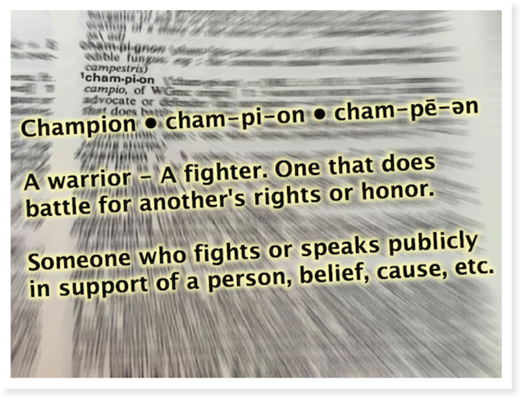
Your spouse, family member, or friend has suffered from recurring health issues for years. You’ve seen them at their best, and at rock bottom. Regardless of how long they’ve been suffering, you don’t like to see it.
Finally, someone figures it out; your loved one has just told you they must be gluten-free. You’re not really sure what gluten-free is or what it means, but you politely listen to their brief explanation and nod your head sympathetically.
“Wow,” you think. “That sounds horrible. Sure glad I don’t have to go through that.”
Sorry to break the news, but pack your bags – you’re going on the journey with them. Why? Because you are a caring, compassionate human being and you want them to be healthy and happy. Good for you!
If you’re a spouse, you made that commitment when you said, “I do.” If you’re a friend, you signed up when you accepted their most precious gift of trust. If you’re a family member, your name has been on the trip’s manifest since birth. They deserve your respect and help because that’s just what family members do for one another.
“…but, I know nothing about this, how can I be so important?”
The important take-away here – you have the power to help them. Your support in this effort is crucial; it could mean the difference between their success and failure.
Support doesn’t require money, or even specialized knowledge. It can be as simple as just being there for them in whatever way they need you - a smile, a hug, a sympathetic ear, or a strong shoulder. It can also be much, much more.

You may not know it, but hiding beneath your street clothes is a superhero’s suit just waiting to be called into action.
We have a few tips and wealth of information in The Gluten-Free Champion’s Academy (see below) to help you make the leap.
Peggy’s Story
What do you do when someone you love gets sick? What do you do when nothing helps them to feel better? What do you do when your best friend, your soul mate and your life partner has changed so drastically that you barely recognize him...
That was the position I found myself in about 14 years ago. It all started gradually, an upset stomach here, some foot pain there, a little more burping and belching than usual. Nothing big, until it got big. When my normally cheerful, energetic, quick to laugh husband was replaced by a pale, thin, ill man I hardly recognized. A person who sat listlessly staring into space not wanting to see friends or attend family functions for no other reason than "I just don't feel good”.
As the complaints increased there was much "encouragement" to see the doctor and get these thing "checked out". The assumption was that a test or two would pinpoint the problem and a medication would be prescribed and everything would be fine.
That’s not what happened. A test or two turned into multiple tests and multiple doctors which did not find the root of the problem. Medications were prescribed that only helped a little or not at all. No real answers were to be found. In the meantime Al continued to get sicker, I felt even more helpless.
I worked in healthcare for God's sake, someone, somewhere must have some idea, something that would make him well again. With increasing frustration and fear, I often found myself crying in the shower so he wouldn't know how afraid I was. I wondered if he were dying as I was just standing by helplessly, watching.
Fast forward to March 2003 where we find ourselves on a white sandy beach surrounded by the beautiful turquoise blue water of Jamaica. When my unwell husband requested a vacation to somewhere warm, I, his loving and dutiful wife made it happen! That March was my turning point.
Al had been doing a lot of research and discovery about this thing called gluten and it's effects on some people. While the discoveries he was sharing with me were very counter intuitive; [read what do you mean crackers and toast can give you a belly ache?] they oddly sounded like him and his symptoms. His gastro doctor was willing to take intestinal biopsies for celiac disease, however the samples did not show intestinal damage. Finding non-celiac gluten sensitivity presented with similar symptoms without intestinal damage, Al started experimenting with a “gluten-free” diet but, the first real evidence I saw happened in Jamaica.
Before the week ended I had my husband back! The energetic guy who was actually looking for a pickup volleyball game! Some may say it was the magic of Jamaica and I won't disagree, but a large part of that magic was the naturally gluten-free diet that he ate.
That week "sealed the deal" for me. Any time that Al would question himself about whether being gluten-free was really the root of the problem or not, my mind went back to that week and the health it brought.
There were plenty of times the groceries I brought home went to the local food pantry because l had made the wrong choices; gluten-free labeling laws didn’t exist then. Full loaves of bread and bowls of pasta were chucked into the garbage because they were so bad Al couldn't eat them. The first batch of beautiful gluten-free cookies came out of the oven only to disintegrate into dust when I tried to take them off the pan! We learned from those experiences and tried to make things better the next time. We didn’t give up. I think the key word is we, I think that Al has been just as much of a support to me as I have been to him. He has always encouraged my efforts and has been appreciative of them.
As the gluten-free lifestyle became our new normal, it became more important to me that it be “normal”. When I was asked by family and friends about the diet, I always responded there are more things he can have than things he can't.
It also became my goal to show people that gluten-free was not synonymous with taste-free. I have always enjoyed cooking and baking for people. Nothing gives me more pleasure than to have someone eat and enjoy what I have made and then ask me to make it again. Slowly, I continued transforming all Al's favorite gluten-full treats to gluten-free treats. It became my passion to learn new ways of baking so others wouldn’t feel left-out. And then to be able to pass on what I had learned to others just added to my joy. It has become my way of supporting and helping others on their gluten-free journey. In my humble opinion no one, gluten-free or not should ever go without a good cookie or piece of cake!
Al and I have also been blessed with supportive family and friends. Their willingness to make sure Al can eat safely in their homes has been a Godsend to us. Their efforts have not gone unnoticed or unappreciated and have made my job as main support so much easier.
I never considered myself a "champion", but according to the definition, I am and will continue to stay the course.
- Tuli Kupferberg
You’ve probably discovered this will be a life changing event. It is not simply a change in diet - it’s a change in lifestyle. The cold, hard truth - it affects every aspect of day-to-day living. Not only for your gluten-free loved one, but for you too. Because of your relationship you will experience these changes with them, albeit in a different way.
Knowing how to deal with change is important. Change is never easy. In fact, it’s one of the most difficult aspects of this. It will take time and effort, but the gluten-free lifestyle will become the new normal both inside and outside your home.
As with anything new, there will be challenges to navigate and some things will need to change to keep your loved one safe.
Embrace these changes and you will see all the good things that will come with your new normal.
Know what you are dealing with.
Knowledge is your friend. Once it has been determined that gluten is the culprit making your loved one ill, learn about it.
You don't need to know the exact science, but have a basic understanding of what happens to the body when gluten is ingested, how can it make that body feel, where gluten is found and what should be avoided.
You will need to adjust how much you know around your loved one’s knowledge. If your situation requires you to be the “guardian of the knowledge” (e.g. for your child) you’ll slowly want to pass that knowledge on to them. Teach them how to look for gluten and know its hiding places, teach them how to cook.
Communicate
As in most things, communication is key. An essential element of communication is listening. Your loved one is going through so many changes, both physical and emotional. If they are newly diagnosed there is a grieving process to navigate. Sometimes they may need someone to listen to their frustrations and fears...not offer opinions and solutions, but just to listen.

When emotions boil over, things can be said in the “heat of the moment”. Conversations can quickly turn into confrontations, further damaging the relationship. It’s important to know the difference between the two.
Conversations are fueled by curiosity.
Confrontations have an aura of a judicial proceeding.
Conversations frame a problem as something to be solved.
Confrontations have an element of moral superiority.
Conversations happen between equals.
Confrontations shield the confronter from any responsibility.
Conversations say “we’re in this together."
Conversations will preserve the relationships while the people involved work toward understanding and solutions.”
~Marie Hartwell-Walker, Ed.D.
Source: http://bit.ly/1GQw2q1
Beside working through the physical and emotional elements, there will be many practical, day-to-day things that need to be discussed. Meal and menu changes, how to handle kitchen clean up and what precautions need to be taken to avoid cross contamination or make the house totally gluten-free, how to replace those family favorite foods with a good gluten-free alternatives.
You may need to communicate with family and friends about the new diet and the importance of your loved one's need to not deviate from it. Yes, a little bit of gluten does hurt!
Being open to and answering their questions and planning strategies on how to manage family functions and parties will be a large part of the communication process.
Warning: Family members can be difficult and unsupportive.
You may also need to convey gluten-free requirements to people outside your immediate circle - servers in restaurants, the pharmacist at the drug store, and the pastor at church, and yes - even medical professionals.
Be clear, concise and confident in your communications.
~0~
Sometimes your gluten-free loved one isn’t taken seriously, so it helps to have another person [like yourself] be an ambassador - an advocate [fancy words for a “kick-ass champion”]. Someone who will travel not ahead, nor behind, but beside them on the path to gluten-freedom.
It may be trying at times, but please understand they are not being difficult on purpose. Everyone wants to be happy and healthy, for some it requires a bit more effort.
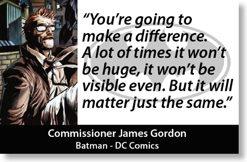
There may be days when you feel like you are not making an impact, but know you are an important team member. Not every hit is a home run, and sometimes a superhero simply helps someone cross the street. No act of kindness is too small.
Kudos to you for stepping up and becoming a Gluten-Free Champion!
Peggy & Alan Klapperich
Gluten Intolerance Group of East Central Wisconsin
P.S. Your cape should arrive within four to six weeks.
“To laugh often and love much; to win the respect of intelligent persons and the affection of children; to earn the approbation of honest citizens and endure the betrayal of false friends; to appreciate beauty; to find the best in others; to give of one’s self; to leave the world a bit better, whether by a healthy child, a garden patch or a redeemed social condition; to have played and laughed with enthusiasm and sung with exultation; to know even one life has breathed easier because you have lived—this is to have succeeded.”
report relationship burden
Healio Gastroenterology article by Will Offit
“As much as 37% of partners of patients with celiac disease reported relationship burden, according to a study presented at Digestive Disease Week 2016.
Given the multifaceted manner in which celiac disease can affect patients, it's not unreasonable to expect that the impact of celiac disease may extend to their relationship partners,” Abhik Roy, MD, gastroenterologist at New York-Presbyterian University Hospital of Columbia and Cornell, said during a presentation. “Our study shows that partner burden is quite common in celiac disease with more than one-third of partners experiencing at least mild to moderate burden.”
Our study shows that partner burden is quite common in celiac disease with more than one-third of partners experiencing at least mild to moderate burden.
The degree of burden found in this study was similar to that reported for IBS and cancer, the researchers wrote. In addition, the researchers recommended that health care providers address these relationship factors in their care of patients with celiac disease.
As patients and partners progress in their relationships, the burden of celiac disease seems to shift from the short term focus on diagnosis and dietary modifications to the prognostic implications and uncertainties of a chronic illness,” Roy said. “This illustrates the emotional burden of celiac disease and stresses the importance of including the partner in clinical education and counseling."
What is gluten?
Where is gluten found?
It’s even found in personal care, hair and beauty products.
How Much Gluten?
Not only must the food be gluten-free, it must not come in contact with any gluten.
Yes, even a small crumb can cause problems!
Studies have shown that some celiacs could consume up to 10 milligrams of gluten per day. (10mg = 1/8th of a teaspoon of flour).
How much is 10mg? An average grain of rice weighs 28 mg. 1/3 of a grain is just under 10 mg.
BUT - For many, even 10 mg is too much.
No gluten is the goal.
What is Celiac Disease?
Untreated, this condition can lead to: malnutrition since nutrients are not being absorbed properly, additional autoimmune diseases, increased risk of certain cancers.
Learn more:
http://bit.ly/1Nhdden
What is Non-Celiac Gluten Sensitivity (NCGS)?
NCGS can present with many of the same symptoms of CD, however it does not present with same autoimmune intestinal damage. The lack of intestinal damage does not make this condition any less severe than celiac disease. Damage can occur in other body parts.
Learn more:
http://bit.ly/1oMsOfA
How do we deal with the changes?
by Alan Klapperich
http://bit.ly/GIGECW-Change
I want to give you a basic understanding of change and the knowledge to make it a successful transition."
How to Withstand Food Peer Pressure
by Karen Diaz, RD
http://huff.to/1OMFmKx
“When you are trying to listen to your body, food peer pressure can be the last straw making you throw in the towel. Here are four important ways to withstand food peer pressure.”
How can I be a better listener?
by Susan Heitler, Ph. D.
http://bit.ly/1V1Hkhb
Listening enhances the health of your marriage and other close relationships.
Listening to yourself enables you to live with more well-being, especially if you combine listening to yourself with listening to others.
Listening to your body keeps you physically healthy.
And between a couple, listening is an act of love.”
Effective Listening Habits:
Problematic Listening Habits:
To learn more details on these habits, and take a self-assessment listening quiz:
http://bit.ly/1V1Hkhb
What is "holding space" and how do I do it?
How to be there for the people who need you most
by Heather Plett
http://bit.ly/1WDtm6f
It means that we are willing to walk alongside another person in whatever journey they’re on without judging them, making them feel inadequate, trying to fix them, or trying to impact the outcome. When we hold space for other people, we open our hearts, offer unconditional support, and let go of judgement and control.
Where can I find more gluten-free information?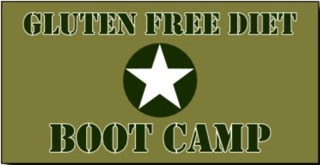
GIG of ECW's Gluten-Free Diet Boot Camp is a large collection of information on celiac, non-celiac gluten sensitivity, gluten-free diet basics, recipes, dining, and a whole lot more!
Learn more: http://bit.ly/GIGECW_GFBootCamp
updated 09/30/18 - Added GIG of ECW’s The Stages of Change: Gluten-Free Edition article
updated 6/11/16 - Added "Partners of patients with celiac disease report relationship burden" article
Importance of Face-to-Face Support Groups

According to a Columbia University study, celiac patients reported better quality of life when they participated in face-to-face support groups compared to online support groups. Also, longer duration of face-to-face support generated a greater quality of life.
In contrast, they found lower quality of life reports when patients spent more time in online support groups.
“Coeliac disease: the association between quality of life and social support network participation”
Source: http://bit.ly/2K721uL
The gluten-zero lifestyle isn’t a walk in the park. It requires hard work, dedication, commitment, and knowledge. The emotional and physical stress of a difficult lifestyle change piled on top of years [often decades] of ill-health, takes it’s toll. Every opportunity for a positive outcome needs to utilized.

Network equipment giant Cisco performed a study of human behavior and the barriers to effective collaboration. Overwhelmingly, the study showed people were more engaged when they could see and hear each other well; interacting the way humans have been doing since the dawn of their existence: face-to-face.
Humans require direct, face-to-face interaction with one another in order to be happy and healthy.
Online groups can be a great source of support, however, it’s hard to replace friendly smiles, nodding head(s) of agreement, the sympathetic touch of a hand, or a spirit lifting hug.
If you do not belong to a local support group, please seek out the nearest group.
Looking for a group? You can search for group national affiliated [Celiac Disease Foundation (CDF), Celiac Support Assoc. (CSA), Gluten Intolerance Group (GIG)] groups here:
Alan Klapperich
GIG of ECW Branch Manager
update: 4/3/19 - Fix broken link to study.
The Risks of Cheating
This article originally appeared in our January 2016 newsletter. Due to the [unexpected] overwhelming positive feedback, I decided to improve it and post it here.
I hope you find it helpful.
Stay strong & keep moving forward.
Alan Klapperich
GIG of ECW Branch Manager

While many find it a blessing their condition can be controlled by a "simple diet" change, others consider it a curse of biblical proportions. It's no secret, transitioning to the gluten-free lifestyle can be tough. [Notice the word - lifestyle. The changes required go far beyond just diet.]
A new lifestyle requires the desire to change, knowledge of how to make the change, and the dedication and motivation to stay the course. Yes, it's quite a departure from the previous lifestyle of eating anything from anywhere at anytime.
Barriers to Compliance
When it comes to dietary compliance for the gluten-free diet, there are many barriers that must be broken down:
- Time constraints for cooking or preparing food
- Misinformation
- Lack of knowledge or education (label reading, recognizing gluten)
- Lack of cooking skills
- Ability to manage emotions: depression, anxiety, fear
- Ability to resist temptation
- Feelings of deprivation
- Gluten-Free food availability (may be hard to find)
- Financial restrictions (GF diet can be expensive)
- Social pressures
- Peer pressures
- Travel
- Lack of symptoms
- Effectiveness of the diet (it doesn’t appear to help)
This list seems almost endless, but unfortunately it's still incomplete.
It seems that removing gluten is easier said than done. Give up the foods that you’ve been eating for your entire life? That’s crazy talk!
"I need gluten. I can't live without gluten!"
Ironically, a heroin addict might say something very similar. This is not surprising since narcotics and gluten are addictive. Yes, let’s add "addictive" and "withdrawal symptoms" to the barriers of compliance list.
Addictive? Withdrawal? Seriously?
Yes, yes, and yes. Read on Macduff…
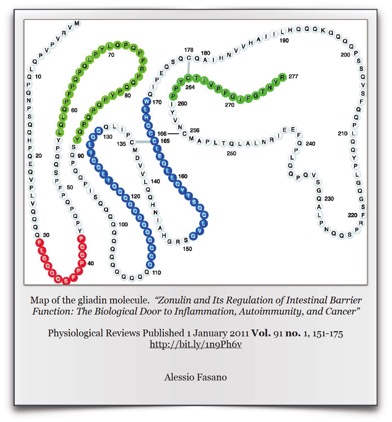
Think of gluten as a string of pearls that must be broken down into individual pearls [known as amino acids].
Humans do not have the enzymes to completely break down gluten into individual amino acids.
Large fragments [known as peptides] of undigested gluten remain after digestion.
Some of those peptides are known as gluteomorphins.
Due to increased intestinal permeability [also known as "Leaky Gut"], the gluteomorphins pass through intestinal wall and enter the blood stream.
Gluteomorphins react with the opiate receptors in the brain, just like heroin and morphine.
This reaction creates a craving - generating the desire for more of the substance.
Julianne Taylor, RN offers up a great explanation on how gluten creates an autoimmune reaction.
http://bit.ly/2vAO4hd or http://bit.ly/3qbRbUp
….and now, back to our regularly scheduled article…
Complications of Untreated Celiac Disease
While it may be easy to rationalize away gluten cheats as simple, temporary aches and pains or as minor [major] inconveniences - beneath the surface, your body could be gearing up for a civil war that would put Gettysburg to shame.

A 2015 study published by The Celiac Center at Beth Israel Deaconess Medical Center (BIDMC) found that 75.5% of the study participants had adequate gluten-free diet adherence.
So what about the other one-fourth (24.5%)? They may be setting themselves up for additional [often serious] medical conditions.
Some of the possible complications of cheating:
- Increased risk of heart attacks & stokes
- Increased risk of blood clots & Deep Vein Venous Thrombosis (DVT)
- Heart muscle damage
- Heart rhythm problems
- Coronary Artery Dissection
- Anemia
- Bone loss
- Cancers
- Ulcerative jejunitis
- Collagenous sprue
- Depression
- Malnutrition
- Neurological disorders
- Infertility
- Miscarriage
- Increased risk of triggering additional associated autoimmune conditions
Complications of Untreated Non-Celiac Gluten Sensitivity
Think you can escape the risks because you have non celiac gluten sensitivity? Sorry, gluten can still rear its ugly head with the likes of:
- Eczema
- Psoriasis
- Depression
- Peripheral Neuropathy
- ADHD
- Multiple Sclerosis
- Ataxia
- Diabetes
- Amyotrophic Lateral Sclerosis (Lou Gerhig's Disease)
- and potentially much more
To learn more about the above list, please check out this link:
by Chris Kresser, M.S., L.Ac
http://bit.ly/1n5wysf
ChChChChanges in Behavior
"Change is not measured in leaps and bounds but in the small steps we take toward a larger goal." ~Claire Dorotik-Nana LMFT
The Barriers to Compliance list above consists of things we can control and things we cannot control. Fear not, this lack of control does not a victim make.
The good news - we get to choose how we react in those situations; if we don't like it - we can change it.
The bad news - change is not always easy and requires effort.
The links below offer some information on how to make the changes that can lead to healthier, happier lives.
GIG of ECW - The Stages of Change: Gluten-Free Edition
by Alan Klapperich
http://bit.ly/GIGECW-Change
"Changes in lifestyle can be some of the biggest modifications we experience particularly if we have a gluten-related disorder. Transitioning to a gluten-free lifestyle turn our lives upside down. So keep calm and let's get prepared. We're going to delve into the gluten-full to gluten-free metamorphosis and give you the knowledge to make it a successful transition. I want to give you a basic understanding of change and the knowledge to make it a successful transition."
NursingTimes.net Vol 107 No 23 06/11/2014 - "Healthier lifestyles: behaviour change"
by Nicola Davies
http://bit.ly/3ozdbYN
"Unhealthy lifestyle choices such as smoking and poor diet are significant and preventable causes of long-term conditions. Nurses are well placed to encourage and support patients to make healthy choices. Through good communication, collaboration and goal-setting, behaviour change is possible. This article discusses evidence for the best ways to initiate and sustain behaviour change."
Note: Updated a link to Nicola Davies’ article. The link originally shared is no longer working
How to Withstand Food Peer Pressure
by Karen Diaz, RD
http://huff.to/1OMFmKx
When you are trying to listen to your body, food peer pressure can be the last straw making you throw in the towel. Here are four important ways to withstand food peer pressure.
Updated:
01/10/21 - Updated links to external resources.
09/30/18 - Added GIG of ECW Stages of Change article.
Navigating the Holidays

The risk of getting sick at every meal is a huge source of stress and concern. Now let's pile on the stress of family dynamics. We've got the fixings for an epic family battle royal. "Let's get ready to rumble!"
“My family puts the FUN in dysfunction”
I'm sure many can relate to the quote above. If you feel your family is the poster child for dysfunction, do not worry. All families are dysfunctional, it's simply a matter of degree.
Since the dawn of time, our existence has revolved around the acquisition and sharing of food. We have evolved and times have changed, but the primal need to gather and share food with members of our clan still remains. Holiday celebrations are a perfect example of that.
If we dig deep inside and look beyond the medical necessity of our food requests, we will find an emotional component. Our requests are an extension of ourselves. When our family and friends fail to acknowledge our food requests, we feel it as exclusion and rejection of us as a person. Maybe it is, maybe it isn't. Sometimes it's hard to tell what is inside the hearts and minds of our loved ones. I suspect the reasons are many and varied. Perhaps it is fear? Maybe they are afraid to try because they don't want to make us sick? Maybe we've yelled at them one too many times about food selection or preparation? What can we do? We have to talk to them.

Conversations are fueled by curiosity.
Confrontations have an aura of a judicial proceeding.
Conversations frame a problem as something to be solved.
Confrontations have an element of moral superiority.
Conversations happen between equals.
Confrontations shield the confronter from any responsibility.
Conversations say “we’re in this together.
For us today, gluten-free comes as easy as breathing, but it wasn't always that way. We were frustrated and confused, it's reasonable to expect family members will feel the same way. However, their behavior may appear to us as stubborn, unyielding, or uncaring. Remember, listening is a critical component of communication.
Despite our best efforts, we may have to accept the fact that some people just won't get it. This does not mean we can give up, however! Let's face it, we're up against years, decades, or in some cases centuries of traditions. The very definition of tradition allows it to brazenly flip Change, the bird.
Trə-ˈdi-shən: a way of thinking, behaving, or doing something that has been used by the people in a particular group, family, society, etc., for a long time.
"What?! No stuffing inside the turkey? Great-Great Grandma Brunhilde would turn over in her grave if we didn't use her recipe!"
Changing family traditions is downright heresy. Remember, to your family, gluten-free will be the new kid on the block. Situations like this call for the utmost patience. It may take some time for this concept to percolate through their brains and become a newly added family tradition. Don't panic, stay calm, and keep the lines of communication open. Keep up your educational efforts even if its only small tidbits here and there. Sometimes it's best not to flood them with information – ever try to drink from a fire hose?
I wish I had one simple answer that would solve every gluten-free holiday and family situation, but I don't. If I did, my name would be Dr. Phil and I'd have a TV show.
Bottom line – if you cannot resolve any of the food issues, try to put that aside and focus on the people that love and care about you – that is what really matters.
Here are some tips to get you through the holiday season.
- If you are brand new to the gluten-free lifestyle, it might help to have some basic information. Please see GIG of ECW's Gluten-Free Diet Boot Camp article: http://bit.ly/GIGECW_GFBootCamp
- Plain turkey is most generally gluten-free. Read the labels to verify. Several brands will now say "Gluten-Free" or "No Gluten". Make sure it has not been pre-seasoned or marinated; seasonings and marinades may contain gluten. Some turkeys will have a gravy packet. Verify the GF status of the gravy before using. Better yet, ditch the gravy packet and make your own...you'll be glad you did!
- Like turkey, most hams are GF [read the label], however if it has a glaze, it must be checked.
- A list of some gluten-free turkey and ham options: http://bit.ly/GIGECW_Turkeys
- If the turkey has been stuffed with gluten stuffing, do not eat the turkey, it's been contaminated.
- Stuffing [gluten-free or not gluten-free] made inside the turkey is a food safety concern. If you cook the turkey long enough to properly cook the stuffing [to a temperature of 165], the turkey is dry and over done. If you cook the turkey until it's done, the stuffing may not have reached the food safe temperature of 165. Either way, it's not good eats. Make the turkey and stuffing separately.
- Cooking bags are commonly used to help keep meats moist. However, the instructions state a tablespoon of flour should be added to the bag and shaken. The flour prevents the bag from exploding. Ask your host about this ahead of time. FYI - cornstarch or gluten-free flour will work too. [I never knew about exploding bags, we always use a bag and never put flour in it.]
- Mashed potatoes, a GF piece of cake, right? Not so fast, some recipes call for a bit of flour [oh the humanity!]. Scalloped Potatoes is another dish that more than likely has wheat flour. FYI, some potato salad recipes also call for flour. If you don't know how the host prepares their potatoes, it's best to ask.
- Mainstream "cream of" soups are not gluten-free and so are any dishes made with them, [think Green Bean Casserole].
Condensed Tomato Soup - http://bit.ly/2zm5Zb5
- Progresso offers their Cream of Mushroom soup, but it's not quite as condensed as actual condensed soup, but with some slight recipe modifications it can be used.
- Cornbreads or corn muffins often times have a mixture of cornmeal and wheat flour. There several mixes that are available. Krusteaz brand has a pretty good cornbread mix that's available in mainstream grocery stores. http://bit.ly/1pAUT9P
- Veggie & fruit trays are always popular. Be sure to survey the neighboring foods and assess cross contamination risks.
- Stay away from the butter dish. It's a crumb magnet!
- Be wary of communal chip or veggie dips. They might not be GF and they could be contaminated due non-GF snacks.
- BYOF (Bring your own food). Bringing a dish to pass ensures you'll have something you know is safe. We may feel a bit guilty about asking others to go out of their way to accommodate our requests. Good news! We have the ability be part of the solution instead of the problem. Politely ask the host what you can bring. Ask them to allow you to help. Let them know you want to ease their work load and worry-factor - not add to it - when it comes to making something safe for you. It helps to know what's on the menu so your dish will fit in with the others. Tip: Make sure you bring plenty for yourself and others.
- Open a line of communication early. It's a delicate topic, but you have to discuss GF food selection and cross contamination concerns with the host if they are not familiar with preparing gluten free dishes. Because they are not immersed in the gluten-free lifestyle, they'll need your help to educate and guide them. The education process is not a "once and done" event, it occurs over time. This is not on their radar 24x7x365, so they will need gentle reminders. Sometimes it's hard for people to grasp, so please be patient if they don't get it right away.
- Enlist the help of an ambassador. Sometimes it's easier to have another person to be an advocate for you. Ask a brother-in-law, sister-in-law, aunt, uncle, or cousin that you trust to help the host find gluten-free options for you. The more family members you have on your team the easier it will be.
- Make sure the hosts know that you appreciate their efforts. Thank them, thank them and thank them again.
- Eat [at least something] before you leave home, it takes the edge off of your hunger.
- If you like to cook, host the celebration yourself. This gives you ultimate control. If the guests ask to bring something, request things that are naturally gluten-free. Veggie tray, fresh fruit tray, an undressed salad, a bottle of wine or other beverages (not beer unless it's GF), vanilla ice cream (suggest a good brand). Don't be afraid to suggest non-food items: festive napkins, folding chairs, family favorite tableware, etc.
- If guests do bring gluten items, have a designated area for GF and NGF dishes.
Inspiration for this article goes to:
Quick Guide to Holiday Family Dining
Celebrate Gluten-Free Newsletter Fall 2014
Gluten Intolerance Group of North America
http://bit.ly/GIG-Membership
25 Tips for handling a GF holiday
Gluten-Free Living - December 2014
http://www.glutenfreeliving.com/
Additional Holiday information…
“Episode 50 - Holiday Survival Guide with Ellen”
Published December 19, 2018
by A Canadian Celiac Podcast with Sue Jennett
http://bit.ly/2WZ8BWQ
“Holiday Survival Guide 2018” PDF
Canadian Celiac Assoc.
http://bit.ly/2K9cJyf
“Holiday Survival Guide 2017” PDF
Canadian Celiac Assoc.
http://bit.ly/2Q4Jtwz
"Be Our Gluten-Free Guest"
Published November 30, 2017
by Amy Keller, MS, RD, LD
Glutenfreeliving.com
http://bit.ly/2nmqtg3
"Happy, Healthy Holidays - Thanksgiving and Beyond"
Nichol Creach, Gluten Intolerance Group
http://bit.ly/1I0CyM3
“Host your Gluten-Free Holiday”
Gluten-Free Living
http://bit.ly/32wHTWH
“Top GF Thanksgiving Tips You’ll Need This Week”
The Savvy Celiac
http://bit.ly/1MSjWhI
“Make a Traditional Thanksgiving Menu…Completely Gluten-Free”
Jane Anderson verywell.com
http://abt.cm/1j7s0yV
“18 Tips for GF Bread Baking”
GFJules.com
http://bit.ly/1LmAFUT
“Tackle the Holidays like a Gluten-Free Pro”
Gluten-Free School.com
http://bit.ly/2ArGmUm
“Managing the Holidays with Celiac Disease EP050”
Gluten-Free RN
http://bit.ly/2zZHv8J
Al Klapperich – GIG of ECW Branch Manager
Updated 11/10/18 - Added Canadian Survival Guides and Podcast, update links
Updated 11/22/18 - Updated broken links
Updated: 12/1/17 - Added Additional Information section
Updated: 11/11/17 - Added Walmart's GF soup info
Thankfully Gluten-Zero
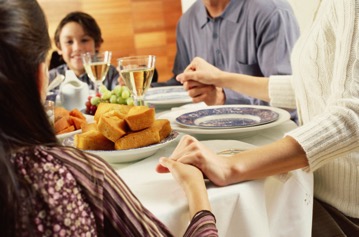
I'm sure I was a jumble of nerves. I was only 6 months gluten-zero, still trying to get a handle on all of this, not 100% confident in my food choices [no labeling regulations existed in 2003], worried I'd get sick, and then try to explain all of this to family members. GULP!
I have been graciously blessed and my heart is filled with much gratitude and thanks. I have an amazing wife that has always supported and believed in me, even when I doubted myself. Without her, I would not be what I am today.
I have the best family and friends. They respect my choices and always watch out for me.
The members of GIG of ECW and the gluten-zero community in general. It's you, my peeps, that inspire and motivate me, keep driving me forward as a human being and support group leader.
I am eternally thankful for what Melissa Diane Smith calls “The Gift of Gluten-Free”. All those years ago when I was lying on the living room floor in the fetal position, I could not have imagined what was in store for me [besides death]. I gave up gluten, but what I have received in return is beyond measure.
I realized that I was given an opportunity to use my skills and talents to help others. Heck, there were talents that I didn't even know I had! The biggest item unearthed in me was a passion – a purpose – something that was lacking in my life previously. I was given a gift, and I was shown how to give it away. It was a profound awakening.
I invite you to think about your gluten-zero life and list the items for which you give thanks. Consider all aspects of your life – physical and mental health; your relationship with friends and family members; your eating habits; your spiritual practices [things that feed your soul]. You might be surprised at the number of items you have on the list!
I also invite you to inventory your gifts and find out what can be given away. What you receive in return may rock your world. You won't know until you try.
Stay strong. Be well.
Your humble servant,
Al Klapperich – GIG of ECW Branch Manager
Be True to Your[gluten-zero]self

~ Steve Jobs
The Gluten-Free RN shared this quote on Facebook. Yes, Facebook can be useful and is not a complete waste of time. Steven's words struck a very loud chord in me, much like the startup chime of the Apple Macintosh that Steve Jobs created. The late Steve Jobs imparted this bit of wisdom to the 2005 graduating class of Stanford University. Regardless of Steve's intended audience, I feel these words are quite useful for the gluten-free/zero community, even almost a decade later. Steve Jobs was a visionary on many levels.
Members of the gluten-free/gluten-zero community have endured a good bit of bashing as of late. Considering the increase in mainstream awareness, I suppose some abuse might be expected. Late night talk show hosts airing "Man on the street" interviews asking "What is gluten?" - with embarrassingly incorrect answers. Improperly researched and inaccurate information published in newspaper/magazine/ internet blogs, social media sites like Facebook/Twitter/Tumblr allowing anyone to offer up their [educated and uneducated] opinions on such topics. We can't forget those closest to us - sometimes they can be our toughest critics - perhaps thinking we're just being trendy, wanting attention or special treatment. Yeah, right, we're nothin' but drama queens...
Add to this cacophony, the mainstream medicine dogma that still exists when it comes to gluten-related disorders. Even though celiac disease is one of the most common life-long disorders, it's still vastly under diagnosed; and don't even get me started on Non-Celiac Gluten Sensitivity. Healthcare professionals do not recognize the "clinical chameleon" that sits in their exam room. The medical community has come a long way, but many are still behind the times holding fast to what they were taught in medical school - celiac disease is rare and only presents with weight loss and diarrhea. You and I know this is total crap [pardon the pun].
Many in the community will be able squelch all the negativity going on around them. You, who are active in a support group, and those that have properly educated themselves have gone through an annealing process to harden your resolve. I do worry about those that are just starting their journey back to health. For certain, all of that negativity can be emotionally taxing and mentally distracting. Lord knows, I get tired of it. Do they have enough knowledge and commitment to stay the course? Blocking those external voices could mean the difference between success and failure.
Mr. Jobs was right - our time is limited, and we need to maximize every second we are in an earthly-form. "Sick, tired and grumpy" is not the way to go through life. We need to focus on the positive, stand up and advocate for ourselves when it comes to our health. We must block out the noise that can overpower our inner voice - the voice that tells us what it takes to keep our bodies happy and healthy.
I will leave you with these 5 daily disciplines to stay in a positive state of mind.
2. Write a gratitude list
3. Fill your mind with positive messages
4. Surround yourself with supportive people
5. Stay Active
More details on the disciplines: http://bit.ly/PositiveMindTips
Stay strong. Be well. Keep moving forward!
Al Klapperich
Branch Manager
Gluten Intolerance Group of East Central WI
Gluten-Free Diet Boot Camp
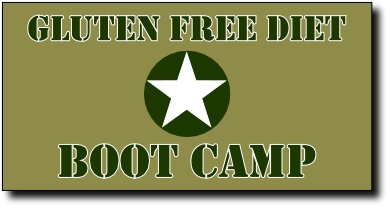
I often get asked for information on celiac disease and gluten-free. Either it's someone that is just starting to investigate gluten as the source of their health issues, or it's someone that is just newly diagnosed and looking how/where to start. So, I gathered up a bunch of resources and created this document. The original Gluten-Free Diet Boot Camp was created in 2005. What you see here is an updated version of it.
I am throwing A LOT stuff out here, please don't let it overwhelm you. If your head starts spinning, stop reading for awhile. While it may be very confusing to you right now, please know that it does get easier - it really does.
Alan Klapperich - Branch Manager
GIG of East Central Wisconsin
http://gigofecw.org/
http://www.facebook.com/GIGofECW
Revised: 09/12/20 - see bottom of page for details
Note: If you have not completed testing for celiac disease, please do so before going further. Why? One must be consuming gluten for the tests to be accurate.
You’ve been told you must go gluten-free and think, “What am I going eat?”. The more you think about it, you realize how monumental this is going to be. When faced with a large task I like to break it down into smaller, more manageable chunks. Focusing on smaller tasks makes this process much less overwhelming. Don't pressure yourself into trying to learn everything in one day.
The most important tool you can have when dealing with this is KNOWLEDGE. Knowledge means health. The more you know (about yourself, about your food, about this condition), the better you will feel.
Step 1 - Stay Calm. Try not to panic, this is not the end of the world. While it will take some time for you to settle into the GF lifestyle, it is very do-able. With a bit knowledge and a bit of planning, you will be successful. You are not alone, people all over the world live this way. Currently, it is now easier to maintain a gluten-free lifestyle than any other time in history. For better or worse, gluten-free has made it to mainstream awareness. While there is room for improvement, things are going in the right direction. Gluten-free options are plentiful, but, they are not always healthy. Gone are the days of 20 years ago when it was the rice and banana diet. Fear not...you will not starve! There are many foods that are naturally gluten-free - and darn tasty!
Step 2: Identify & remove the obvious foods from your diet. This is usually quite "easy" to do. I don't mean emotionally or physically easy to do, but easy to identify. Gluten is generic term for the proteins found in wheat (durum, graham, kamut, semolina, spelt), barley, rye & triticale (hybrid of wheat & rye). Any product made with or contaminated by these ingredients is off-limits - breads, crackers, cereals, pasta, pizza, cakes, pies, cookies, many soups, etc. Don't forget beer.
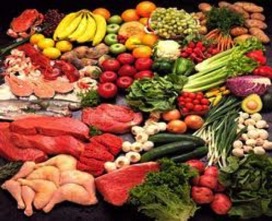
Whole foods are foods that have little or minimal processing done to them. Anytime a food is processed, there's a good chance gluten is added to it either by design or by accident [cross contact].
Think fresh fruits and veggies, plain meats, poultry, seafood, eggs.
Avoid products with marinades, sauces or seasonings-they may contain gluten.
Finding gluten in a head of lettuce or a bunch of carrots is pretty hard to do. After you start to feel better you can branch out a bit more in to the processed food if you wish, however I know many people stick to the whole foods.
Tip: Stick to foods with short ingredient lists - the shorter the better. It's better for you and requires much less reading. The best - single ingredient foods.
Step 3: Look for hidden gluten. This may take you some time for figure out. You WILL become a label reader. In order to stay healthy you will need to check every ingredient in every product you come in contact with - both ingested and topical. Be prepared to spend a couple of hours getting groceries. It will take that long due to label reading. After you read a few labels, you'll know why I suggested focusing on whole, single ingredient foods. Processed foods are a minefield when it comes to reading labels to determine if there's gluten. Not much to read on a head of broccoli, a bag of carrots, a head of lettuce, etc.
If you do buy processed/packaged foods check the ingredient label. If you see any of these words: Barley, Malt, Malt Flavoring, Malt Vinegar, Rye, Triticale, Wheat (Durum, Graham, Kamut, Semolina, Spelt), Brewer's Yeast - put the product down. If you can't tell from the ingredient list, call the manufacturer and ask them. Also look for a gluten-free certification. This seal tells you the manufacturer has specific standards, policies & procedures for making gluten-free foods. If you are unsure about a product, don’t eat it.
Avoid commercial or mainstream oats [think Quaker Oats] or products that use them because they can have high levels of gluten due to cross-contact. Pure, uncontaminated gluten-free oats can be tolerated by many, but for right now - this minute, no oats. Those new to gluten-free should abstain from oats for at least one year. Oats have been controversial for decades, please look at all the information before you decided to add oats to your diet. Please see our Oats section below for more information.
Other areas to look for gluten - medications, vitamins/nutritional supplements, cosmetics, soaps, shampoos, toothpastes, etc.
If a gluten-free food has cross contact with gluten, it’s off-limits. It only takes a crumb for many to get sick. Crumbs matter? Yes crumbs matter! It only takes a small amount of gluten to put your body into an inflammatory state.
ZERO gluten should be the ultimate goal for everyone following a gluten-free diet.
Have you double dipped in the peanut butter, Mayo jar, jam/jelly jar, butter dish, etc.? It's contaminated.
The best thing to do is go on a cleaning spree. Remove everything from your cupboards. Toss the gluten filled/contaminated junk and meticulously clean everywhere with hot soapy water - changing it often. Even move the stove and fridge!
A gluten-free diet is not like a diabetic diet where you can balance it out. There is no room for cheating. Everyone one will have different sensitivities to the gluten they might ingest. Some may be dreadfully sick for days/weeks from the smallest crumb. Others, may only have reflux, gas, bloating. Some won't have any reaction at all! Even though you may not be able to feel the effects of gluten, your body's immune system is in overdrive. Not adhering to the diet leads to nasty outcomes...the possibility of cancer and a cascade-effect of other auto-immune diseases.
Step 4: Join a local support group. As good as online sites are, there is nothing that can replace face-to-face, human interaction. According to a Columbia University study, celiac patients reported better quality of life when they participated in face-to-face support groups compared to online support groups. Also, longer duration of face-to-face support generated a greater quality of life.
In contrast, they found lower quality of life reports when patients spent more time in online support groups. Source: http://bit.ly/23gBFDX
The gluten-free lifestyle requires hard work, dedication, commitment, and knowledge. The emotional and physical stress of a difficult lifestyle change piled on top of years [often decades] of ill-health, takes its toll. Every opportunity for a positive outcome needs to utilized.
Making the transition not easy for you, nor is it easy for your loved ones. Often times spouses, family & friends may not always understand exactly what you are going thru. They may not understand how vigilant you must be at keeping gluten out of your diet. In fact, unsupportive friends and family can be a huge detriment to your success; surrounding yourself positivity gives you the best environment to flourish.
One way to make it easier is to meet with others that walk in your shoes. They know where you've come from, they know what you're going through. They understand. Understanding is not something you always find in the gluten free lifestyle. You find out that you're not alone.
Connecting with others that share your same situation can give you a huge boost emotionally and physically. Many others experience the same trials and tribulations you do.
Gluten Intolerance Group of North America: Living Gluten-Free Basics & Beyond (PDF)
http://bit.ly/GIG-Living-GF
Gluten Intolerance Group of North America: Getting Started Articles
http://bit.ly/2AOVYVl
Gluten Intolerance Group of North America: Diet & Nutrition Articles
https://bit.ly/33naq3w
Gluten Intolerance Group of North America: Health & Wellness Articles
https://bit.ly/2DViG21
Gluten Intolerance Group of North America: Lifestyle Articles
https://bit.ly/2RlR49k
Gluten Intolerance Group of North America: Published Articles
https://bit.ly/35rhrD4
Gluten Intolerance Group of North America: Find GFCO Products
https://bit.ly/35wlmi3
Gluten Intolerance Group of North America: Find Gluten-Free Food Service (GFFS.org) Restaurants
https://bit.ly/33rTHw5
Gluten Intolerance Group of North America: News Stories
https://bit.ly/3hohqC7
10 Must-Do's for Newly Diagnosed Celiacs by Jules E. Dowler Shepard
http://bit.ly/2B6ZDy5
A collection of articles that I've written.
Think SMALL for Gluten-Free Success
http://bit.ly/GIGECW-Think-Small
FDA Temporary Labeling Requirements During COVID-19
https://bit.ly/GIGECW-FDA-Temp-Labeling
The Tale of Two Nightclubs - Understanding Celiac Disease Through Motorcycles and Nightclubs
https://bit.ly/GIGECW-Tale-Of-Two-Clubs
Gluten-Free Success
http://bit.ly/GIGECW-GF-Success
The Stages of Change: Gluten-Free Edition
http://bit.ly/GIGECW-Change
Gluten-Free Label Reading
http://bit.ly/GIGECW-GF-Label-Reading
Low-Gluten Communion Hosts
http://bit.ly/GIGECW-LG-Hosts
Gluten-Free Road Trip
http://bit.ly/GIGECW-GF-RoadTrip
Grain-Free for the Gluten-Free
http://bit.ly/GIGECW-GrainFreeGlutenFree
Gluten-Free Gratitude
http://bit.ly/GIGECW-Gratitude
May Contain - Voluntary Advisory Statements
http://bit.ly/GIGECW-MayContain
Becoming a Gluten-Free Champion
http://bit.ly/GIGECW-Champion
What Oats Through Yonder Package Breaks?
http://bit.ly/GIGECW-PureOats
The Risks of Cheating
http://bit.ly/GIGECW_Cheating
Navigating the Holidays
http://bit.ly/GIGECW_Navigate_Holidays
Confusing Ingredients - GF or Not GF?
http://bit.ly/GIGECW_ConfusingIngreds
Back to School Resources
http://bit.ly/GIGECW_BackToSchool
Guide to Gluten Cross-Contact
http://bit.ly/GIGECW_GlutenContamination
Grieving the Loss of Gluten - (Published in Gluten Intolerance Group of North America's Quarterly Magazine Celebrate Gluten-Free Winter 2013)
http://bit.ly/GIGECW_Grief
Lack of Support From Family - (Published in Gluten Intolerance Group of North America's Quarterly Magazine Celebrate Gluten-Free Spring 2013)
http://bit.ly/GIGECW_LackofSupport
Educating Family & Friends About Gluten-Free - A collection of resources I assembled over the years to educate others. Includes a Powerpoint presentation I did for our church.
http://bit.ly/GIGECW_EducatingFamilyFriends
A Day in the Life: Living in a Mixed House - This is how we deal with having gluten in our house (I'm GF, my wife is not, but she's getting closer. YAY!)
http://bit.ly/GIGECW_MixedHouse
Better Living Thru GF Chemistry - A primer on medications.
http://bit.ly/GIGECW_GFChemistry
Gluten-Free Cosmetics and Hair Care Products - Gluten on the Skin?
http://bit.ly/GIGECW-Cosmetics
GIG of ECW Newsletters
http://bit.ly/GIGECW_Newsletters
A list of WI support groups :
http://bit.ly/GIGECW-WI-Support
Search for a support group in your area:
http://bit.ly/GIGECW-SupportGroups
Celiac Disease: A Hidden Epidemic (Revised and Updated Edition)
by Peter H.R. Green M.D. and Rory Jones
http://amzn.to/1OmJHJT
Gluten Freedom: The Nation's Leading Expert Offers the Essential Guide to a Healthy, Gluten-Free Lifestyle
by Alessio Fasano M.D. and Susie Flaherty
http://amzn.to/1X5JImX
Gluten: Worth the Risk?, Gluten-Related Disorder: Sick? Tired? Grumpy?, Gluten: ZERO Global, Gluten Brains: the brain-grain connection, The Gluten Syndrome: is wheat causing your harm?
by Dr. Rodney Ford
http://bit.ly/1NsxD9I
The First Year: Celiac Disease and Living Gluten-Free: An Essential Guide for the Newly Diagnosed
by Jules E. Dowler Shepard
http://amzn.to/1TJieOP
Allergic Living
https://www.allergicliving.com
Delight Gluten-Free
http://delightglutenfree.com
Gluten-Free Living
http://www.glutenfreeliving.com
Living Without's Gluten-Free & More
http://www.glutenfreeandmore.com
Simply Gluten-Free
https://simplygluten-free.com/
GF Recipes can be found simply by searching the internet. There are so many bloggers and websites that offer GF recipes, it's amazing. A lot can be found on Facebook.
Here are just a few...
Recipes for most of our meals are posted on our group's website, as well as Peggy's [my wife] baked goods
You'll notice that many of our recipes are pretty simple. I really like taking simple ingredients and making amazing meals. It's truly a case of "The whole is greater than the sum of it's parts". We do a fair amount of entertaining and hosting of family events [because we both like to cook and because it's easier for us to control the food]. Our goal is to show that gluten-free food is not taste-free, crappy food. We are successful at it if I do say so myself.
http://bit.ly/GIGECW_Recipes
Ginger Lemon Girl
http://bit.ly/2nMLcKt
Beth Hilson (founder of Gluten-Free Pantry Products)
http://bit.ly/2AIc5Sh
Carol Fenster
http://bit.ly/2yXr5wy
Annalise Roberts - My Gluten-Free Table
https://mygluten-freetable.com/
Betty Crocker Gluten-Free Recipes (General Mills)
http://bit.ly/2jGtXWq
Published lists of gluten-free products (electronic or paper), are easily outdated. Please keep in mind, you still need to read labels and sometimes verify GF status with manufacturers as ingredient lists can change - generally without notice. Use these lists/apps, as a guide, not as the sole means of determining the GF status of a food.
A review of the top 10 GF apps:
Gluten-Free Living - Top 10 Gluten-Free Apps
http://bit.ly/2yXBxnS
Verywell.com - 11 Gluten-Free Apps to Help You Shop, Eat Out
http://bit.ly/2ArQmRK
Gluten-Free Passport - iCanEat & iEatOut Apps
http://bit.ly/2iQk33D
http://bit.ly/GIGECW-Shopping
Some ingredients can be quite confusing. Check out these links for some clarification...
http://bit.ly/GIGECW_ConfusingIngreds
The safety of oats for those on a gluten-free diet is a topic that has been debated for decades...and it still continues today. Please research this topic carefully before making your decision about oats.
What oats are used in gluten-free products?
This article examines the difference between Purity Protocol Oats vs Mechanically/Optically Sorted oats…and why it matters.
http://bit.ly/GIGECW-PureOats
I can't eat gluten. Can I safely include oats in my gluten-free diet?
By Jane Anderson
http://abt.cm/1F2Qwuk
Canadian Celiac Association
http://bit.ly/2yY6Ui8
Read CCA's entire oats statement
National Foundation for Celiac Awareness
http://bit.ly/2kRzQn5
A special caution must also be delivered when it comes to oats. While oats in their natural form do not contain gluten, a small portion of patients with celiac disease react to oats in their pure, uncontaminated form. Some literature suggests that a protein in oats can trigger a similar response to gluten. Additionally, most mills that process oats also manufacture gluten-containing grains, making the chances of cross-contact inevitable.
The best advice we can offer is to take a great deal of care before introducing oats into your diet, which includes speaking with your healthcare provider about this dietary change. There is no way to determine if you will react, so proceed with caution. Verify that the oats you are using are “pure, uncontaminated,” “gluten-free,” or “certified gluten-free.” Experts recommend that up to 50g of dry gluten-free oats are considered safe. Check nutrition labels for portion size.
University Chicago Celiac Disease Center
http://bit.ly/2BSOn5r
A large body of scientific evidence accumulated over more than 15 years has proven that oats are completely safe for the vast majority of celiac patients. Oats are not related to gluten-containing grains such as wheat, barley and rye. They don’t contain gluten, but rather proteins called avenins that are non-toxic and tolerated by most celiacs (perhaps less than 1% of celiac patients show a reaction to a large amount of oats in their diets).
Oats can be in a celiac’s diet provided they are selected from sources that guarantee a lack of cross-contact of wheat, rye or barley.
Some who add oats to their diet may experience GI symptoms. This may actually be a result of the increased fiber that oats provide instead of a reaction to the oats themselves.
Remember: Use published lists wisely. Always read the product ingredient list. If you're unsure, call the manufacturer [even from the store] and ask. GF status checks are generally the #1 type calls customer service reps get.
Also be conscious of the amount of processed foods you consume. Try to use them sparing or even better, not at all. Many in the GF community feel their best when all processed foods have been removed. Keep in mind, fine tuning your diet is a work in progress; you keep tweaking it so you can be at your best. Making the leap to gluten-free can be a daunting task, GF processed foods could be used as a stepping stone to help make that transition a bit easier. Everyone handles change differently. You need to figure out what works for you, what gives you best chance a success.
Tip: When checking the ingredient labels, use the 3-times rule. Read the label when you purchase a product, when you put it away in your pantry and again when you retrieve it to use. This will help minimize mistakes.
Tip: Stay away from naturally gluten-free foods in bulk bins - cross-contact risks are too high
Betty Crocker (General Mills)
http://bit.ly/2jG8Un7
Campbell's GF Products
http://bit.ly/2C2pEME
Del Monte Products
http://bit.ly/2AI84NZ
Gluten Intolerance Group's Easy-to-Find and Easy-to-Fix
http://bit.ly/2d1cbgh
Festival Foods Gluten-Free Webpage
(Festival Foods are located in Appleton*, Baraboo, De Pere, Eau Claire*, Fond du Lac, Fort Atkinson, Green Bay*, Holmen, Janesville, Kenosha, La Crosse*, Madison, Manitowoc, Marshfield, Menasha, Mt. Pleasant, Neenah, Onalaska, Oshkosh, Paddock Lake, Portage, Sheboygan, Somers, Suamico, Tomah. *Multiple locations):
http://bit.ly/2kjzzW7
Note: Festival Foods Deli is not a dedicated gluten-free environment. However, their staff has participated in the National Foundation for Celiac Awareness GREAT Kitchens Program. A training program to educate food service professionals on gluten-free food preparation and cross contact.
Verywell.com Gluten-Free Candy (updated regularly)
http://bit.ly/2nPYFRG
Hershey's Gluten-Free List
https://bit.ly/3hqzAmH
Dining out is also a minefield. All too often, restaurants don't understand the intricacies of properly preparing gluten-free food. The risk factor for gluten cross contact is generally quite high. However, with proper training food service professionals can successfully create delicious gluten-free food.
In many cases, the restaurants that do the best job have a family member that must be gluten-free. They understand the workings of a busy kitchen and educate their staff how to keep their guests [and family members] safe.
There are many in the gluten-free community that do not eat out at all. They simply won't risk their health for a meal out. This is a personal choice that we all have to make.
Gluten Intolerance Group of North America - Restaurant Dining: 7 Tips for Staying Gluten-Free
http://bit.ly/2cFkuZD
Gluten Intolerance Group of North America - Restaurant Card
https://bit.ly/2FxDpJs
Gluten-Free Living - Tips for Eating Out
http://bit.ly/2j5rc0e
Here are some local dining options for you to investigate:
http://www.gigofecw.org/dining/dining.html
Happy Bellies Bake Shop (Appleton)
http://www.happybelliesbakeshop.com/
Molly's GF Bakery (Pewaukee)
http://www.mollysglutenfreebakery.com/
Revised: 04/12/21
Revised: 09/29/20
Revised: 09/12/20
Revised: 01/11/19
Revised: 01/30/18
Revised: 11/22/17
Revised: 08/23/17
Revised: 11/27/16
Revised: 05/24/16
Revised: 05/21/16
Revised: 05/12/16
Revised: 04/30/16
Revised: 04/06/16
Revised: 07/24/15
Revised: 04/18/15
Updated Candy Lists
Updated various links
Updated Canadian Celiac Association's position on oats
Revised: 11/11/14
Revised: 10/19/14
Revised: 05/04/14
Revised: 04/12/14
Revised: 03/31/14
Revised: 03/30/14
Revised: 03/08/14
Revised: 03/05/14
Added: GIG's Easy-to-Find and Easy-to-Fix Link, LiveBetterAmerica.com Recipe Link, Annalise Roberts recipe link, Happy Bellies Bake Shop
Revised: 08/09/13
Back to School Resources for Celiac Disease

A collection of back to school info for those with celiac disease...
Gluten Intolerance Group of North America - Gluten-Free Safety at School - 504 Plan: (added 9/1/20)
https://bit.ly/31MrPCX
Gluten Intolerance Group of North America - Understanding your Student:
http://bit.ly/2LQe7Ij
Gluten Intolerance Group of North America - School Trip Letter:
http://bit.ly/2M0TJ7u
Gluten Intolerance Group of North America - Letter to Teacher:
http://bit.ly/2KkgdLP
Global Autoimmune Institute - Managing Celiac in Schools: (excellent resource - added 11/12/21)
https://bit.ly/3ndw2dT
Glutenfreeda - So Your Child Has Celiac: First Steps for the Classroom and Beyond: (added 8/21/16)
http://bit.ly/2s4ftVO
Twin Cities ROCK - Navigating School and Daycare with a Gluten Free Diet:
http://bit.ly/2qLdxgW
Accommodating Children with Special Dietary Needs in the School Nutrition Programs:
http://bit.ly/2sprBhB
Canadian Celiac Assoc's Teacher Info handout:
http://bit.ly/2spCXlE
Boston Children's Hospital - Raising a Child with CD - Safe at School, School Environment, 504 Plan (download "Celiac Support Group School Packet"):
http://on.bchil.org/2rmBHBq
Boston Children's Hospital - Celiac Disease Program - School: (added 8/01/18)
https://on.bchil.org/2LKVs1k
Verywell.com - School 504 Plans for Food Allergies: (added 8/01/18)
http://bit.ly/2n20F5V
Verywell.com - 6 Ways You Can Help Gluten-Free Kids Cope With School: (added 8/01/18)
http://abt.cm/2spDhRo
Celiac Disease Foundation - Back-to-School and 504 Plan Guide: (added 8/22/15)
http://bit.ly/2rCYcSS
Food Allergy Research & Education (FARE) - Section 504 and Written Management Plans: (added 06/06/20)
https://bit.ly/375gOhc
BeyondCeliac.org - Navigating the Gluten-Free School Years: (added 8/01/18)
(Don’t miss the Back to School Toolkit)
http://bit.ly/2Kox1B4
National Celiac Association - Back to School Resources for Parents and Students:
http://bit.ly/2EkFfaW
The Kids are Back in School - Tips for Making the (Gluten-Free) Grade by Danna Korn:
http://bit.ly/2s4oRc7
Gluten Free Art Supplies - note this links to a post that is old - please verify products are still GF
http://bit.ly/2rCC9Mi
Soy-yer Dough (Gluten-free, non toxic and fun scented modeling dough)
http://www.soy-yer.com/
The Savvy Celiac - Approaching your School about Gluten-Free Foods (2009)
http://bit.ly/2sB3a01
The Savvy Celiac - Managing Gluten-free in the Classroom (2009)
http://bit.ly/2spBkV7
The Savvy Celiac - Must Daycare Provide Gluten-Free Food? (2009)
http://bit.ly/2sAV6wg
Revised:
11/12/21 - Added Global Autoimmune Institute link.
09/01/20 - Check and update links
06/06/20 - Added FARE 504 Plan link
08/01/18 - Updated broken links, add new links
01/08/18 - Added NCA link.
06/03/17 - Removed CSA link, updated CDF link, shortened all links
06/02/17 - Add MassGeneral 504 link.
08/21/16 - Added Glutenfreea website.
05/27/16 - Remove American Celiac Disease Foundation links - website gone.
08/22/15 - Added CDF - School and Education Benefits Link
08/19/15 - Removed broken link. Updated CSA's Getting Along at School link. Added Soy-yer Dough Link
08/05/15 - Added NFCA's Back to School Toolkit
07/29/14 - Added Daycare Rights for your Celiac Children
05/21/14 - Updated broken links
Guide to Gluten Cross-Contact
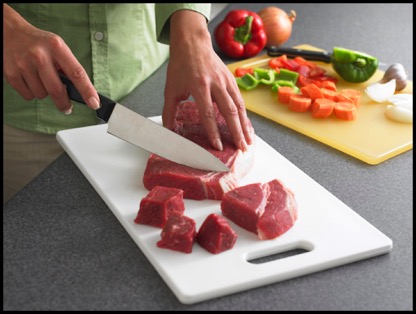
Basic kitchen safety rules tell us that we need to separate ready-to-eat foods from raw meats, poultry, seafood, and eggs - and to use separate cutting boards and utensils to reduce the risk of food poisoning.
The same rules apply to gluten and gluten-free foods - they must be kept apart.
Even though a recipe may use gluten-free ingredients, the food must be appropriately prepared, so it remains gluten-free. If you are making meals for a gluten-free guest, you must be mindful of gluten cross-contact.
This guide will help you to understand and prevent gluten cross-contact.
Aren’t they the same thing?
We often use the term “gluten cross-contamination” when speaking with foodservice professionals about the preparation and handling of our gluten-free foods.
Cross-contact and cross-contamination appear to mean the same thing, but there is a subtle difference according to the FDA. Cross-contamination is a commonly used term for allergens. However, allergenic proteins are a normal component of food and not considered a contaminant. Based upon this definition, the agency began differentiating the conditions two years after the Food Safety Modernization Act (FSMA) of 2011 became law.
Let's explore the differences a bit more.
Cross-contamination happens when biological contaminates (bacteria or viruses) transfer from one food (or surface) to another.
Example: using the same cutting board & utensils for raw meats and ready to eat ingredients). Killing bacteria by heating the food to a recommended temperature makes the food safe to eat. Of course, we know this is not possible for gluten (or any allergenic proteins), however using improper terminology will give the wrong impression to a foodservice professional.
Cross-contact happens when allergenic proteins transfer from one food (or surface) to another.
Example: using the same cutting board to cut gluten and gluten-free bread. While we expect our food to be biologically contaminate-free, cross-contact is what we're concerned about with gluten.
Using the appropriate terminology with foodservice professionals will clearly and accurately describe our needs.
Food Allergy Research & Education (FARE).
http://bit.ly/FARE-avoid-cc
Updated: April 1, 2021
Before you start you need to know a few basics.
What is gluten?
Where is gluten found?
What does gluten do?
How much arsenic would you like in your food? Very good, I thought you'd say zero.
Not only must the food be gluten-free, but it also must not come in contact with any gluten.
The concept of “a crumb will hurt you” is hard for people to understand because it involves minuscule amounts.
How small? A multicenter, double-blind, placebo-controlled, randomized study has shown that up to 10 milligrams of gluten per day is considered to be safe amount. Yes, per DAY. (10mg = 1/8th of a teaspoon of flour, or 18 slices of gluten-free bread). Yes, crumbs matter!
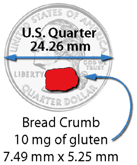
Tricia Thompson, MS, RD of Gluten-Free Watchdog answers this question.
She breaks it all down for us starting with a one ounce (3,515 mg) slice of gluten bread.
http://bit.ly/GFWD-10MG
Special thanks to Tricia for allowing me to use her pictures to draw this diagram to show the relative size.
Mind blown? There's more...
Many cannot consume even 10 mg of gluten without getting sick.
- Condiments (spreadable) – jars of peanut butter, mayo, butter, margarine, jelly, etc. These containers are large gluten magnets due to "Double Dipping."
- Any foods like flours, starches, white or brown sugars, etc. that frequently use shared utensils with gluten.
- Brown sugar has another risk factor. Some people will put a piece of bread in their container to keep the sugar soft. Breadcrumbs contaminate the sugar.
- Deep fry oil or pasta water.
- Silverware drawers – take a look in there – lots of crumbs!
- Kitchen surfaces – whenever preparing gluten-free food, make sure work areas, and hands are clean and free of crumbs.
- Toasters - if you’ve ever toasted gluten products in it, there is no way to clean it effectively.
- Ovens and Convection Ovens (they circulate the air inside the oven to shorten cooking times).
- Cake pans – these pans typically have a lot of very deep cuts/grooves in them.
- Cookie sheets
- Any utensil, pot, pan, dish, etc. that has come in contact with gluten. They must be clean before gluten-free use.
- Colanders/Strainers/Flour Sifters – Pasta/gluten often get stuck in the small little holes and slits, thoroughly cleaning them is a nightmare; if not impossible.
- Wooden utensils/boards/rolling pins – Porous items can harbor gluten.
- Cutting boards [plastic or wood] – due to the deep cuts and grooves, it’s best to get a new one.
- Non-stick pots & pans
- Cast iron skillets – the “seasoning” develops from years of use.
- Ceramic bake or cookware (Pizza Stone) – it's porous..
- Dishtowels/sponges/dishrags
- Grill grates
- Shared bowls or bags of your favorite GF snack food. Shared dips & sauces. They are crumb magnets.
- Family-style or Buffet-style service - A gluten-free nightmare! Inevitably someone will grab a spoon from the pasta salad bowl for the gluten-free coleslaw.
- TV Remotes, Phones, Keyboards, Mice...anything that has been touched by glutened hands.
- More Cross-Contact Information
Double dipping is strictly prohibited. Master the fine art of “Gob Dropping” or using a couple of spoons & knives to accomplish the task.
Purchase squeezable containers when possible.
Same goes for stirring and serving. Always use a clean utensil for gluten-free foods.
Have dedicated utensils for only GF use.
Purchase and use new products. Dispose of contaminated products or clearly label as not gluten-free.
Do not boil gluten-free pasta in water that previously cooked gluten-full pasta. Use fresh water for GF pasta.
It's best to designate a gluten-zero prep area where no gluten is allowed.
Toaster bags are an option.
Toaster Ovens with Fixed racks – line with foil. Works well for heating, baking, but not good for toasting.
Toaster Ovens with Removable racks – purchase and mark new rack for GF use. Foil existing rack or clean.
Either turn off the convection feature (circulated air) or make sure you have a tight-fitting lid on your gluten-free dish.
Have dedicated GF cookie sheets.
Those living in a mixed house should have dedicated gluten-free utensils, cutting boards, colanders, etc. It helps to have them color coded. Consider using the color red for gluten-free.
Due to the holes in sponges, dedicate one to gluten-free.
Change them often.
If cleaning or replacing isn’t an option - grill gluten-free items on aluminum foil.
Have a marked & dedicated gluten-free chip dip bowl.
If no room for separate gluten-free/gluten-full foods, hold back some of the gluten-free foods before they are placed out for service. Tell your gluten-free guest where to find these items.
Invite gluten-free guests to go through the line first - before any of the gluten-free dishes have a chance to get contaminated.
Clean these items the best you possibly can - it is tough.
Gluten Intolerance Group of North America
https://fal.cn/3erh8 (PDF)
“Producing Gluten-Free Products in a Non-dedicated Kitchen”
Gluten Intolerance Group of North America
http://bit.ly/2Wii9ea (PDF)
“7 Tips for Avoiding Gluten Cross-Contact at Home”
Gluten Intolerance Group of North America
https://bit.ly/2SpCttO (PDF)
“Preventing Cross-Contact at Home”
EatRight.org - Academy of Nutrition and Dietetics
https://tinyurl.com/yxu9yaca
“A Day in the Life: Living in a Mixed House”
Gluten Intolerance Group of East Central Wisconsin
http://bit.ly/GIGECW_MixedHouse
“Gluten-Free Diet Boot Camp”
Gluten Intolerance Group of East Central Wisconsin
http://bit.ly/GIGECW_GFBootCamp
“Educating Family and Friends about Gluten-Free”
Gluten Intolerance Group of East Central Wisconsin
http://bit.ly/GIGECW_EducatingFamilyFriends
“Tips to Prevent Gluten Cross-Contamination” by By Lisa Cantkier
Published May 24, 2021
GlutenFreeLiving.com
https://bit.ly/3wN15z4
Read more: http://bit.ly/GIGECW-Heat-Destruction

On September 14th, 2020, Gluten-Free Watchdog presented their first-of-kind study to the Association of Official Analytical Collaboration (AOAC) International. This study measured the amounts of gluten found in gluten-free foods when cooked in fryers that previously fried gluten-containing foods.
Like the study above, Gluten-Free Watchdog shows that gluten cross contact in shared fryers is problematic for individuals with gluten-related disorders.
“Gluten-free foods cooked in shared fryers with wheat: A pilot study assessing gluten cross contact.”
Dietitians have long been discouraging consumers with celiac disease (CD) from ordering gluten-free foods cooked in shared fryers at restaurants.
This recommendation is based on presumed gluten exposure versus evidence-based research that gluten cross contact occurs. To the best of the authors’ knowledge there is no published data on gluten levels of gluten-free foods after cooking in shared fryers.
The lack of evidence of cross contact contributes to confusion among consumers, especially when gluten-free foods cooked in shared fryers (e.g., fries) are marked as gluten-free on some restaurant menus.
The purpose of the present study is to help inform consumer recommendations by assessing gluten levels of fries free of gluten-containing ingredients cooked in shared fryers with wheat.
Results
The sandwich R5 ELISA found quantifiable levels of gluten in 9 of 20 (45%) orders of fries ranging from 7 to > 84 parts per million (ppm)(above the highest standard) (Table 1).
Five orders (25%) of fries tested above 20 ppm of gluten.
Fries from 6 of the 10 (60%) restaurants were found to contain quantifiable levels of gluten in at least 1 of the 2 orders, with fries from 4 of these 6 restaurants found to contain levels above 20 ppm of gluten in at least 1 of the 2 orders.
The competitive R5 ELISA found gluten in 3 of the 20 (15%) orders of fries ranging from 14 to > 283 ppm gluten (above the highest standard).
Summary
Results of this assessment suggest that gluten cross contact may occur when gluten free foods are cooked in shared fryers with wheat. While a much larger study may be warranted, it remains prudent to advise consumers with CD to avoid foods cooked in shared fryers.
It is impossible for a consumer to know how much gluten is in fryer oil and how much gluten may end up in an order of fries. Shared holding trays, scoops, and fryer baskets also are sources of potential cross contact.
The gluten levels reported in this investigation are likely underestimates due to the limitations of the analytical methods available for gluten analysis of foods heated to high temperatures
For more information (including PowerPoint presentation, video, and white paper):
http://bit.ly/GFWD-French-Fry-Study
Frontiers in Nutrition - March 23rd, 2021: https://bit.ly/3ubwIB5
Authors: Tricia Thompson, MS, RD, Trisha B. Lyons, RDN, LD, Amy Keller, MS, RD, LD, Nancee Jaffe, MS, RDN, and Luke Emerson-Mason, MS.
Store GF items in well marked, sealed containers.
Do not purchase food from bulk food bins. Highly contaminated.
Purchase only GF Certified grains & flours. Including oats - no commercial oats (think Quaker Oats).
Flour particles can remain airborne for up to 24 hours. Only prepare gluten-free foods after a thorough cleaning and before gluten foods.
A group of researchers from Immunogenx and Biomedal/Glutenostics recently published the results of their study - quantifying the amount of gluten being consumed by a selected group of patients with celiac disease. Indeed this was a first-of-its-kind, ground-breaking study. [See below for link to the actual study]
What did the study find?
People with celiac disease are inadvertently consuming more gluten than they realized.
Keep in mind, medical experts recommend gluten consumption be kept below 10 mg per day.
Participants were (on average) consuming between 15 and 40 times the recommended limit. 244 mg is approx. 8.5 grains of rice.
While these numbers might explain why an estimated 30% to 70% of celiac patients still experience celiac-related symptoms while following a gluten-free diet, it raises many more questions.
How much gluten is coming from cross-contact?
Updated:
06/03/21 - Add Gluten-Free Living article to web
04/01/21 - Add GIG Tools to Replace & 7 Tips to Avoiding CC at Home links
10/2/20 - Add EatRight.org link.
09/27/20 - Add Gluten-Free Watchdog’s French Fry Study
10/23/19 - Add Gluten-Free Watchdog “What Does 10mg of Gluten Look Like?” link and update links
01/13/19 - Add GIG’s Cross-Contamination PDF
05/02/18 - Add Accidental Gluten Consumption Study & grammar clean up
01/28/18 - Added Gluten and the destruction by heat info
04/22/17 - Removed bad link.
04/29/15 - Added "A Day in the Life: Living in a Mixed House".
04/22/15 - Updated GIG links and updated Printer Friendly version.
01/31/15 - Added AllThingsGF.com Cross Contamination page link
06/21/14 - Add convection oven
12/27/13 - Fix broken links
10/20/2013 - Clarify terminology
Quarter Image by OpenClipart-Vectors from Pixabay
Grieving the loss of Gluten
If you are struggling with grief and giving up gluten, I hope this of some help.
Thanks!
Al - GIG of ECW Branch Manager.
Published in Gluten Intolerance Group of North America's Quarterly Magazine Celebrate Gluten-Free Winter 2013

I think it's safe to say that every gluten-free person has ridden an emotional roller coaster on their journey to health. People suffer for years [6 – 10 years on average], endure numerous doctor's office visits, and usually walk away with more questions than answers. Frustrating. Getting answers to the on-going health issues brings an immediate sigh of relief, almost a giddiness. "WHEW, I finally know what's wrong with me!"
Not surprisingly, that euphoria quickly dissipates. The reality of the situation rears its ugly head - "What am I going eat, and how will I handle this?" Convenience – gone. Care-free dining – adios. The joy of family gatherings - replaced with dread and worry. Things that took little or no thought - now rivals the logistics of a Mars Rover launch. Buckle up tight; this could be a bumpy ride.
Going gluten-free creates a massive jumble of emotions. The biggest and probably most complicated is grief.
In 1969, Dr. Elisabeth Kübler-Ross shared her experiences working with over 500 terminally ill patients in her well known book “On Death and Dying”. In this book she describes her Kübler-Ross Model [more commonly known as The Five Stages of Grief].
While terminally ill patients are using these concepts to deal with their diagnoses, it can be useful in any grief or loss situation - loss of a loved one, a divorce, a job, a pet, a food, an old lifestyle – any life-changing event.
The grieving process is essential and necessary when someone experiences a significant loss. It's normal, it's natural, it's healthy. It's often hard to look beyond the big black wall that stands before you. As daunting as it is, dealing with it is a must. Repressing or suppressing grief is detrimental to our well-being, resulting in various emotional and physical symptoms (headaches, gastrointestinal problems, heart palpitations, etc.). Just as we are working towards a healthy gluten-free body, we must work on a healthy mind/emotional state.
Processing those thoughts, feelings, and emotions is intense work, but it helps us accept what has happened. Grieving forces us to create a "new normal" out of our loss - whatever that new normal may be. We possess the power to create whatever we wish! Create wisely.
The grief cycle of Denial – Anger – Bargaining - Depression – Acceptance (DABDA) is unique as your fingerprint. Everyone deals with trauma differently. These stages are not rigid or sequential in their order of experience. We don't always move through the cycle in the described order, nor do we experience every stage. Transitioning can be fluid, subject to the ebb and flow of emotions. Do not be surprised if you find yourself visiting steps multiple times.
Let's take a closer look at each stage and see how it relates to losing our gluten-full lifestyle.
Denial – A protection mechanism. It helps us to mask the pain of reality while we figure out how to handle the loss.
"No, it's not gluten, it's the < insert any food besides gluten >."
"I feel fine except for my headaches, depression, and maybe this itchy skin thing, and maybe frequent trips to the bathroom. Heck, our entire family is like this – it's normal."
Anger – After the denial wears off, reality and pain come flooding in, resulting in anger. We can be angry at something, someone, or even ourselves. Due to the years of misdiagnosis, the medical profession often takes the brunt of the aggression.
"Gluten is in everything! What am I supposed to eat?"
"I want my old foods back. I can't have my favorite birthday cake. I can't go out with my friends. This sucks!"
“Gluten-free food is so expensive and it tastes terrible.”
Bargaining – The "What If" stage. We start asking questions of ourselves but also a higher spiritual power. We try to seek a compromise in an attempt to regain control of the situation.
"OK – just this one last cheat day...then I'll be good."
"Please, God, I'll do anything – just don't take away my pizza."
Depression – The reality of the situation is becoming even more evident. We start to feel sadness, regret, fear, uncertainty. We are preparing ourselves for the "aftermath" of the things to come. We are in the early stages of accepting our new reality.
"Everybody else gets to eat anything they want, and I can't."
"My life is over; it will never be the same."
"No one understands what I am going through."
Acceptance – Not everyone reaches this stage. Some may not even be willing to call it "acceptance," but a mere "willingness to move forward." While they may sound similar, there is a difference between truly "owning it" and "just doing what it takes to get by." When there is full acceptance, there's a sense of calm – a feeling that all will be OK.
"You know, this isn't bad. I'm finding GF replacements for my old favorites."
"WOW! I've been GF only two days, and I feel so much better."
"Gluten-free doesn't have to mean taste-free, crappy food. I can rock this..."
Embracement – This is not one of the original stages, but many in the gluten-free community have attained this level of "enlightenment." With embracement, we focus on the positives and benefits that the gluten-free lifestyle offers. We dive into our new lifestyle head first. We have found a purpose; educate, motivate, and advocate for others.
"People ask me to help them go gluten-free. It's great!"
"I wanted to help others, so I started a celiac/gluten-free support group in my town."
"Practical Ways to Cope in the Grieving Process"
Dr. Kenneth W. Matheson
Sadly, the link to Dr. Matheson's paper is no longer available.
Local support groups have so much to offer when it comes to helping people deal with their new gluten-free life.
My Personal Path
Just as we all react differently to gluten, we all uniquely handle the grieving process. Looking back, I don't feel I went through all of the stages.
Denial – I was sick and afraid, seeking answers. No denying something had to change.
Anger – Like so many, I was upset with the medical profession for various reasons but realized I had to let that go.
Bargaining – Perhaps oddly, I didn't bargain. I was sick and wanted to feel better and would do anything to do so.
Depression – Minor, but I attributed it to being sick, not from giving up gluten.
Acceptance – I was ready to accept anything that made the problem go away.
Embracement – I'm all about that! I went all in by starting GIG of East Central Wisconsin.
Here are a few things the helped me attain gluten-freedom. Maybe they'll help you too?
Faith – While it may not be popular to talk about a higher spiritual power, it was an essential factor in my journey. I didn't know why this was happening to me, but throughout the entire process, but I felt there was a reason for it. Later I would discover a passion and a purpose that didn't exist before; what a fantastic gift!
Knowledge - When I was sick, I turned to the internet, searching for answers or clues. I find that the more I know about something, the less afraid I become. As the fear dissipated, I felt better equipped to handle the situation.
Creativity – Even before I had to give up gluten, I liked to cook. For me, cooking is a creative process. I enjoy the process of creating, whether it's a stained glass piece, a song on the guitar, or something new for dinner. Cooking offers me unique challenges of using unfamiliar ingredients to create innovative and exciting foods and re-create healthier versions of old favorites. I was determined not to let gluten win this challenge. Creativity to the rescue!
Support - I was lucky when I stumbled across gluten as a possibility of my problems. I stumbled upon a discussion board inhabited by a few people who helped me figure it all out. I had an online support system.
Not only did I have an online support system, but I was also fortunate enough to have a very supportive spouse, friends, and family. I don't think too many people outside of my wife thoroughly knew what I was going through, how scared I was, or how sick I felt.
Having a support system to help you through those dark times is a tremendous advantage. They watch out for you and guide you. Even though I didn't want to socialize with others, my wife was wily enough to convince me to hang out with our friends or attend family functions. Once I got there, it did boost my spirits and made me feel better. Perhaps my wife couldn't fully understand what I was going thru [like another gluten intolerant might], but she was a sympathetic ear when I needed to vent, a shoulder to lean on when I wasn't sure I was doing the right thing. When I did need another "insider's" perspective, I had the online people in my corner.
Stepping outside - As I was figuring out my issues, I realized that I gained knowledge that could be useful to others. This epiphany allowed me to step outside of myself and my problems. I would bristle with energy when helping others.
I started by contributing to the very same online discussion boards that helped me—helping others just starting out – just as lost and confused as I was. Starting a local support group took the process to another level.
While it may appear that I was ignoring my emotional needs, I feel "doing for others" helped me to understand & process the feelings I was having. I consider this aspect most vital to me. I found that my issues/situation was far from what others were experiencing. I found that I was quite lucky in the grand scheme of things. Pretty soon, things were lookin' pretty good in my household.
Final Thoughts
I don't think anyone likes to experience the pain of a loss. Unfortunately, it's a simple fact of life; there is no way to escape it – much like death and taxes. It's just part of the whole "Human Experience."
Grief is messy, contradictory, and confusing, but it gives us a way to make sense of our world and experiences. It's a way for us to regain control of our lives; it allows us to let go of our sick and unhealthy past and prepare for a better, healthier version that is waiting in the wings.
We will run into obstacles; we may stumble and fall on our journey. No one ever said the path to gluten-freedom was easy. The important thing is that we always get back up and keep moving forward. We are in control and have the keys to unlock the door to our new life.
Nuova vita! New life!
Alan Klapperich - Branch Manager
Therapists Spill: 14 Ways to Get Through Tough Times
PsychCentral.com
“Clinical psychologist Christina G. Hibbert, Psy.D, knows a lot about tough times. Her youngest sister died from cancer at 8 years old. In 2007, another sister and her sister’s husband died within two months of each other. At the time, Hibbert was just several weeks away from giving birth to her fourth child. Almost overnight, she inherited her nephews and became a mom of six.
“I have been a daughter in grief, a sister in grief, and a mother raising kids in grief. I know it is not easy.”
But when you do the work to overcome your difficult experiences, you can heal. “And, when we choose to do it together, our families really can become even better in the end,” said Hibbert, also author of the forthcoming memoir This Is How We Grow.
Maybe you’re going through a similar experience or are grieving another kind of loss: a romantic relationship, a friendship, a job, a house. Or maybe there’s a completely different kind of stressor in your life. Whatever you’re struggling with, here are 14 expert tips to help.”
Read the entire article: http://bit.ly/2MdDUMI
Other resources used in this article:
The 5 Stages of Loss and Grief
By Julie Axelrod
http://bit.ly/3sQkfTr
After a Gluten-related Diagnosis: Grieving and Smiling?
By Ursula Saqui, PhD
http://bit.ly/2Y3veLi
Grieving Gluten: The Five Stages of Loss of Gluten Plus a New One
By gfe's Shirley Braden
http://bit.ly/39ZfYEG
Finding a New Normal
By Jan LaPitz
http://bit.ly/2qpir59
Life After Loss: Dealing with Grief
Univ. of Texas at Austin
https://bit.ly/3qN343h
We all grieve in our own way
By Vaughan Bell
http://bit.ly/3pejK3v

Printer Friendly
Updates:
02/21/21 - Added PsychCentral article
01/21/21 - Fix broken links
Lack of Support From Family

Sadly, this state of affairs is very common. In some cases, it goes beyond a simple lack of support, it crosses over into deliberate sabotage or willful "poisoning" of food.
Those that love us the most, can give us the most trouble about our desire to be at our best. This type of behavior is not limited to the gluten free community; it's quite prevalent in many with chronic health issues.
Fear and Denial and Insanity, oh my!
Why would someone that loves us not want to support us in anything we do - let alone something that might improve our health and quality of life? I suspect there are hundreds or thousands of different answers, unique as the fingerprints of those providing the answers. One of the most common opinions from GF community is fear.
Family members are afraid the health problems we are experiencing are closely connected to their own health struggles. If we are correct about the root cause of our troubles, that just might mean they have to go gluten-zero as well. In terms of celiac disease, it's hereditary, no ifs ands or buts. If you have celiac disease there is a 1 in 22 chance that your immediate family members could have it too, although they may not know it. When it comes to Non Celiac Gluten Sensitivity, gluten knows no family lines; it's just plain bad for everyone. Non Celiac Gluten Sensitivity affects a minimum of 6% of the population. Other medical professionals feel it's closer to 10% and as much as 30%-40%.
Denial is a very good friend of fear; you see them hanging together - a lot. Many family members are in denial - "Oh, I can't possibly have what you have - it's the _____________
While most family members would never say it out loud, some would:
While I don't profess to have all the answers [or any for that matter], I do have some things that might help you cope with misguided, uncaring and selfish family members. Like my Father-In-Law used to say "You can pick your friends, you can't pick your relatives".
1) Be clear about why you are going gluten-free.
Have a plan, have goals, direction, be specific. "I am gluten-free because ____________". If you don't have a clear idea about why you are doing it, how are others supposed to understand? Without direction, it's easy to get lost. It's like going on a car trip without a map or a GPS. If you already have a definitive diagnosis - your goal is clear cut - GLUTEN ZERO FOR LIFE - no exceptions - ever. If your family won't take your word for it, show them your doctor's office notes and lab results.
Having a medical diagnosis generally adds credibility to your efforts. If you doing dietary trials on your own without a doctor's backing, you're flying without a net. This means you'll need extra resolve to say the course. Strap yourself in, it's going to be a bumpy ride.
2) Take gluten-free seriously.
Sometimes, we're our own worst enemy. To be successful at being gluten-zero, you need commitment and consistency. There's no crying in baseball and there is no cheating when it comes to gluten-zero; it's all or nothing. If you don't take it seriously, how can you expect others to take you seriously? Seriously. They get confused and frustrated by your actions. One time you're gluten-zero, the next time you're eating a BigMac. That type of behavior just doesn't play, your credibility goes right down the toilet [pun intended].
Be aware that your own loved ones may try to sabotage your efforts. They may try to tempt or persuade you back to gluten foods. How many times have you heard "Come on, just one bite won't hurt". How many times have they waved your favorite gluten filled food under your nose or even tried to force it into your mouth? Giving in to that type of behavior, only gives them control - and makes you sicker. Stand fast and hold your ground. Eventually they should tire of it because you won't give in.
If you are doing dietary trials to see if gluten might be causing problems, clearly define how your trial is going to work. I bring up trials because it may involve putting gluten back into your diet - this might confuse your family members. Make sure they know about your plan. If you think you can cover up cheating under the guise of "doing a trial", you won't get away with it too many times.
Note: Before you start an extensive dietary trial, try to get tested first. In order for the tests to be as accurate as possible, you need to be consuming gluten. Click here for more info on testing.
If you are wondering, a trial should last three to six months at a minimum (six months is better). Depending on your symptoms, it may take a while for them to disappear, particularly neurological or skin [Dermatitis Herpetiformis] symptoms. Sometimes changes are subtle when you remove gluten, but very dramatic when you add it back in. I noticed changes on removal, but noticed larger changes when I went back on gluten. I started a 8 week gluten challenge to get blood work done and called it off after 5 days due to the symptoms. It was enough for me to determine that I will be gluten-zero for the rest of my days. I did have intestinal biopsies taken before I started dietary trials [yes, my testing sequence was reversed], no evidence of tissue damage was found. While I do not have a celiac disease diagnosis, a 4 month trial revealed gluten was an issue for me.
3) Communicate & Educate.
As simple as that sounds, I find it's not always done. Sit down with them and explain exactly why you want to explore gluten-freedom (see Tip #1). Be open about what you desire from them, so they know what to expect, they can't read your mind. Ask them for their help and co-operation; ask them to be a part of your team that makes you the best you you can be.
If we dig deep inside and look beyond the medical necessity of our food requests, we will find an emotional component. Our requests are an extension of ourselves. When our family and friends fail to acknowledge our food requests, we feel it as exclusion and rejection of us as a person. Maybe it is, maybe it isn't. Sometimes it's hard to tell what is inside the hearts and minds of our loved ones.
Opening up a line of communication is so important when it comes to resolution. Having a calm, heartfelt conversation about our health concerns and what it takes for us to be healthy and happy is the best chance we have at getting them to understand. It is up to us to kindly and respectfully educate them on how to do things correctly, no one else will do it.
I invite you to read this informative article on Confrontations vs Conversations from PsychCentral: http://bit.ly/1GQw2q1 It offers some great insights…
Conversations are fueled by curiosity.
Confrontations have an aura of a judicial proceeding.
Conversations frame a problem as something to be solved.
Confrontations have an element of moral superiority.
Conversations happen between equals.
Confrontations shield the confronter from any responsibility.
Conversations say “we’re in this together.
If you have trouble expressing yourself verbally, write a letter. Explain to them exactly how you feel, explain what you go thru on a daily basis, how you'd like to get your life back on track and how much it would mean to you to have their support.
Often times people tend to ridicule or dismiss things that they don't understand. If they are open to learning, find information from a reliable website and share it with them. Try not to overwhelm them with too much information. Once their eyes glaze over, you've lost them.
You might find something helpful here:
http://www.gigofecw.org/news/files/educating_about_gluten_free.php
http://www.gluten.net/resources/educational-bulletins
4) Letting go
Let's face it, you might talk and educate until you are blue in the face, there's a possibility they still won't get it. Be confident in the fact that you gave it your best effort. Don't let your emotions consume you over their unwillingness to support you. As hard as it may be, you'll be better off if you just accept it and keep moving forward, focus on getting yourself healthy. Don't let them suck you into their darkness.
5) If support doesn't come to you, you go to the support
OK, so maybe your family is a poster-child for dysfunction; incapable of understanding what you're going thru, refusing to work with you on any level...you need to seek out those that understand and have walked in your shoes. Connecting with others that share similar experiences can make the difference between success and failure.
It's imperative to surround yourself with people who are positive and who are pursuing their own goals. Positivity is contagious - so is loneliness and depression - which would you rather be? Dr. Barbara Fredrickson found a Positivity Ratio of 3:1 a tipping point for human flourishing. This means for every negative feeling, thought, experience, we need a minimum of three positive (love, joy, gratitude, etc) in order to be happy. The ideal ratio is 5:1.
Support comes in many different ways. Today, there is a seemingly endless supply of online communities you can join. The great thing about online communities is that they're always open - ready to accept the latest rant or cheer your most recent accomplishment. If online is not your bailiwick, a local support group is the way to go. While online groups can do wonderful things, nothing beats face-to-face contact. It's hard to replace seeing the look on someone's face, the sound of their voice, and at times, the touch of a hand or hug.
Search for local support groups here:
http://www.gigofecw.org/support/supportgroupwebsites/supportgroupwebsites.html
Good luck in your journey!
Al

Setting Healthy Boundaries When You’re Living Gluten-Free
https://bit.ly/3RvWYkN
As you transition to living gluten-free, your day-to-day interactions around food can be stressful. Many people aren’t familiar with gluten-related issues and disorders. Some may think going gluten-free is a fad rather than a medical necessity. How can you successfully navigate the different reactions and attitudes toward your gluten-free requirements? We’ve got some tips for navigating conversations and actions may not always be or feel supportive.
This article was published in Gluten Intolerance Group of North America's Quarterly Magazine Celebrate Gluten-Free Spring 2013
Update 10/04/22: Add GIG’s Setting Healthy Boundaries article link
Update 03/13/15: Update Tip #2 Communicate & Educate - added Conversations vs Confrontations.
Update 11/23/12: Fixed typos and added additional information.
Educating family & friends about gluten-free
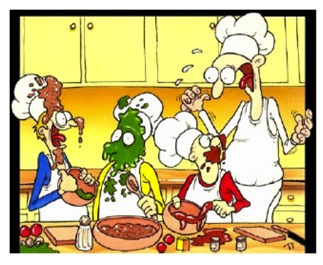
Easter is only one week away. In many families, this means Easter Dinner at someone's house other than your own. Oh, the humanity...
~~
Not only was today Palm Sunday, but it was also First Communion in our church. The kitchen and fellowship hall was a-buzz with activity.
A family was holding their First Communion celebration in the fellowship hall, and everyone was bringing their contributions to the feast: deviled eggs, sliced ham, calico beans, sloppy joes, cakes, pies and desserts of all types. OH MY!
As I was watching all of this food pour in, I'm thinking...OMG, what a gluten-free nightmare...
Peggy [my wife] and I were in the kitchen cleaning up from communion, we were invited to take part in the celebratory feast. A family member knows I am gluten-free and said: "Oh gosh, I'm sorry, we don't have any gluten-free buns, but there's plenty of other things for you...". We politely declined, but really appreciated the heartfelt invitation.
Dining out in a restaurant is hard, but I think eating at someone's house or a hosted event is even harder. Most times the host or hostess is unfamiliar with the gluten-free diet and the concept of cross contact. Also, professionally trained chefs may not always know the ins-and-outs of a gluten-free diet.

I don't blame friends, family and loved ones for not knowing about gluten-free. In fact, it's our [the gluten-free community] responsibility to impart that knowledge to them. If we don't do the education, who will?
In the end, if the people in our lives do not know how to accommodate our needs, we have no one else to blame but ourselves - to a certain degree.
Of course, some people just don't get it no matter how hard we try. If we've done our best to educate and it is just not sticking - at least we gave it our best shot. Sometimes family members present us with the most significant challenges.
The whole education process doesn't happen overnight. It takes time to re-wire decades-old engrained thoughts, actions, and behaviors. Sometimes - they will forget. It might be frustrating, for you and your students, but please remember: be kind and be patient. Remember, all of this is new to them - just as it was new to you. How long did it take you to adjust to your new normal? Don’t forget, you live with this 24x7x365 - probably not the case for your friends or family members.
During their metamorphosis, we have to make allowances [bring our own food, eat beforehand, etc.] until we are comfortable in their knowledge and abilities. Sadly, in some cases, that day may never come, despite our best efforts.
Since 2003, I've had a lot of "educational opportunities" with our friends and family. They now know and understand cross-contact, they will verify products/ingredients with me, even save the labels for me to inspect. My family and friends have been open to learning and making things safe for me. I connect with enough of the gluten-free community to know their behavior is not the norm. I am lucky...or...have I merely done an excellent job at educating them. I suspect it's a little of both.
Even though my family and friends are exceptional, I always bring at least one dish that I know is safe. Often times, I'll bring a second dish of the same food just for me that won't be put out for the masses. Also, we try to host as many family events as we can so we have as much control as possible.
I'd like to share some of the tools I've used to educate my friends and family members...
Gluten-Free Living - Explaining the Gluten-Free Diet - “While the holiday season should be an uplifting time of year, you may be dreading what your family has to say about your gluten-free diet. Sure, some loved ones support your dietary requirements, but others just don’t get it. In fact, some can be downright rude. How do you cope?”
GIG of ECW - Becoming a Gluten-Free Champion - “Today, there are a lot of resources available to those who are gluten-free. However, very few are designed to help you – the person who loves and cares for their gluten-free loved ones – the gluten-free champion.
You may not know it, but hiding beneath your street clothes is a superhero’s suit just waiting to be called into action.
We have a few tips and wealth of information in The Gluten-Free Champion’s Academy (see below) to help you make the leap.”
BeyondCeliac.org: Seriously, Celiac Disease - This is an effort to educate non-diagnosed family members about the importance of getting tested. As we’ve [often] discussed, our own families can be the most difficult. We talk, we educate, we lead by example. Whatever we do, has no effect. They just don’t listen to us. Celiac disease is genetic, it runs in families. If one person in the family has it, there is a chance someone else in the family has it too (1 in 22 for a mother/father/sibling) - they may not even know it. It’s very possible they could have it, and not have any symptoms at all! Be aware a single negative test does not absolve a person for life. Celiac Disease can be triggered at any age - at any time. And so the struggle begins… Family members need to be tested, but getting them to do it is another story. This is where Seriously, Celiac Disease campaign comes in.
Living Gluten Free for Dummies by Danna Korn - I highly recommend this book. I see this book as a continuation or update of her Wheat free Worry Free book. It also goes a bit further in depth on certain subjects. There is no need to own both. Get this one if you don't have either book. Again, a great book to loan out.
Wheat Free Worry Free by Danna Korn - I got this book shortly after I went GF. Danna has a great persona in her books. Her style is very conversational, easy to read and fun! She includes humor in her books, which I think is a great idea. This is a great book to give to friends and loved ones. Often times they have a hard time understanding what you're going thru and why you have to do it. I lent this to my Mom, after that, she seemed to "get it"...or at least stopped questioning why I couldn't have ___________ ;).
A Celiac is Coming For Dinner - This is an excellent article from Caryn Taity about accommodating gluten-free guests. I have given this article to several family and friends.
Cooking for Gluten-Free Family or Friends - Amy Leger [aka The Savvy Celiac], covers some of the basics.
GIG of ECW - Gluten-Free Diet Boot Camp - I often get asked for information on celiac disease and gluten-free. Either it's someone that is just starting to investigate gluten as the source of their health issues, or it's someone that is just newly diagnosed and looking at how/where to start. This is a collection of many different links.
GIG of ECW - Guide to Gluten Cross-Contact - This guide strictly addresses gluten cross-contact and how to minimize the risk.
GIG of ECW - A Day in the Life - Living in a Mixed House - This is an article I had written several years ago for this support group. It explains how we handle having gluten in the house. This is knowledge and experience I have gained over the years - much of it I've imparted to friends and family members.
So, You Want to Bake Gluten-Free Cookies - I created this for a few non-gluten-free people that wanted to bake GF cookies. We put together a GF Cookie Baking Kit: This document that included the recipes, the proper amount of GF flour for a specific amount of cookies. I cover the basics of gluten, gluten-free baking and cross contact - enough information so they can safely make GF cookies for someone. Note: You can tell by the logo, this was done before we became a Gluten Intolerance Group branch in May 2011.
Celiac Disease - Stuff you should know, but didn't know to ask - A presentation I did for our church. Since our Pastor is also gluten-free, I wanted to educate the other members. This presentation covers the history of celiac disease, what it is, what is gluten, is there a safe amount of gluten, cross-contact. Our church now has an entirely gluten-free communion. Since the host is gluten-free so there is no chance of cross-contact. Note: You can tell by the logo, this was done before we became a Gluten Intolerance Group branch in May 2011.
Updated:
01/21/198 - Fix broken and update links.
07/21/18 - Added Gluten-Free Living’s article & GIGECW Becoming a GF Champion
12/16/16 - Added BeyondCeliac.org's Seriously, Celiac Disease
10/29/13 - Added Gluten-Free Diet Camp.
6/24/2013 - Added Guide to Gluten Cross Contamination.
A Day in the Life: Living in a Mixed House
This article was originally written and presented to the members of this support group in March 2009. I decided to correct some typographic errors and add some additional knowledge/information I didn't have when I originally wrote it.
This document draws upon my knowledge and experience I have acquired since going gluten-free in 2003. I have given you, the reader, a glimpse into how I personally carry out a gluten-free diet in a mixed house. I am not suggesting this is the only way or the best way; it's simply my way. Nothing more – nothing less. Please do not take any information found here as medical or professional advice. I'm not a doctor/nutritionist/dietitian, nor do I play one on TV. Before making any changes, discuss them with your healthcare team to make sure they are right for you.
My only intent is help others that may be struggling with the gluten-free lifestyle.
Alan Klapperich
GIG of East Central WI - Branch Manager
Updated 6/24/2014

Not only do we have to be concerned about gluten ingredients that make up our food – we also have to be concerned about any gluten that may come into contact with our gluten free food.
Often times those that are new to the diet [or our friends and loved ones that don’t yet understand the diet], don’t fully understand the lengths we have to go thru to make sure our food isn’t contaminated. Yes, eye rolls and sighs are often the reactions we get. They think we’re being over cautious, anal retentive, drama queens…running around like Lucy van Pelt in A Charlie Brown Christmas “Ugh! I've been kissed by a dog! I have dog germs! Get hot water! Get some disinfectant! Get some Iodine!”
Gluten is gluten – it doesn’t matter how we come in contact with it. We need to be mindful of it.
GF or NGF [Non-Gluten-Free] Household – That is the question
Choosing what type of house to have depends on many factors. Economic, young children, percentage of members that require GF – just to name a few. I’m not going to defend or promote one way or the other. Every one must make the choice that fits them best. There’s no question that having a totally GF house would make things a lot easier on those that need to be GF. You have to weigh the practicalities of each side very carefully. However, as we continue down this gluten-free path, our house contains an ever dwindling supply of gluten. If we had kids, we might have chosen to be a 100% GF house right away.
Obviously those people that have a GF household are going to have an easier time of this. I’d venture to guess that, most people have a mixed house. I suspect that most celiac homes are mixed [meaning those that must be GF are, those that aren’t GF have gluten foods in the house]. I took a poll on one of the discussion boards I administrate. 77% (24) live in mixed houses.
I will say this – if you are having trouble getting your numbers down on your annual follow up blood work or still don’t feel well – you’d need to examine what is going on. How is gluten getting in? Are your food choices correct? Are you eating processed/packaged foods? Are you dining out? Could it be cross contamination at home? Did you check your meds/supplements? A number of things must be considered.
Those of us with a mixed house have our work cut out for us. We must always be on guard and always observant. Some people see this as a negative, because they don’t have a safe harbor from the rest of the gluten polluted world – that is completely understandable and desirable in certain circumstances. In my case, I don’t view it as a hardship, I view it as one of those “facts of life”. I feel it prepares me to deal with the rest of the world that doesn’t cater to me and my needs. Once you figure out a system, sharing a kitchen/pantry is do able – it just takes some planning – just like everything else with the GF lifestyle. “He who fails to plan, plans to fail”.
A very key element in having a mixed kitchen or 100% GF house – is having total buy-in of rule following from the others that live in the house. You’re really at their mercy in this. Sometimes this is not always easy – particularly with uncooperative spouses/significant others, kids [young ones] or yes, slobs. I’ve always said, it’s a good thing that I’m the one that’s GF, and not Peg. Yeah, truth be told, I can be teeny-tiny bit of a slob. In my defense, [I think Peg will back me up] when it comes to keeping the kitchen clean of food droppings, I think I do a pretty good job. I do my best to follow all the cross contamination rules just as she does. The kids – well – kids will be kids. As good as they can be, there’s going to be some mistakes made. The older kids, it might be easier to teach them what they need to do to keep things safe for their GF family member.
Regardless if you’re a mixed house or a 100% GF house, it’s always a good idea to give the kitchen/pantry a thorough cleaning when first starting out. Pull everything out of the fridge, cupboards, cabinets and drawers. Wash things down with warm soapy water – changing the water frequently. Gluten is not a living thing, so you can’t kill it – bleach does nothing. Heck as long as you’re at it, pull out the stove and fridge too - they can get pretty funky! For those with a mixed house – you’ll have to do this regularly if you don’t already do it.
Organization
As long as you have all the stuff pulled out of the cupboards and shelves, you will want to look at reorganizing them. You’ll want to have designated shelves, drawers and cupboards strictly for GF foods and for NGF foods. It’s best to keep the NGF items away from the GF items. It can also help to get some sealable containers so that you can place the GF food inside them – that way you won’t have to worry if something gets spilled or dropped on it. If you happen to have NGF flours – putting them in their own sealable container is also advisable. If you share pantry space, put GF items ABOVE gluten items. Since gluten rolls downhill, we don’t have to worry about “stuff” falling into it our GF foods. Also, make sure you clearly label GF and or NGF containers as such.
Also try to designate some counter or prep space strictly for GF items. Try to make a GF zone so that you always know you have a clean space to put things down. This can help a great deal when prepping meals.
Hardware
There are some utensils that you’ll want to replace – hands down, no matter what.
Toasters - if you’ve ever toasted glutened products in it – get yourself a new one and mark it so everyone knows that only GF items are to be put in it.
Toaster Ovens – if you’ve got one with removable racks, call the manufacturer and see if you can purchase another rack for it. We purchased a Kitchen Aid, as soon as I got home I called them and asked about another rack. The representative seemed somewhat perplexed as to why I wanted another rack. I explained – he sent me another one free of charge! Now that’s customer service!
Colanders/Strainers/Flour Sifters – Since pastas/gluten often get stuck in the small little holes and slits, cleaning them fully is a nightmare if not impossible. We have 2 colanders.
Wooden utensils/boards/rolling pins – Porous item can harbor gluten.
Cutting boards [plastic or wood] – due to the deep cuts and grooves, it’s best to get a new one.
Cake pans – these pans typically have a lot of very deep cuts/grooves in them. Cookie sheets – you could always use parchment paper with your existing pans when baking GF cookies. I have my own cake pan, muffin tins, pizza pan, mini loaf pans, cookie sheets.
Non-stick pots & pans – if there’s any cuts or scratches in the surface, replace it. It’s reported that Teflon is a porous surface and thus is not GF friendly. I have relaxed my views on non stick surfaces over time. As long as the coating does not have any cuts/scrapes/grooves – and as long as it’s completely clean – it's not a problem. I sent off an email to Tricia Thompson aka The Gluten Free Dietitian aka the author of The GF Nutrition Guide. Since she’s done many scientific studies, I thought she’d be a good one to ask about Teflon. Here’s what she said:
"In my opinion, if a teflon pan has scratched and starts to peel it should be thrown away for reasons far more important (probably) than the possibility it harbors gluten. Maybe it's just me but I don't like the idea of eating those little bits of teflon even if they are chemically inert!! As for the possibility that nonstick pans absorb gluten, I am not aware of any studies but find this hard to imagine. I am not an expert on Teflon but based on what I've read, Teflon is chemically inert, is not porous, and does not absorb food. " ~ Tricia Thompson, RD
There are only 1 or 2 pans that we use for gluten foods – I use them if I have to [which is rare].
Cast iron skillets – the “seasoning” develops from years of use is definitely something to stay away from. I’ve heard of some people getting them sandblasted or scrubbing them with steel wool and starting over.
Ceramic bake or cookware – yeah, that old pizza stone ain’t gonna cut it. Foil it, or hand it down to the gluten eaters.
Having some type of marking scheme is important. People have to know what’s used for GF and fair game for anything else. In our house we use the color red as much as possible for GF items. Spatulas, spoons, Tupperware, etc – all have the color red somewhere. We do have a GF wooden spatula – it’s Pampered Chef Brand – it’s the only one of it’s kind. For our toaster oven rack, I’ve colored all 4 corners red with a Sharpie permanent marker.
We have even trained frequent guests and family members on how our house functions and cross-contamination concerns.
Navigating
Figuring out how to navigate in this gluten filled world takes some doing. It requires a GPS – Gluten Position Service. Figuring out how to do it in your own kitchen is no exception.
Areas of concern
I’ve already discussed the utensils.
Counters – crumbs from making a NGF sandwich can be scattered and left behind. This is why it helps to have designated areas for GF and NGF. It just makes things a bit easier.
Dishtowels/sponges/dishrags – it helps to use paper towels because they’re disposable. If Peg is working with NGF products, she’ll clean first with paper towels then use a dishrag. After cleaning up she will switch out the dishrags with fresh ones. An average day in our house does not really generate much gluten usage.
Pets & Pet food – this is an easy one to overlook. If you’re feeding Rover NGF dog food, you might consider switching to a GF dog food [yes, pets do benefit from GF diets too!], or be very careful to wash your hands after feeding them. I have a friend that saw her testing numbers get worse – she finally pinned it down to bags of bird seed. That particular brand of bird seed contained wheat and she kept breathing in the dust [and swallowing it] when she was feeding the birds.
Kisses from loved ones – while this may sound strange, crumbs and residue can remain on hands/faces/mouths of loved ones for hours.
Microwave – how often do you put something in there and as foods heat up, things splatter around? These guys can be a real harbor for gluten pollution.
Grill grates – it might be time to replace the grates on the old weber. Of course you could try cleaning them, but sometimes that’s a nasty job in itself! If cleaning or replacing the grills are not an option – grill your GF items on tinfoil.
Hair/skin care products – if you happen to touch your hair, it’s possible for hairspray, etc to get on your hands and thus on your food or into your mouth. Most experts will say that topical connect from gluten will not cause a celiac reaction – it must be ingested in order for it cause problems. However, I know many people that do experience some type of skin reaction when they touch it. Is this a true celiac reaction or some other type of reaction – not really sure. This is a highly debated topic. Bottom line, if you react in any way – make sure the product is GF. Problem solved! For more information on GF cosmetics/hair care products, please check out: http://www.gigofecw.org/news/files/gf_cosmetics_hair_skin_care.php
Condiments (spreadable) – jars of peanut butter, mayo, butter, margarine, jelly, etc. These guys are huge cross-contamination magnets! Double dipping is strictly prohibited and a punishable offence! You’ll need to train people on the fine art of Gob Dropping or using a couple of spoons/knives to accomplish their task. Of course some of these products can be gotten in squeezable containers – this can help. If you think you can double dip just because you’re using GF products – think again… First of all, you won’t be able to tell if those crumbs are GF or NGF. Second of all, crumbs of any kind in those places are not good eats! GACK!
Shared bowls/bags of your favorite GF snack food - Think about when someone makes a monster sized NGF Dagwood sandwich, then they dig their gluteny paws into the potato chip bowl/bag. Bags of snacks must be poured out into an individual bowl.
Telephone/Keyboard/Mouse/TV Remote – yup these can get glutened too.
For a more detailed look at gluten cross contamination, please see our Guide to Gluten Cross Contamination.
A Day in the Life
Getting the hang of safely surviving in a mixed house will take some time. Let’s face it, you’ve probably lived NGF for a lot longer than GF. Old habits and actions take time retrain and rewire. You will make some mistakes starting out, count on that. I know, people are going to say “if you had GF house you wouldn’t have to worry about mistakes…”. Yeah, well, if you stay in bed, you don’t have to worry about getting hit by a car either. This is life, life isn’t perfect, so we do the best we can with the situation we have. After awhile you become conditioned – for better or worse. We were making lunch one day, Peg had her NGF bread on her plate already and she asked me to lay some sandwich meat on her bread since her hands were contaminated at that point. I pulled out a few pieces and I was starting and stopping with jerky movements. Peg thought I was messing around and asked what I was doing. I told her I was having trouble putting the meat on her NGF bread. I had become so conditioned to NOT do it, I had trouble doing it even when it was acceptable to do.
Spaghetti - Take cooking spaghetti for example…how do you test it to see if it’s done? No, throwing it on the wall to see if it sticks is not an option – at least in our house. Right – you taste it. We’ll that’s not possible if you’re cooking NGF pasta – however, old habits are hard to break! I know I’m not the only one that has put NGF pasta in my mouth to see if it was done then realized in horror what just happened. This was years ago, and I have since retrained myself not to do that. Now if I’m cooking pasta for Peg, I will do it by feel. Pinch it between my fingers – then have Peg taste it. Yes, I wash my hands after testing it.
I can hear you asking – “How do you keep straight which utensil to use?” It’s fairly easy actually. Since I’m left handed, I will put my GF pasta pot [yes I have my own pasta pot] on the left side of the stove. I will put Peg’s NGF pasta pot on the right side of the stove. I keep each utensil on the corresponding side. Also remember that my utensils are colored red – this helps in keeping things straight.
I can hear another question - “How do you stop gluten water from bubbling/splashing over into yours?” I stagger the time that I put in the GF and the NGF pasta. I’ll do mine first so it gets done first and thus drained first [into my GF colander]. If I have both going at the same time, I watch the heat to make sure it’s not splashing over the sides of the pot and I’m careful when I stir.
The pasta sauce is GF. Peg can add any NGF modifiers to her plate if she chooses.
This is pretty much how all of our meals are…the base of the meal is GF…then Peg can add whatever she wants. Most times it’s nothing NGF. Pastas, breads, pizzas, cereals/breakfast bars and some desserts – are about our only separate food items.
Baking – As I mentioned I have my own GF baking pans/tray/mixing paddles and mixing bowl [the bowl is stainless so it’s not a big deal anyway]. Peg still does some NGF baking [for fun and some profit]. Around the holidays it’s not uncommon for her to bake me some goodies then bake NGF goodies for herself or an order. Always, always always, the GF items are baked first. After she’s done with the GF baking, she’ll do the NGF baking – using the NGF equipment. It’s been reported that flour poofs around and and stays in the air for up to 24 hrs. Peg maintains that if you’re careful, you can keep the flour poofing to a minimum. She also maintains that GF flour poofs worse than NGF flour. Most generally I am not around when Peg has the NGF flour out, but I happened to watch her one time when she was scooping out the flour and mixing it – I did not see clouds of flour anywhere. The mixer is turned on slowly so flour is not spewed out all over. It would be interesting to do this under a black light to see if we could see it.
As an [unscientific] experiment, I placed several pieces of dark blue paper [sorry, no black was handy] around the kitchen before Peg started her non-gluten-free baking. No mixer was used in this experiment – all mixing was done by hand. Two pieces were sitting between 6” and 2 feet from the measuring/mixing/rollout area. The remaining piece was sitting about 2 feet away on the stove. The 2 pieces closest to the measuring/mixing/rollout area had a few small specks of non-gluten-free flour. The paper sitting on the stove, had no visible flour on it. I will say, that I have never seen or felt a coating of dust/flour after GF or NGF baking.
When NGF baking she clears off the counter so if flour does happen to poof around, it won’t settle on anything…other than the counter. When she’s done the counter is thoroughly cleaned and counter items put back after cleaning.
Hosting Family Events
In some cases family events tend to buffet type setups. Should this be the case, arrange all the gluten foods last in the line and away from the GF foods. It also helps explain to guests what foods are what and not mix the utensils. If you have things like BBQ’s [aka Sloppy Joes] or things that guests might have to build themselves – have 2 separate stations/containers for these -this way you can keep yours [the lion’s share] safe. It’s always smart to have smaller portions at the NGF station. Once it contaminated – you’re not going to want it – unless someone else in the house can eat it. Should you run out or low of the fixin’s at the NGF station you can always refill it from the GF container.
Another tip is to be the first thru the line so you know there’s been no cross contamination. There’s gotta be some perks to this GF thing, right?
Outside your Kitchen
Cross-contamination also occurs outside your kitchen too. We’ve already discussed the cross-contamination issues and dining out. It also applies to our food and how it’s processed and packaged at the manufacturer. You’ve probably all seen the “Processed in the same facility that process wheat, peanuts, cat hair, whale blubber…”
According to Cynthia Kupper, RD [Director of Gluten Intolerance Group of North America] in her talk at HealthNow's Gluten Sensitivity/Celiac Forum 2010, the “Processed in..” and “Processed on...” statements are voluntary advisory statements designed for those with IgE [anaphylactic reaction] allergies. Many companies use the statements to “cover their backsides” legally. In reality they have no meaning for celiacs. She stated a group of registered dietitians knowledgeable in celiac/gluten-free; determined it would be reckless of them to suggest that the voluntary statements be used solely to determine the gluten-free status. If you have a true IgE reaction, you need to heed the warning. I highly recommend buying and watching HealthNow's 2010 Gluten Forum DVD. Well worth the $15.00.
Some companies are better than others when it comes to processing our foods. According to a 2005 report from the Inst.of Food Technologists - nearly all companies do follow “good manufacturing practices” [except for the Peanut Corp. of America], which the IFT concluded to be “effective in reducing or eliminating cross contamination”. While many processes take multiple steps to protect consumers, some don’t take any. ACK!!
FDA studies conducted from 1999 – 2005 revealed*:
About 55% of food processors identified and separated ingredients with allergens as raw materials.
About 80% took one or more steps to keep food processing equipment clean and prevent allergens from spreading to otherwise allergen-free foods. This includes: dedicated machinery, cleaning shared machinery between runs. Clean was the most common.
The most common source of cross-contamination comes from the build up of food residue on equipment even after it has been cleaned.
About 25% of the facilities were still likely to have allergen contamination in foods they produce. FDA states this figure should not be used as a gauge of overall cross-contamination in processed foods since these inspections were not chosen at random – they targeted facilities where the possibility of cross-contamination was the greatest.
Some companies when they first switch from an NGF run to a GF run [after the cleanup process was done] will donate a certain percentage of the product from the first run to a non-allergic organization in an effort to reduce the cross-contamination risk.
*The source of this information was obtained from: Department of Health and Human Services, Food and Drug Administration, Center for Food Safety and Applied Nutrition, Food Allergen Labeling and Consumer Protection Act of 2004, Public law 108-282, Report to the Committee on Health, Education, Labor, and Pensions, United States Senate and The Committee on Energy and Commerce, United States House of Representatives, July 2006. The original PDF located at: http://www.cfsan.fda.gov/~acrobat/alrgrep.pdf could no longer be found.
Summary
- Choosing a 100% or mixed house based on many factors. It’s a personal choice, do what’s best for your situation.
- Large percentage of homes are mixed.
- To be successful, total buy-in from other household member to follow all the GF rules.
- Pull out everything and clean thoroughly everywhere with warm soapy water.
- Organize kitchen & pantry. Separate GF and NGF as much as possible.
- GF items are stored ABOVE NGF items.
- Store items in sealable containers. Label them GF or NGF.
- Have a GF zone somewhere in your kitchen.
- Replace: Toasters, Colanders/strainers/sifters, anything wooden, cutting boards, cake pans, scratched nonstick pans, cast iron skillets, ceramic bakeware.
- Labeling and marking of all items are important. Use colors to help remind.
- Areas of concern: counter tops, dishtowels/sponges/dishrags, pet food, kisses, Microwave, grill grates, ceramic bake/cookware, skin/haircare products, spreadable condiments, shared bags/bowls of snacks, telephone/keyboard/mouse/remotes.
Resources and web sites used for this presentation:
What Is Gluten Cross-Contamination? And Why Should You Worry About It?
By Nancy Lapid , About.com
http://celiacdisease.about.com/od/cookingglutenfree/a/crosscontaminat.htm
Hold The Gluten 10 - Avoiding Cross Contamination
http://holdthegluten.net/2008/10/16/avoiding-cross-contamination/
Gluten Free Living – Spring 2007 Issue
http://www.glutenfreeliving.com/
Living GF for Dummies by Danna Korn
http://www.dannakorn.com/my-books/books-available-online/
GIG’s Producing GF Products from a Non-Dedicated Kitchen
https://www.gluten.net/wp-content/uploads/2014/06/EDU_NonDedKit_6.3.14.pdf
GIG’s Quick Start Diet Guide
https://www.gluten.net/wp-content/uploads/2014/01/QuickStartGuide-Website.pdf
Tricia Thompson’s – The Gluten-Free Nutrition Guide
http://glutenfreedietitian.com/gluten_free_books.php
Updated:
07/19/14 -
06/24/14 - Fixed broken links
Better living thru Gluten-Free Chemistry
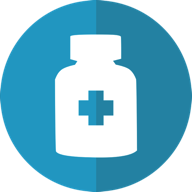
If you think determining the gluten-free status of food is difficult, try doing it with prescription medications! It's difficult at best to determine it by reading the ingredient label, and getting a pharmaceutical company to say if their product is gluten-free is like pulling teeth. Ugh...
The Food Allergen Labeling Consumer Protection Act of 2004 [FALCPA] requires packaged food items to declare wheat and other allergens, but medications do not fall under the umbrella of the FDA's rulings.
Medications contain the active ingredient, but generally it needs to combined with something else - something called an excipient.
What's an excipient?
It's a pharmacological term used for an inert substance that acts as a carrier for the actual drug itself [the "active ingredient"]. Excipients are also used as a filler to bulk up formulations to ensure proper and accurate dosages and as a binder [pill form].
For an extensive list of excipients, see glutenfreedrugs.com Excipients List; complete with descriptions.
Drugs.com has an excellent Inactive Ingredients page. Does not address gluten, but very in-depth explanations of each item.
Starches found in medications can include:
- Corn (most common)
- Cyclodextrins*
- Dextrates*
- Dextrin*
- Dextrimaltose*
- Maltodextrin*
- Modified Starch*
- Pre-gelatinized Modified Starch*
- Pre-gelatinized Starch*
- Sodium Starch Glycolate*
- Starch*
- Tapioca
- Wheat
Since drug companies don't have to disclose source of the starch, there is no easy way to tell if certain ingredients are gluten-free. Calling the manufacturer is the only [and best] option.
Common gluten-free excipients include*:
- Acacia
- Alginic acid
- Alpha tocopheral
- Ascorbic acid
- Benzyl alcohol
- Calcium carbonate
- Carboxymethylcellulose
- Citric acid
- Corn starch
- Croscarmellose sodium
- Dextrose
- Docusate sodium
- Fructose
- Glucose
- Hydrogenated vegetable oil
- Hydroxypropyl cellulose
- Lactose
- Magnesium carbonate
- Magnesium stearate
- Matitol
- Maltose
- Mannitol
- Microcrystalline cellulose
- Polydextrose
- Povidone
- Propylene glycol
- Silicon dioxide
- Simethicone
- Sodium benzoate
- Sodium lauryl sulfate
- Sorbitol
- Stearic acid
- Sucrose
- Vanillin
- Xanthan gum
- Zinc stearate
Cynthia Kupper, RD (Executive Director of the Gluten Intolerance Group) states that patches, inhalants, injectables, and liquids/elixirs are not problematic for those following a gluten-free diet. Source: HealthNow's 2010 Gluten Forum DVD
Contained in GIG’s Medications and the Gluten-Free Diet PDF, is a larger version of this pharmacist-created flowchart to aid in the determination of a gluten-free medication.
Here are a few other links of interest:
Bills like this have been submitted since 2013, but they never saw the light of day. Please contact your senators and congressional representatives to let them know this bill is important to you. Find your Senators and Congressional Representatives.
Note: Due to the article's age, any brand name products that are stated as gluten-free, should no longer be considered GF. It's my opinion that any published list of gluten-free products, should not be blindly followed. Since manufacturers can change the ingredient list without notice, the product needs to be verified with each purchase.
Once a pill has been identified, additional information is provided, including brand/generic name, ingredients, and the National Drug File identification number.
Sadly, NFCA no longer offers a free online continuing education program for Pharmacists. However, a PDF is still available: PDF for Pharmacists.
HR 2003: Gluten in Medicine Disclosure Act Update - November 2013:
http://celiac.org/blog/2013/11/06/hr-2003-gluten-in-medicine-disclosure-act-update/
Hopefully you and your Pharmacist find this info helpful.
Al
update 04/29/21 - Add Gluten in Medications Act info.
update 01/12/21 - Update GIG links and graphics. Update links.
update 12/14/19 - Added Gluten and Generic Medications Article
update 04/09/19 - Added CDF Gluten in Medication Disclosure Act of 2019 info.
update 01/12/19 - updated excipient list and note updated GIG’s Medication and the Gluten-Free Diet info
update 09/02/18 - fix broken GIG Medications and Celiac Disease link.
update 01/20/18 - added FDA's Draft guidance document on GF drug labeling.
update 10/19/16 - added AllergicLiving.com's link
update 10/31/15 - Updated GIG's Celiac Disease & Medications link
update 09/12/15 - Added Living Without's - Gluten-Free and More article "Gluten in the Pharmacy"
update 05/13/15 - Added Living Without's - Gluten-Free and More article "Allergens in your Medication"
update 02/23/15 - Added Medscape article "Medications and Supplement Use in Celiac Disease"
update 02/13/15 - Added med research sites and Gluten in Medication Webinar/slides
update 07/29/14 - Added CDF link
update 05/25/14 - Added About.com article.
update 05/25/14 - Added PracticalGastro 2008 & 2009 articles.
update 05/25/14 - Added Delight Gluten-Free Magazine article.
update 03/18/14 - remove link to GREAT Pharmacists training - add link to corresponding PDF
update: 12/14/13 - updated link to GIG's Medications & Celiac Disease educational bulletin
update: 11/9/13 - added Gluten In Medicine Disclosure Act info
update: 9/11/13 - added Living Without's Steven Plogsted interview
update: 05/03/13 - added more info on excipients.


